June 5
Because we are headed to Scandinavia this year, we decided to postpone our departure until the very end of May in order to coincide with the later spring in northern climes. We left Minneapolis with three 50-lb. suitcases (much of it books and maps and stuff requested by our daughter) and one 58-lb. overweight cooler on wheels, packed with what we trust is a repaired inverter-charger. As far as we know no one questioned this heavy piece of electrical equipment: at any rate, we took it off the baggage carousel in Oslo, without incident and with great relief.
We then stopped at the first ATM machine and picked up our first pocketful of Norwegian Kroner. Then we headed to the only Starbucks in Norway--conveniently located at the airport--and bought two pounds of coffee, two cups of coffee, one sandwich and one muffin: $56 worth. This will not be an inexpensive trip.
The train to Lillehammer was very crowded, but the cooler provided seating for quite a while. When we arrived, we learned that our son-in-law had tried to pick Rover up from storage for us, but the battery had been dead. So we headed directly from the train station to the storage building, only to find that Rover still wouldn’t start; nor did she on Sunday, after a whole day of charging. Houston, we have a problem and it’s not the battery. It’s going to be an expensive one.
And David hasn’t even tried to reinstall the inverter-charger yet.
June 7
Because Rover was stored in the dark back corner of a very large building, we needed to tow her out into the (never-ending) Norwegian daylight in order to let the mechanic get to her problem. When we did and he did, it took only a few hours to fix the gas line. This problem had been complicated by the fact that Rover had been sitting for 11 months with very little old gas. We had been unable to put her in storage ourselves last July since nearly everyone in Norway goes on vacation for the month. So our son-in-law had driven her to storage after the owner returned to unlock the doors. We had neglected to fill her with gas, let alone give him the Stabil we’d bought just for that purpose.
So after the fix, an oil change, and many Kroner, we were on our way to the tire store where we left even more Kroner. (How expensive is Norway? The country recently eliminated the “penny,” with the result that now their smallest coin is worth 16 cents!)
We were glad to get Rover back to our daughter’s home, which has a wide flat driveway/parking space. There we were able to unpack and David reinstalled the inverter/charger. It was (for him) no easy task, but it appeared to work just fine . . . for about an hour. We left everything plugged in hoping the electrical fairy would fix everything overnight. But she didn’t show up: our gauges looked exactly like they had last year.
We were about to call the local campground for an RV technician when our daughter remembered a lovely Irishman, trained as an electrical engineer, who now works in the North Sea oil fields. He was near the end of the “off” leg of his “three weeks on-three weeks off” stint but agreed to come over and take a look at Rover’s problem. After about two hours of trouble-shooting, he found a loose ground wire and a melted wire nut with an arcing connection inside the fuse/circuit breaker box. When he corrected those two items, all the control panel indicators glowed green and everything worked for the first time in a year! Not only that, he absolutely refused to take any money--so we left some with our daughter to buy him and his wife a very nice bottle of wine and resolved to be on the lookout for someone in need for whom we could be an angel.
Maybe, just maybe, we will be on the road tomorrow.
June 10
Driving Rover in Norway is proving to be easier than driving on the (rest of the) Continent or in Great Britain. The roads are usually a bit wider--and when they aren’t, they’re well paved and have reasonably low speed limits--and parking lots are comparatively huge. We left Lillehammer on the E6. “E” highways are Norway’s version of interstates, but just north of Lillehammer this E becomes two-lane, often with a double yellow line down the middle. There are a few places where one can pull over and let others pass, but the speed limit is usually 50 mph (and brutally enforced to the tune of $700 tickets), with the result that hardly anyone passes.
We had gone 11 miles when we hit our first construction detour. It took us through a couple of small towns and then back on to an E6 that was still very much under construction. We were following a large flatbed truck loaded with large drainage tiles. He pulled over and stopped; we pulled around him. It was about that moment Susan asked David, “Where is the southbound traffic?” Answer: It was coming directly at us on the single lane that wound through the construction zone. When the flatbed truck had stopped, it had been at a red signal light that he was blocking our view of. So within 20 miles of our first outing, we were backing up about 50 yards, pulling over out of the way, letting the southbound traffic pass, and then letting the truck and the other northbound traffic pass us--the light having turned green--after which we pulled in behind them all and continued on our way. Not a good way to start a trip--but it was all easily accompished with great aplomb on our part. And actually it was quite funny.
We got off the E6 and drove east on a smaller road. Even with the occasional 10% grade up and one 12% grade down, it wasn’t difficult, probably because there was virtually no traffic. We drove about 60 miles and met maybe 20 vehicles. For a while we were above the tree line, where snow lingered on the tops on low mountains.
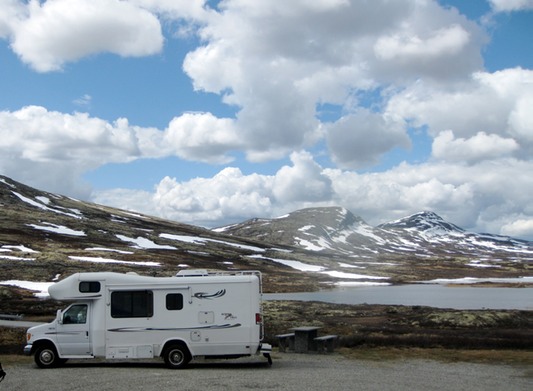
We passed lots of remote campgrounds and stopped for the night in Grimsbu, which appears as a town on the map, but consists only of the campground-with-restaurant, an ancient BP station,
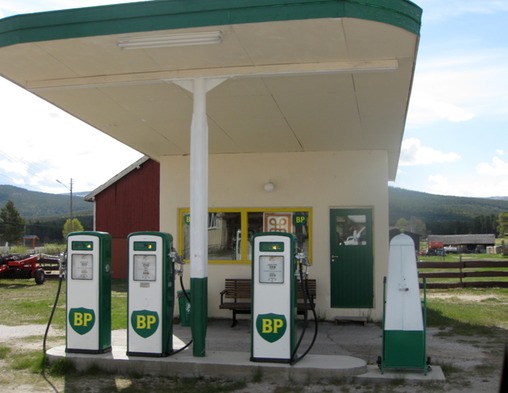
a Joker store (kind of a 7-11) . . . and lots of sheep. At the end of the day, we were blessed with a beautiful rainbow.

The next day we drove on to Røros, stopping on the way in a town with a Vinmonopol. The name is accurate: it’s a state-run store that has a monopoly on the sale of wine and hard liquor. Like any self-respecting monopoly, it sells its goods at very high prices. We bought a 3-liter box of their cheapest wine (the equivalent of four bottles) for $50. Yes, beer can be purchased in grocery stores, but it’s not the same thing.
Røros is a UNESCO world heritage site: a little town built next to and on a slag heap from copper mining, with a very impressive museum in some of the old mining buildings.
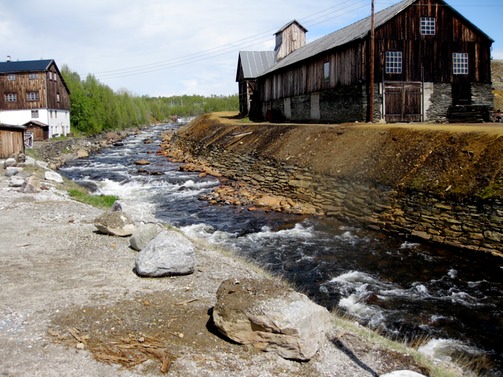
A women’s bike race had just ended on one of the main shopping streets in town, so there was a very festive atmosphere with lots of people, and stores stayed open on the pedestrian streets to accommodate us all. We camped in a small field adjacent to a hotel and several soccer fields. So far, campgrounds with electricity have cost nearly $40 a night. But Norway is prosperous and doesn’t need our economic aid, so we will be aiming for a free place when we get to Trondheim.
June 11
All in all, Trondheim has proved to be pretty easy . . . except for getting lost on our bikes. To begin with, the GPS led us to the city’s free “bobil parkering,” a nice big lot where half a dozen other RVs were already parked. Then we got our bikes out, re-educated ourselves on how to unfold them, carefully rode down a big hill on their very soft tires to a nearby gas station, filled the tires, and then headed further down the hill into the “sentrum”--about a 15 minute ride. Easy.
The old city center is an island, easily walkable and full of bicycles. Our first stop was at the Nideros Cathedral, Scandinavia’s largest church building. We were charged admission to enter, and the cloudy day didn’t do justice to the stained glass windows in the dim interior. But we also heard a beautiful choir performance that evening, sung without accompaniment in that massive, echo-y space.
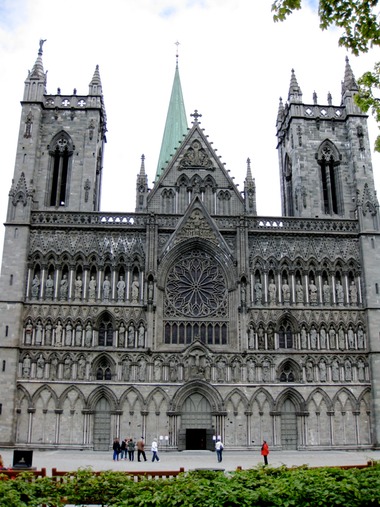
(If you've been following our blog for any length of time, you'll recognize this as the inevitable "cathedral facade" photo.)
Usually we don’t go out in the evening, preferring to be back to Rover by dark. But as far north as we are now, and as close to the summer solstice, there’s no such thing as “dark.” It was barely twilight by the time the concert finished at 9 pm. So we could easily see our way home even though it was the wrong way: our GPS still thought we were a truck and didn’t want to let us go on bike paths. And much of it was uphill (like all of Norway, so far as we can tell). As a result, the return trip was considerably longer than the one into town that morning had been.
Like most cities in Norway, Trondheim was originally built from the pine trees that grow all over the country . . . and, also like many of the nation’s cities, it has burned to the ground several times. After its last major fire, in 1681, it was rebuilt with wide streets, so it has quite a modern feel, even though many of the buildings are very old. It is also home to a large science and technical university, so there are lots of students around.
The next day we had no trouble driving all of three miles right through the middle of the old city to another “bobil parkering” even closer to the city center (no more uphill jaunts on a folding bike, misled by a GPS, thank you very much). This lot had no services, just free 24-hour parking, but it also was only a short walk across the river to the city. With no plug-ins, we had to depend on our batteries for 12-volt and 110-volt power both days, but so far they have held up well (of course, we have hardly had to turn the lights on).
We spent our (mostly sunny) second day in Trondheim walking the neighborhoods . . .
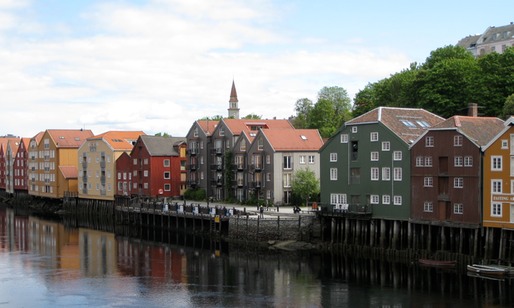
. . . visiting shops and museums and reading English language papers at the library. It is amusing to see streets and alleys and whole sections of town called Brattsomething: Brattorga, Brattorgt, Brattorvieta. . . . Trondheim is on a fjord, so there are plenty of seagulls. As we walked past an outdoor cafe, we saw one swoop down and take the last bite of bread off a woman’s plate. She was very startled and upset about this large scavenger literally flying in her face. (The bird, however, seemed rather proud of himself.) Later in the day as we were eating our sandwiches on a bench, we were circled by seagulls keeping a close eye on us--as we did on them. We knew enough to keep our food out of sight, but they didn’t leave until we had finished and disposed of everything. They were . . . intimidating.
The weather is cool and there’s often a brisk breeze: we wore gloves and headbands today, June 11. On the other hand, this is the first day since we got to Norway that it hasn’t rained even a little!
June 14
Trick question: which of the pictures below is of a Norwegian “E” highway, i.e., the highest designation, one of the roads than which there is no better?
This?
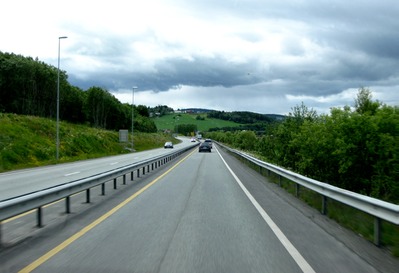
Or this?
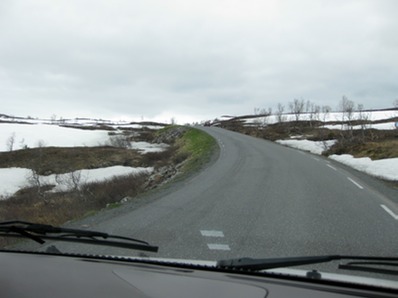
Answer: both of them.
The first one was taken a bit north of Trondheim, where the countryside is more densely populated; the second is of the road much farther north, where the promise of less traffic seems to have given the civil engineers license to let nature dictate not only the road’s direction but also its width, severity of ascent and descent, camber. . . .
For the first 240 miles north of Trondheim, the E6 is pretty easy driving: there’s a yellow line down the center, pull-over places, and quite a few small rest areas. Driveways and streets enter directly on the road, and there’s restricted access only in bigger towns (where one might actually want to access a gas station or grocery). There are narrow places and a few single-lane bridges, but generally, thanks to the spectacular scenery, it is a beautiful drive--at least for the passenger.
We followed along the Trondheimfjord and then through farm country that looked like Germany’s Black Forest. But the road goes mostly through pine forests and along lakes, rushing rivers and streams--RIGHT along the very edge of rushing rivers and streams--through a few tunnels, winding up and down a whole lot of big, big hills. We passed many motorhomes going south and often we went for miles without seeing anyone, feeling very remote.
We camped overnight in Mosjoen (pronounced sort of like “motion”) at a campground that boasted the first bowling alley we’ve seen in Norway. The next morning we continue our trek north toward our goal . . . the Arctic Circle. Ominously, the road begins to deteriorate: the yellow center line disappears, the severity of the winding and climbing and falling increase, the road is trafficked mostly by motorhomes and 18-wheelers. Sometimes there are guardrails, but mostly not. The only shoulders are on newly paved sections, which generally don’t amount to more than a mile or so. There is just barely room to pass at 40 mph. Then the pièce de résistance: work on a tunnel sends us on a 9-mile detour up and down a mountain. We pass a woman pushing her bike up the 9% grade.
At the Arctic Circle there is a tourist store, a marker, and a parking lot full of motorhomes. One had an Australian license plate, and we saw someone taking a picture of ours. The “Polarsirkelsenteret” is above the tree line and, appropriately, there was still snow on the ground. The temperature was in the low 50s so the snow was melting fast, filling the waterfalls and streams we had seen along the way. We took the necessary pictures,
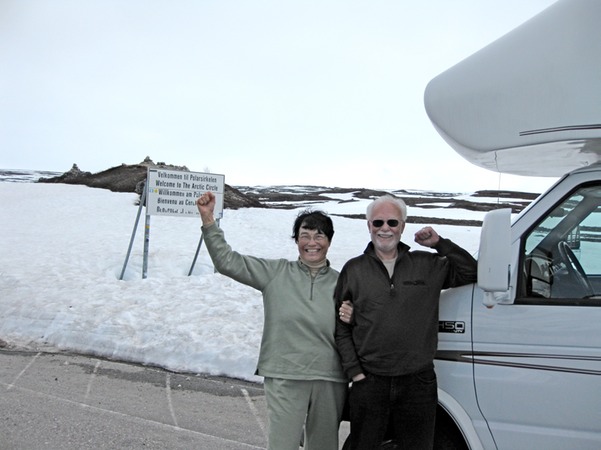
walked around the shop, bought the obligatory t-shirt and bumper sticker, had lunch . . . and then headed Rover back south, this time knowing exactly what kind of road we faced.
It was a beautiful drive through a bazillion spruce trees and birches, and we are glad we did it. True, with Rover getting 10 mpg and gas at $9/gallon, it was a pretty expensive side trip. But we can say, “We made it to the Arctic Circle!”
And so can Rover.
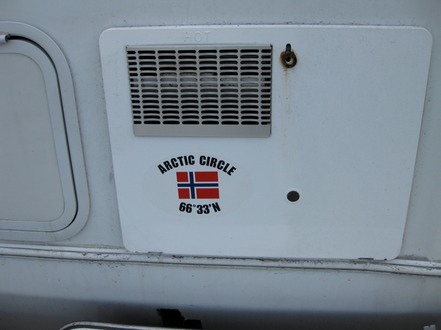
June 16
Trondheim to Kristiansund. We are headed for the west coast and then south. Kristiansund is a fairly large port city situated on three islands connected by impressive bridges and expensive tunnels (there’s a surprise). We have learned that motorhomes of 6 meters is the limit for the low tolls; we are 7.6, so we pay what the big trucks pay. We took our first ferry where the E39 ends at the water’s edge and continues on the other side of a 20-minute, $45 ride. By accident, we timed our arrival at the queue perfectly and waited no more than 15 minutes for the ferry. Everyone drove on and it left immediately: the toll was collected on the ferry. There were a couple other motorhomes and about 15 cars on our trip, with room for a least twice that many.
We headed to the city and to the campground just above it. Then we walked down to the active harbor where one of the huge Hurtigruten ferries was just arriving, with a band playing on one of its decks and hundreds of passengers taking in the view of the city. But apart from that, Kristiansund was pretty closed up at 5 pm on this Friday night, so we made our way back to the campground.

When we write “Friday night,” of course we don’t really mean “night.” The sun dipped below the horizon around 10:45 pm, after which the sky remained twilight all night long. Some evenings we will be reading and suddenly discover that it is well past our bedtime. And, of course, if we wake up at 3 or 4 am, the sun will be shining already. Rover’s day/night shades are definitely not of room-darkening quality.
Because we were parked right next to a water spigot in the campground, Susan gave Rover a one-pail-of-water bath, and when we filled our fresh water tank she got a quick rinse (Rover, that is). Generally, washing motorhomes is forbidden, but we did it anyway. Worse yet, this bath required David’s sacrifice of a 23-year-old RAGBRAI t-shirt.
Then we took off for the five mile tunnel under the fjord and headed south to the Atlantic Road and its seven bridges. It proved to be well traveled and not at all intimidating. Because we had not been able to get a picture of Rover in front of the Eiffel Tower or at Buckingham Palace, Susan was determined to get one of her (once again, that’s Rover) on the iconic bridge. Along with many others, we stopped at a pull-over spot and then David drove over the bridge to the next turn-around while Susan took pictures. Then he actually returned for her (!) and we continued south.
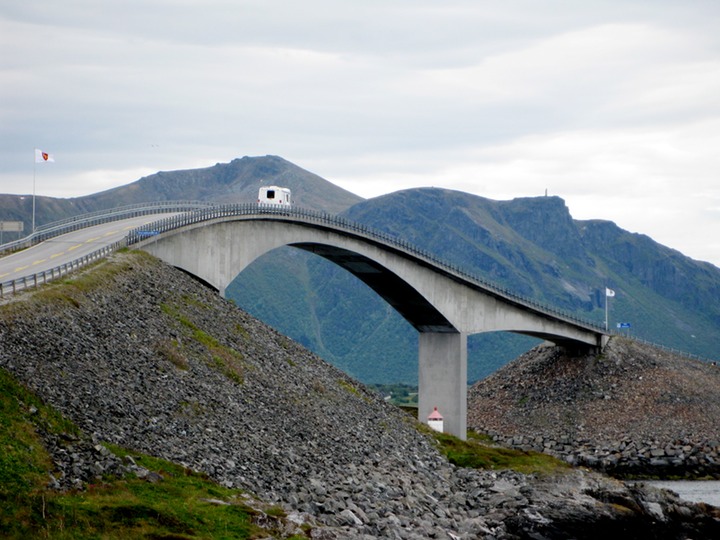
The roads have been good and the traffic light. This was a fairly short day of driving, ending up in Molde at the best campground yet. We are right on the Moldefjord, looking out at the mountains where we are headed next.
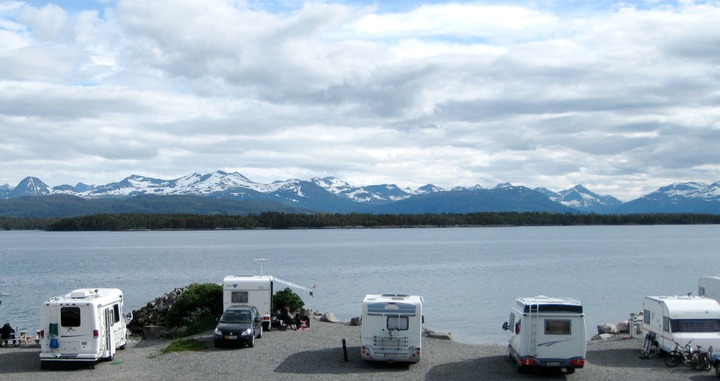
June 18
Before we left Molde, we decided to use the campground’s new sanitary dump. It would have easily accommodated Rover’s American-style discharge equipment, but the space was surrounded by low bushes and despite several attempts there was no way we could maneuver into it. So we gave up on that plan and made our way to the ferry dock.
We timed it perfectly. All the other vehicles had been loaded, and the crew was about to raise the ramp when they saw us coming and waited for us. We drove right on and the boat was moving within a minute. Then it was off the ferry and across hillside farm country to the city of Ålesund. The GPS gave us an interesting and totally unnecessary route to a “bobil parkering” right on the waterfront. It is an unstaffed place with free showers, toilets, water, and dump, but no electricity. We are among about 20 other motorhomes. Rover’s front end is less than 10 feet from what our (Norwegian) road map calls the “Norwegian Ocean.” And we are literally just a couple of blocks from the city center. It is a great place to be . . . if only it hadn’t been so difficult to get to.
Ålesund is a lovely town. It burned to the ground in 1904 and was rebuilt in a few years in the Art Nouveau style. All the buildings in the city center are now brick or stone, most with some lovely detail in their design.
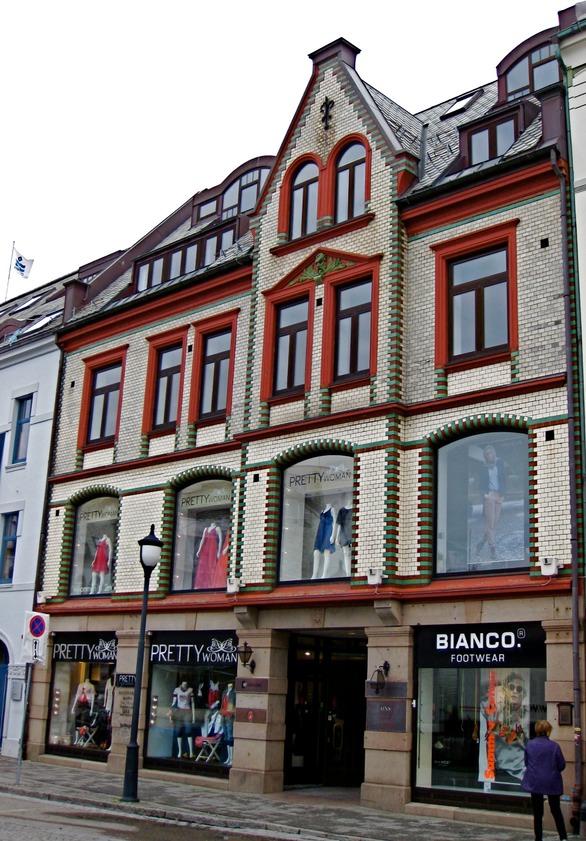
We took a “train” tour (the wheeled variety) through the city and up a hill overlooking the town. We also walked the streets and toured several museums. In one we saw a replica of the 18-foot enclosed lifeboat “Uroed” that crossed the Atlantic Ocean with four men in 1904.
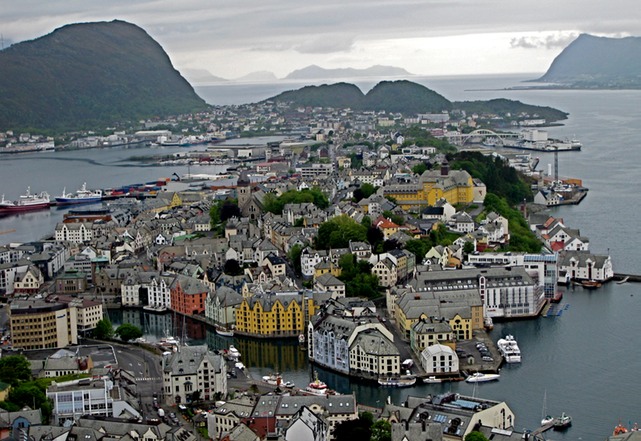
A clerk in a store told us they are having the same weather now that they had in January: she called it “a green winter.” It has rained off and on since we arrived here, but the only heavy downpours have come after we have returned to Rover. As today’s rains fall, we can watch the ferries and fishing boats pass directly in front of us.
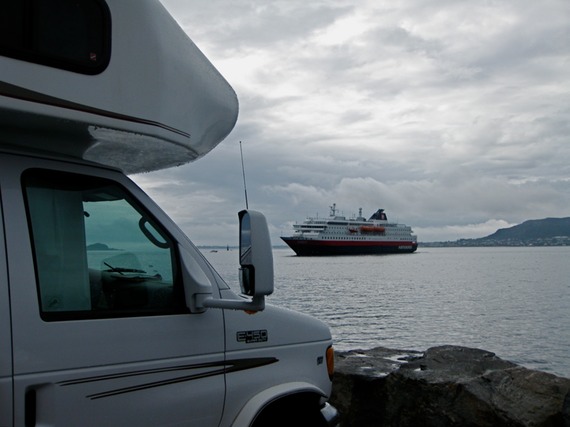
June 21
Today we made a bus back up. Tour buses are the bullies of the Norwegian roads: they know where they are going because they have been there before so they drive fast, they take turns wide, and they often roam in gangs.
We had made our way to Hellesylt, a small village on the (we are continually assured by the travel brochures) “world famous Geirangerfjord.” The road to the town was remarkably good until we came to a very dark, narrow, loooong tunnel. It was an old one, and (like many of a certain age we could name) it was dim, dripping water . . . and going downhill fast. Fortunately, we met only two cars in it. It spilled us out into an incredible view of the fjord that we scarcely had time to look at before the road sent us through two more short tunnels and into Hellesylt. There we found a bank, a woolen goods outlet shop, two grocery stores (right next to each other, as we often see in Norway), a ferry port, two souvenir shops and a campground whose owner shows up for an hour at 8 pm. We stayed there for two nights.
The next day, leaving Rover in the campground, we took the ferry tour along the fjord to the tourist trap town of Geiranger. The views are indeed magnificent.
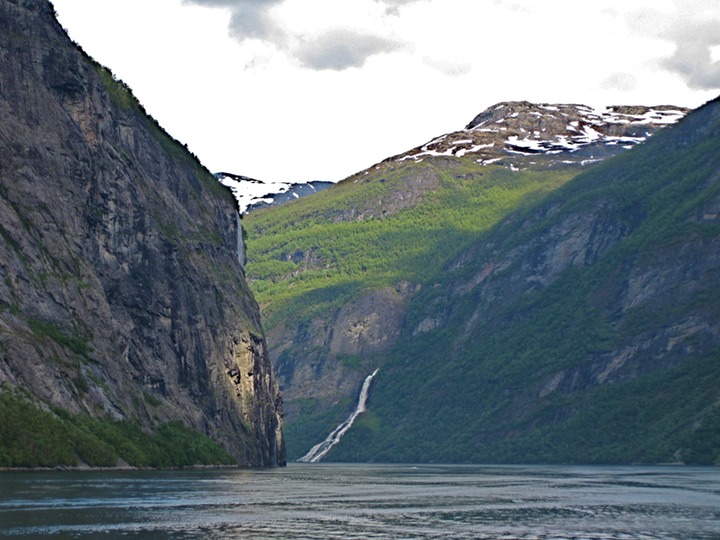
The town was comfortably full of tourists disgorged from two large tour boats in the harbor, and we counted 50 motorhomes that, unlike us, had dared to drive mountains and hairpin curves to get there. In addition to the souvenir shops there was a very good museum half a mile up the hill that we trekked up to in the rain. We took the ferry back to Hellesylt for the night, and today we headed south.
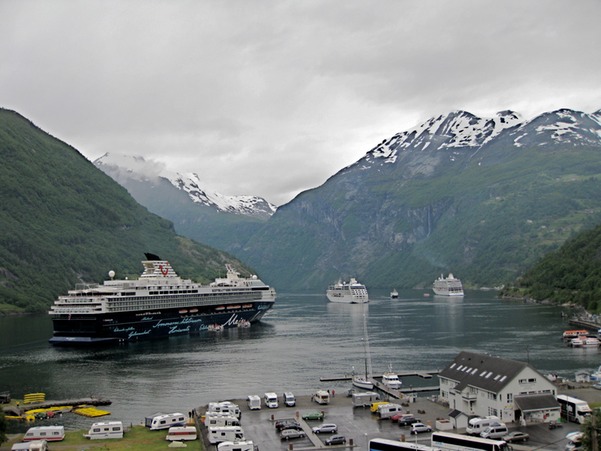
Today’s adventure was a 9-kilometer stretch of very narrow road. True, it had many pullover spots, but you have to hit them right: they do you no good if you’re between two of them when the truck is coming at you. Fortunately, traffic on this stretch was light, but at a construction site, after we had wormed our way through a single-lane detour, we were met by a tour bus that had pulled up so far he couldn’t be bothered to give us full access to the road. We couldn’t back up; he shrugged sneeringly, as if to insist that he could hardly be expected to, either; finally, though, he relented and did.
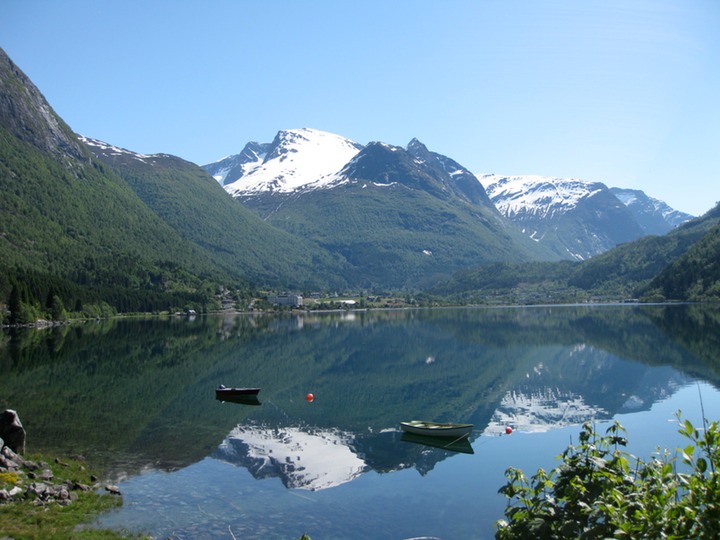
Then the road went up and up with several hairpin turns before descending for miles at an 8% grade into Byrkjelo, a little village with a nice campground. We decided 67 miles of these roads were enough for today.
And then the sun came out!
June 23
For the past two days we have been surrounded by incredible natural beauty. The road we took south through the Vatedalen Valley rivals the Geiranger fjord in landscapes. Probably the only reason it is not inundated with tourists is that, unlike fjords, it is inaccessible to 3000-passenger cruise ships. The views were stunning and varied: sheer rock walls, farms, waterfalls, racing streams, forests and lakes . . . and all with good roads (the kind with yellow lines down the middle!) and only a few tunnels.
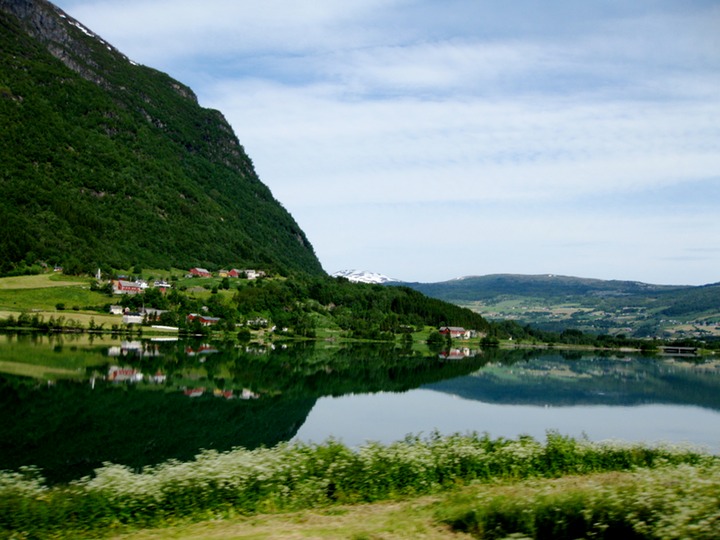
We passed what looked to us like a glacier and then, as confirmation that we’d been right, stumbled upon the Norwegian Glacier Museum. Its exhibits were wonderfully well done. Like another museum we visited recently, this one had beautiful movies without any words--only music. This is a good solution to the problem of addressing the great variety of languages among the tourists visiting Norway: the pictures really do speak for themselves.
Recently, no day of driving has been complete without at least a minor adventure: thus, as we made our way into Sogndal’s town center and looked for the “I” (for “tourist information”) sign, the only one we saw directed us onto a road--a road that soon became a narrow track--a track taking us away from and far, far above the town center. There was no way to turn around, so we just had to keep going, accompanied by David’s curses at each turn, bump, blind driveway. . . . Eventually we were dumped onto a more heavily trafficked road that led us back to the city. We finally found a place to park and walked to the tourist office (in the center of town, of course--oblivious to all around us, we’d passed within 50 meters of it at the beginning of our tour of Sogndal’s suburbs). In impeccible English, the young woman at the desk acknowledged that, indeed, the sign whose directions we had followed was no longer correct. She got on the phone to express her chagrin on our behalf to somebody upstairs.
We camped there anyway.
The next day we drove only a few miles north to take a 15-minute ferry ride to Urnes. As we’ve grown to expect, the secondary road from the main road down to the ferry was about a mile and a half of narrow, winding descent with some hairpins, blind turns and, once, barely a single lane.
Leaving Rover in the small parking lot, we took the ferry and walked up the 1 km hill to the Urnes stave church, built in 1130.
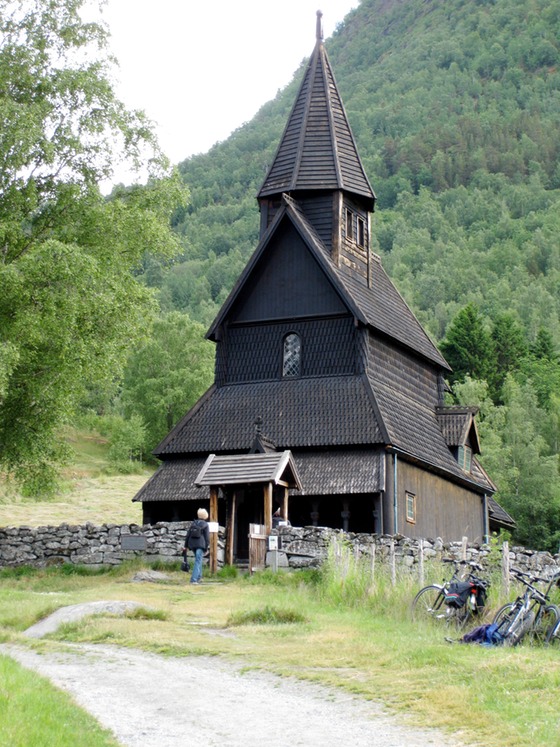
We barely beat a tour bus to the spot, took the tour (again delivered in impeccible English) and had a much easier walk down the hill to catch the boat back to Rover. The bus full of lazy tourists made it onto the boat with us, so we decided to tag along behind, back up the hill, and let it clear traffic for us. A good strategy: we met three cars and three motorhomes, all of which pulled over and stopped to let the bus (and us) go by.
Then we drove on to our next ferry (“Do they never cease?” you ask. No, they don’t--at least, not anywhere near the west coast of Norway). We didn’t time this one particularly well, but during the three hours we had to wait, we ate lunch, toured another 900-year-old stave church, and visited a ship museum right by the ferry dock.
The day was very cloudy, but the ferry to Gudvangen featured two hours of non-stop scenery. Even more important, it eliminated a lot of narrow, winding roads for us. It rained on the way, but these big boats have comfortable salons with large windows, so we stayed dry and enjoyed the view. As we passed a wedding party being photographed on a dock, the captain blew the ship’s whistle to them.
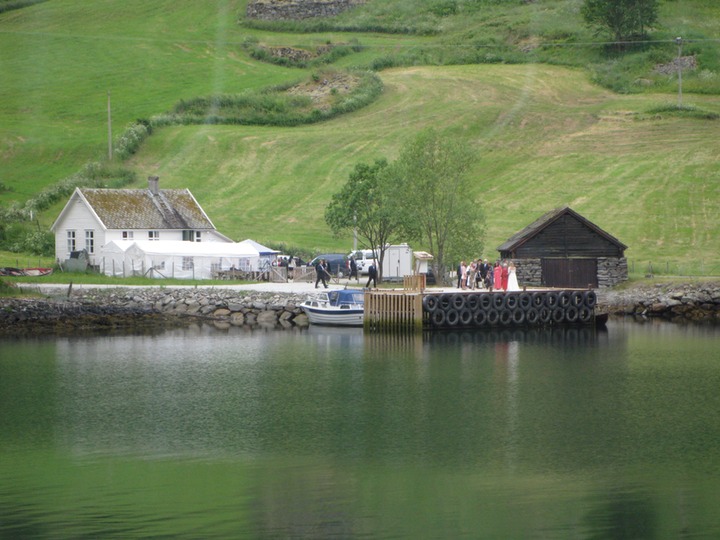
Gudvangen is only a ferry dock, a few houses and a campground, but all of it in incredible surroundings. We stayed two nights, using the location to take a bus to Flåm and avoid driving through 12 miles of tunnels, but when we arrived we saw many motorhomes whose drivers apparently don’t mind going through long tunnels with lots of bus traffic.
Flåm is another major tourist attraction, and they do it well. It is home to a famous mountain train that connects with a line running between Bergen and Oslo. However, like most of the passengers, we took it to the end of the line and back again for the sake of its spectacular views.
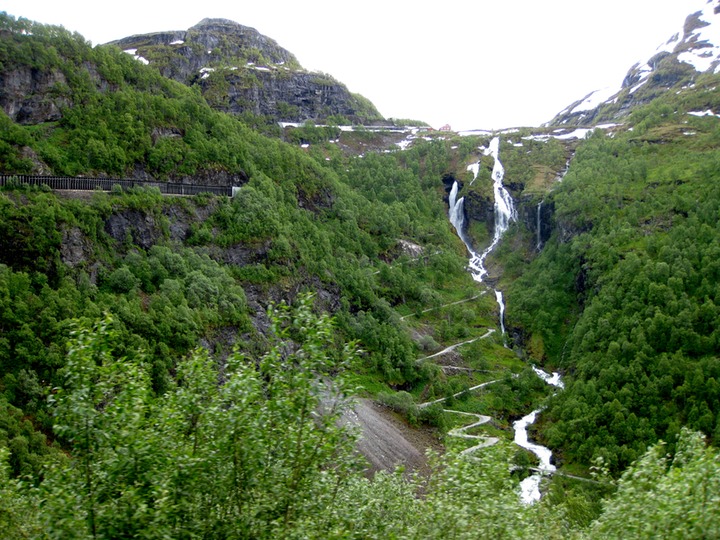
On the way up, there was hardly anyone in our car; on the return, though, the train was full of people, many of them Japanese tourists, nearly all carrying expensive cameras
June 26
We picked the wrong time to make our way to Voss: the week of the annual Extreme Sport Festival. We got the last spot in the campground, which is perfectly located for a visit to this town: in a park on the lake, only three blocks from the city center. But even empty it would have been a tight fit for us, as the spaces are short and close together. This week, every speck of grass had a tent on it and every tent came with a car with a kayak or some other piece of equipment attached. Some neighbors moved a car so David had a better shot at backing into our space. The place was full of young athletes and their friends. A huge festival stage and tent had been erected about a block away, so we knew we were in for a late night since the party started at 9:30 pm. But . . . location, location, location: any other campsite was miles away and all the parking spots in town were taken.
The weather was perfect, so we got our bikes out, found the Folk School that our son-in-law had attended some years ago, and then took the cable car to the top of the mountain. From there we watched paragliders running down the mountain and hurtling themselves into space. The view from the top was beautiful on this clear, sunny day, and in the evening a sky-diving show brought a crowd to the park.
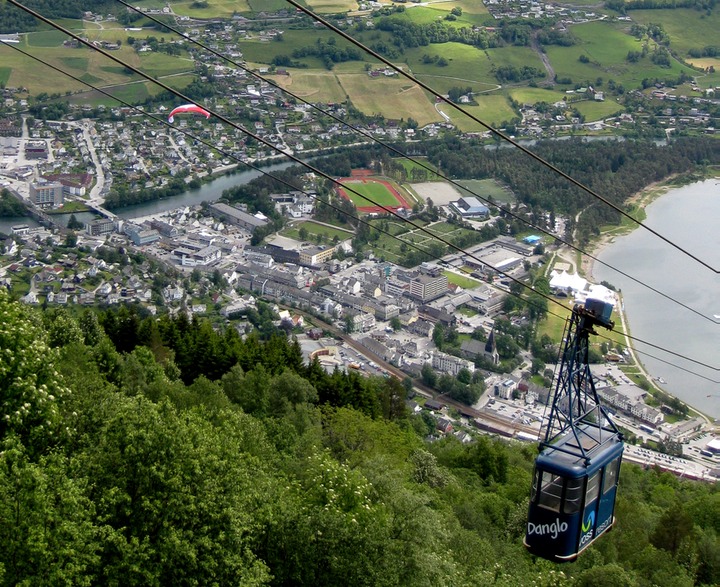
(Paraglider at 11 o'clock; festival tent above cable car; campground above tent.)
We survived the late night with the help of earplugs. Then we headed for Bergen, eager (!) to see what new driving adventure the day would bring. We had taken a good look at the map and decided against (what one map said was) a yellow road with scores of tunnels and instead chose (what another map said was) a red road that took a slightly longer route.
The GPS disagreed. “Make a U-turn,” it said. Usually when it tells us this, it adapts to reality after a few miles, mutters “Oh, all right,” and sulkily maps out the course we had decided on. This time, though, was different: after 5 miles of travel, the device was still insisting that we turn around...and then 10 miles.15….Worse, after those first 15 miles, we took a right turn and the road got really narrow and winding. David put up with this for 7 miles, meeting way too much traffic. “U-turn,” insisted the GPS; and “I told you so, but would you listen?” We finally conceded, turned around and made our way back through the 7 miles, including coming to a complete standstill once while a truck scraped by as we scraped our awning support on the stone ledge on the right. We made it back to Voss and went the other way--the GPS sniggering quietly to itself, but making sure we heard--on a road with a yellow line down the middle and through many tunnels.
(Truth be told, we don’t actually listen to the GPS; we muted its annoying voice years ago. But its screen still prints its messages to us, and “U-turn” is one it’s particularly fond of.)
The GPS brought us to an ugly camping place in Bergen, right on the water in an industrial area. Small and medium sized motorhomes are packed in here, and the place is full. Its sole virtue is that it is a very easy 30-minute walk over the bridge to the old city center. And since we bought the Bergen Card today, it will be a five minute bus ride to the city center for us. Location, location, location.
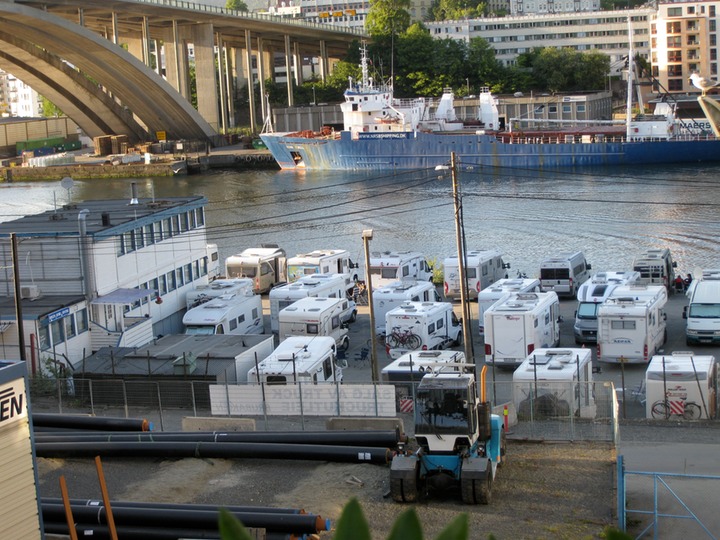
(We do wonder just a little what horrors awaited us on that road we abandoned.)
June 29
Bergen is a delightful city. Even though Rover was in a crowded, dumpy place, we felt comfortable leaving her for the whole day and going into the city. (We have rarely felt unsafe in any campground.)
Our own comfort is sometimes another matter entirely; witness this site’s ridiculous showers. There were two small shower stalls for men and two others for women, each with a door opening in and a second, hinged clear plastic door that took the place of a shower curtain. The arrangement would be impossible for anyone overweight. There was a hook for bags and towels, but one had to remove them before opening the door to put the token in the meter, cunningly located outside the stall (and costing $1.68 for 4 minutes of hot water). The water started running as soon as the token was inserted, so one had to shut the door, hang everything back up, and get behind the plastic shower door before actually beginning to take the shower. Although it was suitably clean and hot, it was, nevertheless, ridiculous . . . and not too refreshing. We skipped them the second night.
We had been warned that it would rain in Bergen, but we had three days of beautiful sunshine. The weather brought out all the locals and the tourists by the thousands (We counted five cruise ships in the harbor the first day). We bought 48-hour Bergen Cards and then did our best to get our money’s worth: museums, the funicular to the top of the mountain, a bus tour of the city, an organ concert at a church, a visit to an unadorned cathedral, stops at about 50 souvenir shops and markets. . . .
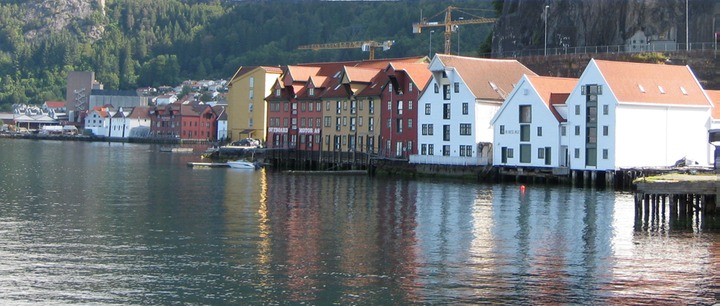
The city is a busy, bustling place. We especially enjoyed just walking through the old neighborhoods with their unique shops and houses.
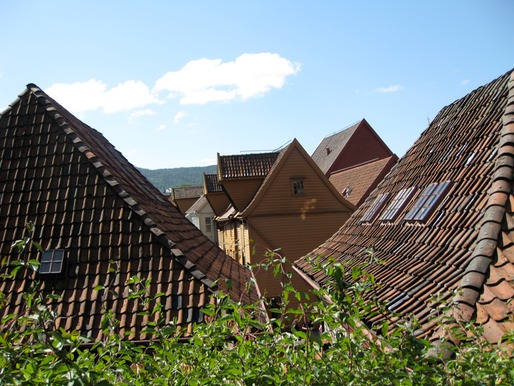
On the day we left we were concerned about how we would be able to get Rover out of the camping “lot.” When we had arrived, the middle one of the lot’s three rows was empty, but we felt we were too big for the marked spots provided, so we maneuvered into an out-of-the-way spot in a corner . . . after which, of course, the place filled up around us. On the day we wanted to leave, we were happy to find that a few RVs directly in front of us had left, so we were able to move Rover into another slot, from which we could just drive her out. Having moved her, we went back into the city for a while (It was just too easy to do with the free bus passes that were part of the Bergen Card).
After a visit to one of the oldest homes in Bergen, we drove only 12 miles to a campground where we had very decent showers, did some laundry and had wifi access. Susan was hanging the washing out to dry in the sunlight when our son phoned us from Washington, D.C., about the health care decision. So we used our (very expensive) wifi connection to listen to Talk of the Nation on Minnesota Public Radio for a while that evening,
And then it poured rain.
July 1
We moved on to Stavanger, a relatively easy 109 miles on the E39. But this main road ends too at the water’s edge. We had two ferry rides. Because this is a main road the ferries are very frequent: we had to wait about 15 minutes for one and drove right on to the second. When we were still a mile from the boat landing, we knew the ferry had just come in because car after car after motorhome after big truck kept coming toward us on the highway.
These ferries were just as fast and efficient as the ones before--and at a similar cost ($91 for one, $86 for the other). But we pay the price because there is simply no way to get down the west coast of Norway without using ferries.
Our campground in Stavanger was located close to the city center on a small lake. We easily biked into the city twice. The campground is a sloping field with quite a few trees and very few electrical posts, each one with half a dozen outlets. There were no clearly defined spots for RVs--people just parked anywhere they wanted--so when we told the woman in the office that we would like electricity, she told us to go see if any outlets were free. It was very different from a British campground, where every “pitch” would be laid out with geometrical precision and the office would assign campers to particular slots.
We did find some free electrical outlets, but it was difficult to find a place to park without being right on top of someone else (which is frowned upon). We parked just off a paved path and strung out our electrical cable a long, long way. It has rained several times since we arrived, and some of the campground has turned into a swamp, reducing the available parking places. We are amazed at the number of RVers who continue to come in late at night. We like to arrive plenty early to increase out chances of finding a spot open. (Also, we’re not on a tight schedule, so we can afford to quit driving early if we want to.)
We really enjoyed Stavanger. The central city, smaller than Bergen, is easily walkable. We toured five different museums, among them a surprisingly interesting cannery museum. Canning sardines played a big role in the growth of this city. Today, though, it is the new oil industry. So we also toured the oil museum, detailing Norway’s newfound wealth in the North Sea. All of this history has occurred since l969. Both museums were very well done.
We also attended a wedding at the cathedral, completely by accident of timing. There were 21 people in the pews, and it was obvious that some of the others were also tourists. A beautiful bride in a lovely white gown and practically nobody there--it was kind of sad.
Like many other Norwegian towns, this one burned down somewhere in its past. The old warehouses on the wharf that have survived are now restaurants and museums.
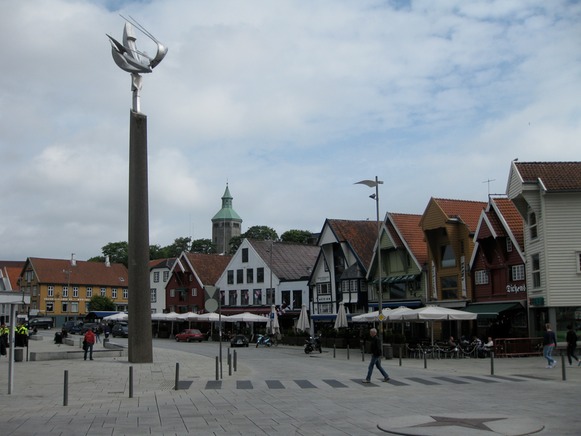
And one old section of historic small white wooden houses, some with lovely little gardens, still stands above the harbor. A young man was washing his little house and Susan had the nerve to ask him what a house like his might be worth--maybe 20’ x 20’ story and a half--and he said over $500,000. “Many people like to live here,” he said. It was a truly quaint street, like a movie set: not big enough for cars.
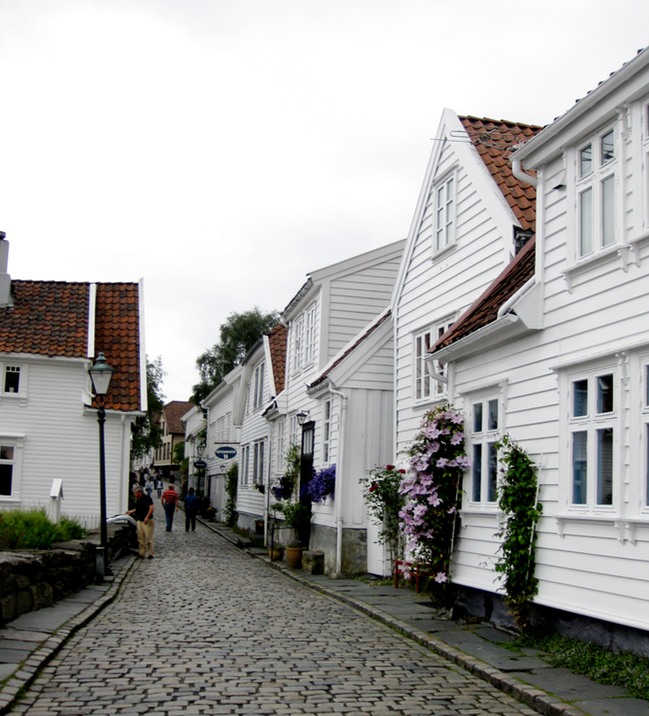
Like every other city we’ve been to in Norway, Stavanger’s businesses, except for restaurants, closed up at 4 pm, in spite of the fact that the streets were still full of tourists. And on Sunday, only the restaurants and some of the museums were open.
We walked the streets and visited shops and--the high point--we bought coffee from a real coffee shop. Our Starbucks had ran out long ago, and we had been unable to find good coffee at grocery stores. So when we came upon this shop, we asked for a dark roast, ground for a french press, and indicated the size of bag we wanted. When we got back to Rover, we figured out we had just paid about $25 for a pound of coffee.
We roughly added up our expenses for the month of June and found we are spending money at quite an alarming rate, compared to our trips in previous years. Campgrounds are regularly $45 and up by the time pay extra for electricity and showers and usually wifi, and if we eat out we are spending $70 or $80. We don’t do McDonalds--which are here, along with Burger King--but we don’t eat at the most expensive places, either. Our costs are mainly food, campgrounds, gas and museums, so it’s kind of hard to find a place to cut back.
July 3
We sometimes feel that we are other people’s entertainment, as they watch us try to back Rover into a tiny site or simply look us over, noticing the Minnesota license plates and especially the bristle “mud flaps” on the back bumper. But yesterday someone else provided the entertainment.
We were camped in a beautiful location in a campground that had only 13 sites for overnight touring guests. The other places were occupied by pretty old permanent small trailers used on holiday and weekends. Some of these are so permanent that they have little wooden decks built next to them: frames of 2x4s, covered with something like 1x6 lumber.
The day’s entertainers, an elderly Dutch couple, drove in, looked around for a place to park, and decided one of the unused decks was actually a parking pad. We couldn’t get out quickly enough to stop them; we could only watch as they drove onto the flimsy structure. The RV’s front end did quite nicely, but when the back tires got onto the wood, they very quickly went right through the deck to the ground. By this time the woman was climbing out and yelling (better late than never, we supposed), at which the old man backed up, ramming his way back over the edge. But of course, now the front end went down into the hole made by the rear tires, so a little more ramming--and ineffectually yelling--was required before they extricated themselves from the now-destroyed deck.
They then pulled up alongside it (as they were supposed to before--who says people don’t learn from experience?--but then decided they didn’t want to be parked next to a destroyed deck (who can blame them?), so they picked a spot to one side of their destruction, just behind us, where someone had left a dishpan full of plastic toys. The technique of leaving something on a site had indicated to us that another RVer had been there, reserved this spot, and driven off for the day’s sightseeing. Indeed, as we watched, we saw another camper, who had been incredulously watching all this, try to tell our heroes as much, but they ignored her, leveled their RV, and hooked up their electrics. Sure enough, about an hour later the couple who had reserved the spot returned and asked them to move, which they did, albeit with a bad grace.
As if that entertainment weren’t enough for one day, we found an unlocked WiFi network. The office had told us their WiFi wasn’t any good because of the mountains, but our mystery host worked quite well for quite a while.
And today, even more entertainment: we watched a family of six trying to position their trailer on a little knob of a hill. First they pushed it uphill by hand; then they voted (nobody found the location satisfactory); they pushed again, discussed and criticized, pushed….
We are in Kristiansand, Norway’s fourth largest city. The countryside here is rocky: big rocks, little rocks, small mountains of rocks, and the campground is a winding road going through low rocky hills. There are no marked sites. Our GPS was unaware that the gate it was directing us to had been closed, but a young boy on a scooter was eager to show us how to get in (his English wasn’t quite impeccable--he was only 8, after all--but it was good enough). The sign at the entrance said to find a place and come back to pay at 4 pm. This campground is about half an hour’s walk to the city center. We were surprised that it wasn’t crowded, since this is high season for Norway vacationers.
The cathedral here is only (!) a couple hundred years old. No marble or stone carvings here--it has a lovely folk feel--all carved out of wood. It is on the main city square, where construction and a children’s carnival were going on the same time. We thought we could hear what sounded like Native American drums and chanting, and sure enough, down the block some people dressed in leather and feather headdresses, and looking somewhat like Sioux dancers from Minnesota, were singing and selling CD’s and beadwork. (Disconcertingly, though, they were also playing what sounded like Peruvian flutes.)
Once again the were a lot of people in the streets; once again everything closed at 4 pm. This town, like many others along the south coast, has an old section of historically protected little white houses, here, though, with wider streets. Somehow having cars parked in front of them reduces their charm a great deal.
Because we decided we didn’t want walk all the way back to the campground, we found the tourist office, where we were directed to the bus stop. A helpful lady told us which stop was ours. It proved to be quite a long walk to the campground anyway, but at least this time we knew how to get back in.
July 6
The last few days seem to be repeating themselves. Each new town we visit along Norway’s south coast has an old section of little wooden white houses, an abundance of flowers, busy harbors and ever more beautiful views out to sea.
We stumbled into a free overnight parking place in Grimstad, a lovely town that claims to be the sunniest place in Norway. It certainly lived up to its reputation during our visit. As we approached the town, wondering where we could possibly park, we took a chance by turning at a sign that promised “parking.” Most often this tactic leads only to an impossibly small lot for small cars, but this time it rewarded us with a jettty featuring a “Motorhome Parkering 24 timer max” sign and space for five RVs. It was a great place to be: right on the water and right in the middle of everything. We enjoyed a visit to the Henrik Ibsen museum, set in the building where he worked for six years as a pharmacist’s apprentice. The original pharmacy still exists with its original equipment.

In the afternoon we stopped for coffee at the Cafe Ibsen across the street from the museum and used their WiFi to watch the Tour de France on our computer. The cafe closed at 4 pm (!) but they let us stay until they locked up, after which one of the waitresses gave us a bag of four large pastries that she said they would otherwise have to throw away. We then moved on to a bar, where for the price of nachos. salsa and orange pop we watched the end of the race on their wide-screen. Free parking, free food, free tv, sunshine . . . what’s not to like about Grimstad?
The great weather continued the next day, when we visited two more towns--two more neighborhoods of white houses, churches, harbors and market places. In one of them, we first found ourselves in a too tight parking lot too far from the “sentrum”; regrouping (and paying more heed to our GPS), we then made our way to one in the center of town where Rover’s back end hung out over the sea.
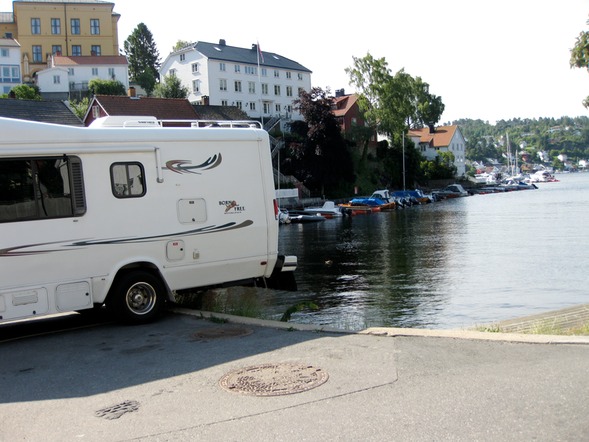
We are starting to see the influx of vacationers of which the guide books warned us. In Risør, many many large saillboats were gathering as part of some tour or another.
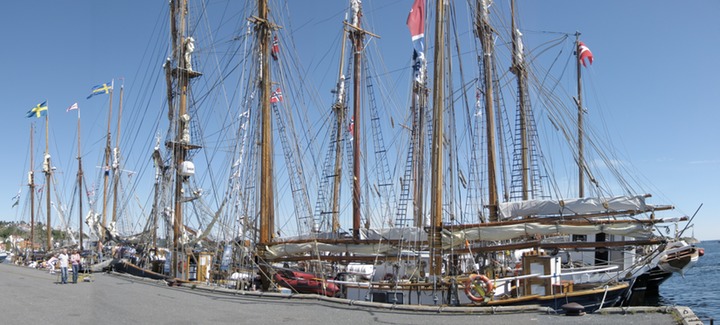
We’re also seeing the boosted prices that define high season: a night at a large family camping place, paying $66 for the privilege, and two loads of laundry (including only one use of the dryer) for $20.
The roads have gotten busier and also wider as we get closer to Oslo; we even get four lanes occasionally. We drove into Porsgrunn (where Susan successfully read a detour sign in time to notify the GPS) and visited the porcelain outlet. We also hit a second Henrik Ibsen museum--this time the farm where he grew up outside Skien. Norwegians are clearly very proud of their favorite son and do a really good job with these museums. The only thing they don’t do well is signpost to them: often we would see a sign at a traffic circle pointing us in the right direction, but then never see another at any of the next four crucial intersections; worse, the museum would not come up on the GPS. Finally we made our way to another museum in Skien, where the clerk told us how to get there. (The staff at the Ibsen Museum sympathized with us but blamed the local government bureaucracy for not dealing with the signage properly.)
Part of the Ibsen Museum’s program included a film about his plays which mentioned the Commonweal Theatre in Lanesboro, Minnesota, near where we once lived. But the narrator referred to it as “Lanesboro, Minneapolis.” Since this error is on film, that’s one correction that won’t get made soon.
July 7
We have been very fortunate with rain: it seems to come mostly at night. On Saturday we left the campground in a light drizzle, stopped for our first moose on the road, and spent the rest of the day in a mist that never quite managed to get organized enough to become real rain.
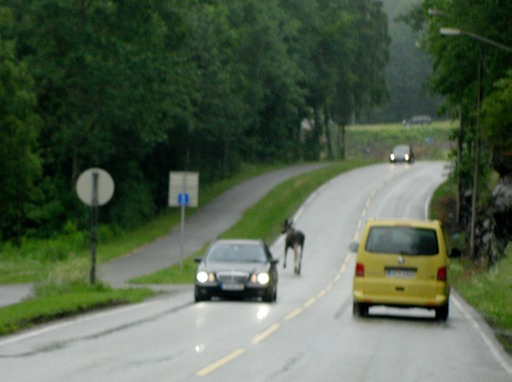
Arriving in Larvik, we first found a gas station to dump our full tanks and then once again stumbled on a motorhome parking place in the center of town near the water. This one wasn’t quite as pretty as Grimstad’s, but the location was good. It cost $20 to park there overnight, and it provided free electrical hook-ups and (for those who dared) a water hose. For a while we were the only ones there, but by the evening half a dozen others had come in, so between our fellow RVers and the raucous sea gulls, we had quite a bit of company.
Everything in this town was uphill, and at first we could find nothing of interest, not even with the help of a map. But by the afternoon we had been to a couple of museums and found the Thor Heyerdahl statue (facing away from the ocean for some unfathomable reason); later we just walked into a big hotel, found their large-screen tv in the lounge and watched the last hour of the Tour de France. No one else was around. Then it was downhill back to Rover, where we saved even more money by eating in.
We were wondering if the sea gulls would quiet down for the night when, at 10 pm, we were blasted with ‘50s rock and roll from a wedding party in a pavilion on the waterfront about a block away. We knew this would last quite a while and actually contemplated moving to a different location but decided to put up with it. When Elvis finally quit at 11:45 pm, we could hear music and a big bass beat from a club somewhere else. That went on for a long long time and we could feel the beat even wearing our ear plugs. Ah, memories of married student housing at UC-Santa Barbara, lo, these many years--nay, decades--ago. Eventually, though, we and the sea gulls all got a little sleep.
July 8
On Sundays everything (including many churches) is closed except for a few museums. Now headed north towards Oslo, we stopped in Sandefjord to see the whaling fountain and museum. Apart from a huge ferry just leaving for Denmark, the streets, parking lots, and sea were empty. Whaling used to be the economic engine of this town; now it’s ferries and tourists, but not so much of either on Sundays.

We had seen an advertisement for a Viking Market in Borre National Park. We couldn’t find it on the GPS or any map, but we did find a little town called Borre, so because we were headed in that general direction anyway, we decided to see what we could find.
We came upon hundreds of people walking from hundreds of cars towards something of obvious interest. So we drove to the next traffic circle and came back (we’ve grown to appreciate traffic circles just for this reason). While attempting to park, we found we were very close to a crowded campground, so we decided to stay there for the night. Then we joined everyone else walking to the Viking Market.
This proved to be a Renaissance Faire kind of thing with the emphasis on selling goods, located in a park that included Viking burial mounds and a museum on a hill. There were hundreds of tents--no Coleman tents here: all of them “the real thing”--crowded together under the trees along the fjord. They were selling anything that could possibly be considered Viking: leather goods, jewelry, clothing, yarn, toys, weapons, pottery.
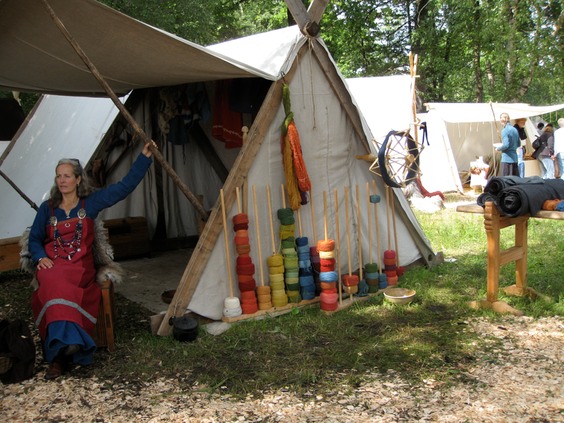
All the vendors and many of the visitors were in costume. People were cooking over fires, and there were a few fun demonstrations going on--all very festive and fun. It took us quite a while to take it all in. And not a single horned helmet or purple football jersey anywhere. We were glad to be close by in the campground when the whole thing closed down at 6 pm.
July 11
We have been dealing with rather weak internet connections and blog loading problems for a few days. It has been frustrating trying to resolve it all. We needed a good internet connection at the right time of day to make a phone call to our blog server in the US. One day we tried at a hotel while watching the Tour de France (2 Pepsis = $12) but didn’t get anywhere. The next day we found a cafe with free internet, but lots of noise from the street four feet away had David shouting into the phone (2 fruit smoothies =$16). So much for free internet, and who knows what the phone call to the US will cost. But we hope we now have the problem solved. (Please note that we uploaded three blog entries and ‘Things We Have Learned’ in one afternoon.)
Yesterday we left Rover in a parking lot in Notodden and took a bus about 45 miles on a road we didn’t want to drive. Our destination was Rjukan, the site of a hydro power plant at Vemork, where the Germans in WWII made heavy water for nuclear research. The result was a famous sabotage story, a pretty good movie, and (the town hopes) new life as a tourist destination for this now economically depressed region.
Rjukan is strung out for several hilly miles in a narrow valley, requiring us to take taxis to get where we wanted to go. This included crossing a very narrow bridge 84 meters above the water.
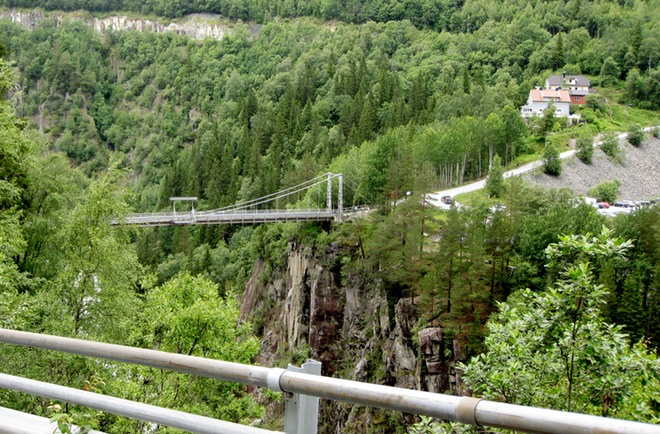
The town also offers a trip up the mountain in the oldest cable car still in operation (originally used to take laborers up to the sunshine once in a while, since the town gets so little). We are told you can see 1/6th of Norway from the top, but not when that top is covered in clouds, as it was during our visit . . . so we decided to skip that trip.
Today we first headed to Heddal to see the 800+ year old wooden stave church, the largest of the few remaining examples of these old churches. “Stave” refers to the large wooden posts inside that hold up the high roofs. They are just amazing structures. Like the others we’ve visited, this one was set in the middle of a cemetery with some very old gravestones.
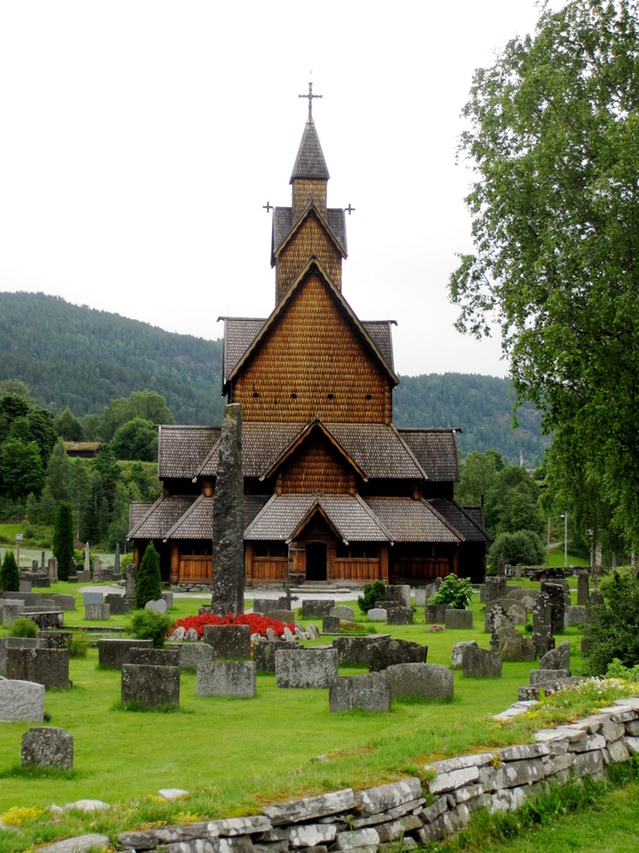
Then we drove on to Oslo. We managed to get lost when the signposts to the campground ran out well before the highway maze did, while the GPS directions resembled a pretzel. We went through the Operatunnelen three times in about 10 minutes--probably some kind of record, at least for an American-licensed vehicle. But we finally made it up the hill to the campground to find motorhomes and trailers parked any which way in a big wet field. We headed for the highest and driest point. We were lucky to find an electrical hookup, but our cord is strung out across a road. We didn’t go into the city because it was already well into the afternoon, we were tired and Susan wanted to do some laundry. Unfortunately, so did everyone else in the campground. By evening we were surrounded by other vehicles. A neighbor said there is space here for 700 but only 150 electrical outlets are provided. Worse yet, only three washing machines.
July 16
Oslo has been great fun: two days of mostly rain, followed by three days of sunshine. The campground remains a mud pit in places and we are amazed that people aren’t getting stuck as they leave or come in, dozens per day in each direction. We kept an eye out for neighbors leaving, and after the first night were able to plug in on our side of the road. On Sunday we discovered that in our absence, the electricity had stopped coming in, which scared us in light of our past electrical problems. But we think it may merely have gotten wet because it has worked fine after we reset the circuit breaker in the campground’s outlet box. (David was particularly relieved because the problem was on the level of the elementary sort of things he understands and can do something about with confidence.)
One of the worst things about this campground is the noise from neighbors (probably unavoidable when you’re alongside vacationers whose idea of a good time is to take the dogs along and let the kids run around outside until midnight). One of the best things is the easy access into the city center. Buses arrive every 15 minutes at a stop at the campground’s front gate, and 10 minutes later we are in the sentrum. We bought Oslo Passes which we thought would cost us $80 each but instead found we qualified for the “senior” (Pensioners) rate of $23 apiece. This gave us free access to transportation (including ferries) and most museums for three days-- a really great deal!
Oslo has proved to be better than we’d expected. The first place we visited was the new Opera House, its roof sloping into the fjord and inviting people to walk on it (as they do, in great numbers).
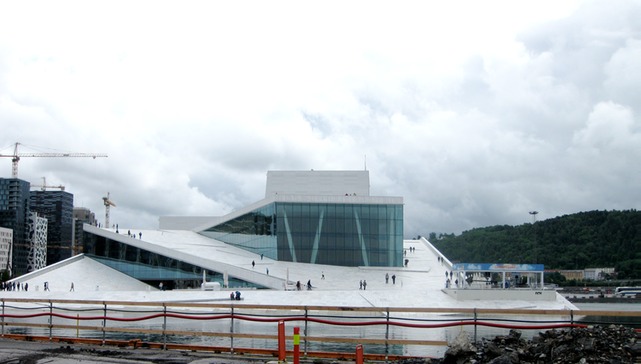
Of course, we also visited many museums, all of them very well done. We have seen Thor Heyerdahl’s actual Kon Tiki from 1947 and Ra II from 1970. We also saw three Viking burial ships more than a thousand years old--not only were the ships and the dead royalty buried, but also the everyday stuff thought to be needed for the afterlife: food, tools, household goods, clothing, sleds, horses! (And not a horned helmet among them.) The ships were huge--100+ feet long.
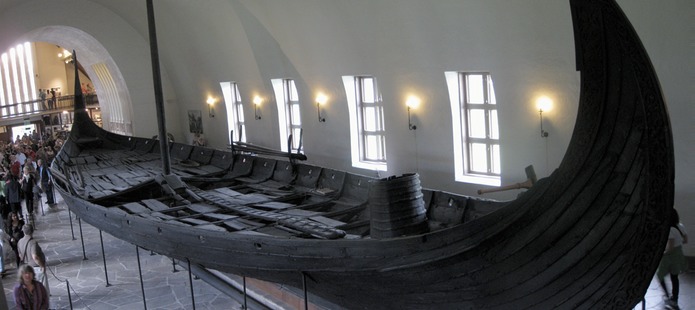
In another museum we were allowed on Roald Amundsen’s Polarship Fram--the actual ship, enclosed indoors--from his trip to the North Pole in l893-96. It spent three years trapped in ice (by design).
We also went to a third Henrik Ibsen museum--surely all that anyone, even theatre people, should be expected to visit--this one the apartment where he spent the last 11 years of his life. His study is just as he left it, including the portrait of August Strindberg over the fireplace. (Ibsen said he needed his rival’s “mad eyes” staring down at him to motivate him to write.) Since he was a wealthy man by then it was quite a well appointed place--just across the street from the Royal Palace. And of course we also visited the Vigeland sculpture garden, along with everyone else in Norway, who was glad to get out into the sunshine after a few days of rain.
We were thinking these had been pretty impressive days . . . but then came Sunday. We had saved a few free museums because our three-day Oslo passes had expired, so we first stopped at the Rådhus (city hall), not knowing what to expect. We were absolutely blown away. It is in this building’s great marble hall that the Nobel Peace Prize is awarded every year. The place is filled with painted murals that are just captivating. We decided it was the best part of the trip so far. (If you visit, it might be worthwhile to wait until a Sunday, when none of the other meeting rooms, also beautifully muraled, are being used for ordinary political business.)
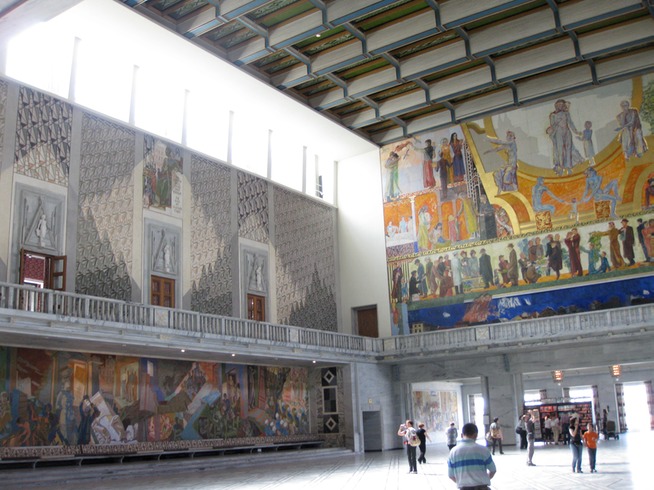
Three times we have been able to end our day in the city by finding a sports bar and watching the end of the Tour de France. It’s a great way to relax after being on our feet so much of the day. And that’s when it rained again today--while we were safely inside.
July 19
(Note: we've had some problems loading pictures into our "2012 Photo Album." Even now some of the navigation tools, like arrows at the tops of pages, are missing...but they will work, even if you don't see them. Just trust your cursor. And if you see a "?" instead of a picture on a preface page, click anyway--the picture will appear, we promise.)
We have crossed from Norway into Sweden, headed for Stockholm and whatever else we find on our way. At the border the condition of the roads immediately deteriorated some, but they are still wide and have generous enough shoulders to remain in the “good” category. The E18, the main road between Oslo and Stockholm, varies from 2- to 3- to 4-lane configurations with controlled access. The 3-lane version is interesting: the road will be divided, with two lanes assigned to one direction for about two miles and then to the other direction for another two miles. Faster traffic has a chance to pass once in a while, but at a considerable savings in construction costs compared to a 4-lane road. (And we have noticed faster traffic: we have been passed by more vehicles in one day on the two-lane portion than we were during a week in Norway.)
We have also found fewer campgrounds. The first night we stayed in a very large and very crowded family resort, where we were able to find a Swedish Campground guide in English that has been very helpful. We also picked up a Swedish/English dictionary. We had become quite comfortable with the few Norwegian signs we had figured out, but the Swedish ones are remarkably different. They talk funny, too (Swedes, that is, not the road signs). We had become accustomed to the softly bubbling Norwegian tone, only to hear the Swedish language kind of bouncing along . . . and we understand none of it. Still, it is remarkable how well a mono-lingual American can get along--English is just about everywhere.
We have also noticed that costs have dropped. We waited until we got into Sweden before buying gas and stocking up on groceries. Gas proved to be $8.11/gallon, compared to Norway’s $9.60+. Everything else also seems to be about 20% cheaper. And a box of cheap wine went from $50 to $19, so we will be enjoying wine again. (Unfortunately, we cannot stock up before returning to Norway: we are permitted to return with only 4 bottles or 1 box of wine.)
Our only excursion on the way has been a detour of a couple of miles from our second campground to see Picasso’s largest outdoor sculpture.
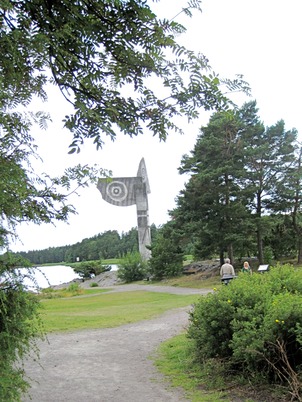
Turns out it was supervised, but not made, by him. Big whoop: Susan was more impressed with her first real (i.e., Swedish) IKEA.
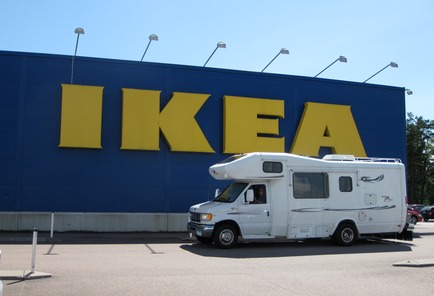
July 21
Before Norway slips out of our memory bank entirely--don’t laugh, it’s getting easier and easier for that sort of thing to happen--here’s a tutorial of miscellaneous notations for Americans driving around parts of Europe.
Followed, with your indulgence, by a rant.
1. The first bit of notation is specific to Norway and Sweden (and maybe Finland and Denmark, too, but we haven’t been there yet):
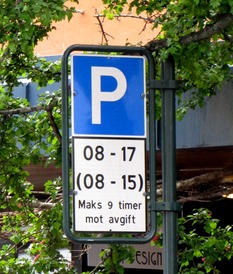
Numbers like these appear on parking signs and shop fronts; occasionally they’re even painted on buildings. They refer to things like a store’s opening hours or, as here, the times of day when you need to feed the parking meter. The first set of numbers refers to Monday through Friday hours; the second, in parentheses, is for Saturday; occasionally you’ll also see a second set of parentheticals for Sunday. (You won’t often see that second set in Norway because just about everything in the country is closed on Sunday.)
2. If you do find a grocery open on Sunday in Norway and make your way to the beer cooler, you may see this:
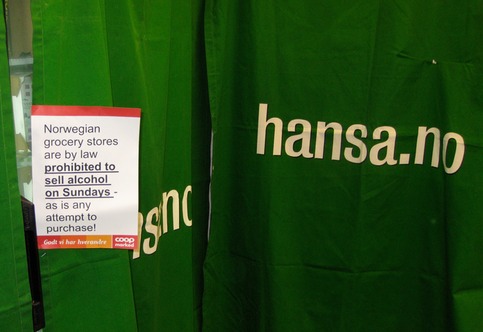
If the store is not in a high-density-tourist area, the helpful explanatory sign will be missing, leaving only the piece of canvas covering the beer cooler, as if to avoid taunting you with the sight of what you’re not allowed to buy on Sunday.
3. These next two are important, and they can be found all over Europe. They can cause more trouble than you might think, especially for American drivers, who aren’t used to them.
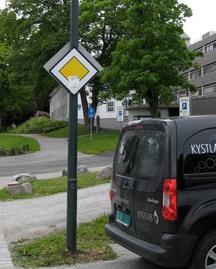
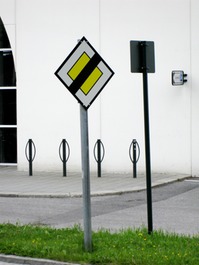
You’ll usually see the first sign (top left) along major highways. It means you are on a “priority” road, i.e., you don’t have to yield to traffic that is intersecting your road; instead, if the intersection is not controlled by a traffic light or a sign of some sort, you can drive through the intersection as if the other vehicles did have a stop sign.
And, after you’ve been driving in Europe and seen lots of black diagonal slashes on signs, you know that the sign on the bottom right one means you are on a “non-priority” road. Usually, you’ll see it on a highway that formerly had had priority status but has had that status suspended in a built-up area.
So what’s the big deal about non-priority roads? It’s this: when you’re on a non-priority road you are required to yield the right-of-way to any traffic entering your road from your righthand side.
The point of this practice, I’m told, is to reduce the speed of all traffic in a built-up area by making all drivers, regardless of the nature of the road they’re on, come to a stop when a vehicle approaches from their right (again, intersections controlled by traffic lights or some other signage are an exception).
One problem with this practice is that the poor driver--usually American--busily trying to cope with city traffic, pedestrians at crosswalks, signage in a foreign language, traffic signals in unfamiliar locations at intersections, etc., now has yet another thing to notice and keep track of: “Now I’m non-priority . . . OK, now I’m priority again . . . [crash] . . . oops, I guess I missed that last non-priority notice. . . .”
Another problem is that the whole system depends on every driver at an intersection knowing the “priority” status of every other driver’s roadway. If I’m on a non-priority road when I approach an intersection, my success at avoiding a collision may depend on whether I know the “priority” status of the guy approaching the intersection from my left: if (I know) the other road has priority, I yield; if (I know) it does not, I don’t; but (here’s the kicker) if I think I know but I’m wrong, there’s a 50-50 chance I’ll be pulling into the intersection in front of a driver who wasn’t planning to stop.
Happy motoring.
4. The Rant
Norway is justifiably proud of Henrik Ibsen. After all, the history books call him “The Father of Modern Theatre” (that should be “European” or “Western” Modern Theatre, but who’s counting).
And so:
--while he was living abroad for decades, building his international reputation by churning out masterpieces that trashed his native land for its philistinism and provincialism (and weather), his fellow countrymen bore it in silence;
--when toward the end of his life he deigned to return to Norway to live, they showered him with honors;
--when every noon he entered the Grand Cafe in Oslo for his customary midday meal, they rose from their tables and remained standing until he was seated (or so the waiter there assured us when we asked which was his table);
--at his death, they established three museums to him in places he’d lived around the country. (And, maybe most remarkably, they saw to it that the commentaries on his life and works in these museums were exceptionally insightful and the tour guides staffing them extraordinarily knowledgeable about his life and personality.)
--And, of course, they also erected his statue in front of the National Theatre in Oslo

and bade the artists working there keep his plays alive so that (as they love to point out . . . but modestly, ever so diffidently) he will continue to be the second-most-performed playwright--trailing only Shakespeare. And that, unlike the “Father of Modern Theatre” business, is not only in Europe or the West but throughout the world.
So then: Truly, Ibsen was a remarkable talent, and Norwegians are rightfully proud of his legacy and should do what they can to keep it alive around the land. Most particularly, they should do so at the country’s flagship dramatic institution, the National Theatre in Oslo (where they erected his statue, remember).
Ahem.
About that National Theatre.
But first, about Oslo:
Oslo is, of couse, the capital city of Norway, and many roads lead to it.
And Norway is one of the many countries in Europe that (virtually) shuts down during the month of July and sends (nearly) everybody off on vacation.
And because Oslo is the capital city and many roads lead to it,
--and because Norwegians are a really patriotic people,
--and also because Oslo is pretty far south (pretty far for Norway, anyhow), so the weather there might be expected to be warmer than most other places in the country . . .
for all these reasons, lots and lots of Norwegians spend at least part of their vacation … in Oslo.
(And lots of other Europeans come there, too, as well as quite a few Americans, because it’s a really lovely city, and because maybe they can learn somthing--you think?--from the people of Norway about things like . . .
oh, I don’t know . .
things like how to keep their citizens alive longer at less cost
and how to give science a leading role in establishing policies about their environment
and how to discourage drunk driving by taking away their licenses at the slightest whiff of alcohol instead of this “.06,” “ .08” crap,
and how to encourage healthy family life with maternity and paternity leaves at full pay and subsidized early childhood education and don’t get me started. . . .
(But I digress.
Where was I?
Oh, yes.)
So the point is--the points are--
(a) Ibsen continues to be really important to Norwegians and to the country’s cultural identity;
(b) there are hoardes of Norwegians in Oslo in July;
(c) Oslo is where the National Theatre, dedicated to the preservation of Ibsen’s works, is; and
(d) seeing a first-class production of one of a guy’s plays--instead of just reading it, say, or, God help us, being reduced to talking about it in a classroom--seeing a play is a really good way of coming to appreciate the work and how the guy’s mind works.
(Can you see where I’m going here?)
Conclusion: July would be an awfully good time for Norway’s National Theatre to be busy as hell, doing Ibsen plays as well as they can do them. . . .
But they don’t do it!
The National Theatre is closed.
And not just in July: it’s closed all summer!!
WHAT’S UP WITH THAT?
July 25
We stopped on the outskirts of Stockholm for two nights in a crowded little campground (“crowded” means we tried to put down our awning to keep out the hot sun, but it hung over the narrow paved road by about 3 feet so we put it right back up again--no British “3 meters between caravans” in Sweden, thank you).
We picked this spot because we wanted to visit the Drottningholm palace and the Royal Theatre, which were within walking distance of the campground. It proved to be almost an hour’s walk, but a nice one through the forest and around a lake. The palace is the actual residence of the current king and queen, but much of it is open to the public just the same. Its vast grounds were inspired by Versailles, so it was quite spectacular.
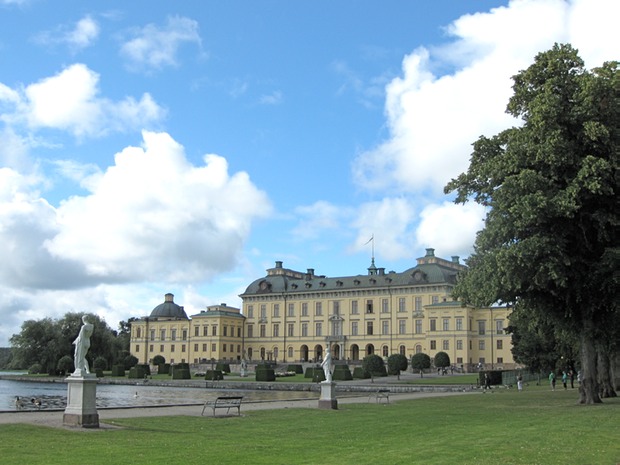
But the real charm was the Royal Theatre. It is 250 years old and had been used regularly for about 100 years until the death of the king who had been its biggest patron. The theatre was then closed down, forgotten for years, and rediscovered only in 1920.
Nearly all of it is still in its original, unrestored condition, including painted scenery hundreds of years old. We were able to take a tour but were not allowed to take photographs. The most interesting fact is that scenery onstage can be completely shifted within seconds--and in full view of the audience--by a team of stagehands under the stage. (They accomplish this by turning a large wooden drum, around which ropes, connected to scenic trolleys, wrap and unwrap [got that? any questions? yes, this will be on the test.]) The whole thing was worth the walk . . . but we took the bus back to the campground anyway.
After Drottningholm, we went to our reserved camping place in the city of Stockholm. Getting to it meant going across a narrow concrete bridge with the GPS (in red) telling us we were a truck and what did we think we were doing, using this bridge? But we could see 60 motorhomes already on the other side, so we went anyway. This campground proved to be another gravel parking lot with motorhomes just lined up in rows. The facilities were OK, except that we had no WiFi for four days. But the bus and subway connections to get to the city center only two miles from us were only a short walk away (when it comes to campground facilities, convenience counts for a lot more than luxury with us).
According to a brochure we saw, Stockholm has 84 museums; it also has wonderful little--and big--shopping streets. It was a very busy place, and the good weather brought out people by the thousands. Once again we bought the Tourist Card for discounts and free admissions, and immediately set out to get our money’s worth. We visited three or four museums every day, took a boat tour and had guided tours of the National Theatre and the Opera House.
But the winner was the Vasa Museum. The Vasa was a huge warship built in 1628 and fitted out with 100 or so cannons. On the day it was launched, amid much celebration, with His Majesty the King looking on proudly, the wind filled its sails . . . it listed to one side . . . water poured into the open cannon port holes . . . and it sank to the bottom of the harbor: all this within about 20 minutes.
It stayed on the bottom for 333 years, until 1961, when it was found by divers and the project to raise it began. This work took two years, but now it is preserved and in a museum, along with all the artifacts that were brought up with it (including several skeletons). Everything but the food, fabrics and some of the wood had survived: tools, household goods, weapons, even some leather shoes. The museum’s low lighting made for poor photographs, but it was an amazing sight.
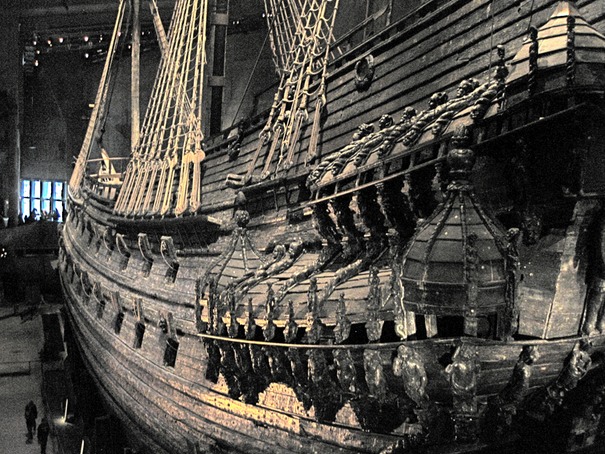
Susan has developed some stomach problems, but they haven’t really slowed us down much. Tomorrow the ferry to Finland will be a time to relax a little.
July 27
We left really early for the ferry to Finland, once again crossing the bridge forbidden by our GPS, and driving less than two miles to the landing. They offered us use of electricity on board, which we gladly accepted: since we had to have the LP tank sealed in the “off” position, not having electricity would mean the refrigerator would be off or running on battery power for the twelve-hour trip. But when we returned to Rover at the end of the voyage, we found that something had tripped the main circuit breaker, and those few battery lights that remained were glowing red. (Surely there’s a moral to this story, but we don’t know enough about electricity to figure out what it is.)
Susan slept for ten hours of the twelve-hour trip and found a bit of time to look up her intestinal problem on the internet. It was just enough information to get her really worried. With a little help from the Viking Line information desk and a call to the US Embassy in Helsinki, we were instructed how to get to a hospital emergency room in Turku. So within 15 minutes of driving off the ferry, we were sitting in the waiting room, with Rover parked in a perfectly level and mostly free parking lot.
They did some blood tests, gave her some meds and told her to come back in the morning. So we stayed right in the parking lot overnight, running the engine for a while to bring the batteries back. In the morning they took x-rays and then transfered her by ambulance to a bigger hospital, where she had a CT scan and was admitted with a severe kidney infection. Rover is staying put right in the first hospital’s parking lot. Not at all what we had planned, but all part of the adventure.
August 1
After four days in an isolation ward, Susan was finally released from the Turku University Hostpital with a functioning digestive system and a box full of antibiotics. (We are not any lighter in the wallet, though; they will send a bill to our home address in the US.) We immediately drove the 100 miles to Helsinki, got stopped in an hour-long traffic back up, and easily found the campground.
This is quite a nice place with large sites separated by flowering hedges. We immediately did two loads of laundry ($6 to wash, $6 to dry = $24). This was the first time we had been able to fully plug in the electricals since the power problem on the ferry, and we were relieved to find everything working properly.
In our limited touring of the city today, we had one really lovely moment. We had arrived at the Helsiniki (Lutheran) Cathedral just as a short English prayer service was ending. The fifty or so people there, some seated, others milling (quietly) about, still others standing still, received the blessing; and then the pastor invited us to sing together “Now Thank We All Our God.” We may have been the only ones who sang with her, and Susan was certainly the only one who knew all three verses (David almost did). That was the song we sang at our wedding some 45 years ago.
Tomorrow we leave for four nights on a side trip, by ferry, to St. Petersburg, Russia. Rover and the computer will not be accompanying us, so we want our fans--among whom you, dear reader, are chief--to be aware that we will not be posting for a few days.
August 6
This post has virtually nothing to do with camping in Europe. It is, rather, a brief description of our brief trip to St Petersburg, Russia.
Leaving Rover and the computer behind in the campground in Helsinki, we took an overnight ferry to St Petersburg. Before leaving the U.S., we had purchased a tour that allows entry into Russia without a visa for a 3-day stay with a firm exit date. It didn’t offer a way through customs, though, so after an interminable wait in that line, we were met by our young guide, Anna, and a driver and given a three-hour car tour of the city. It got us oriented, and we also received good advice about how to get around in the city. So after Anna dropped us off at the hotel in the early afternoon, we immediately headed for the ATM machine in the lobby, took out 1000 Russian rubles . . . and when we got to our room, we figured out we had just gotten the grand sum of $30. So on our way out, we got another 6000 rubles and left for the subway and the central city.
St. Petersburg is remarkably clean--even the heavily used subway, which had the longest escalators we have ever seen: fully a 2-½ minute trip from top to bottom. Many of the buildings are beautifully decorated, and the bright colors of their facades surprised us. But up close, most look to be in need of plaster repair and a fresh coat of paint. Every one has several large downspouts painted to match the building. Susan finally stopped and measured one: 8-½ inches diameter.
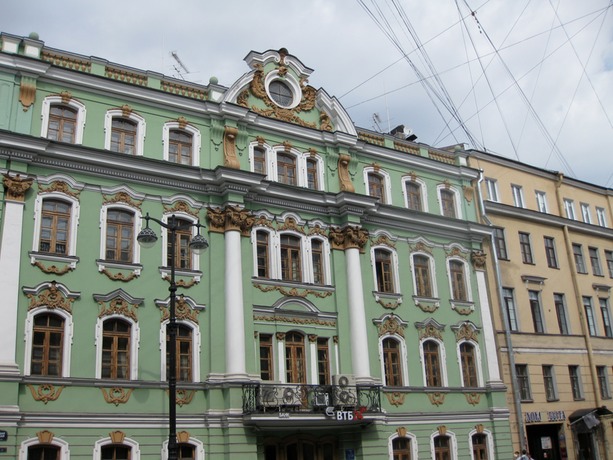
The main shopping street, Nevsky Prospect, is 8 lanes wide with few opportunities to cross, and is fronted by opulent buildings. Once we left Nevsky Prospect, though, we often could hardly tell whether we were passing by shops or not: there were few big display windows, lots of closed doors, and no markings to distinguish them from private entrances. Purely through stubbornness, we did find a theatre museum--it started on the third floor of the building--with four old ladies who made sure that we saw the whole thing . . . leading us from room to room, turning lights on and off as we entered and left, and seeing to it that we operated the wind and rain and thunder machines. The many scene design models ranged from antiquity to the high point of Russian theatre in the 1920s. But nothing was translated from Russian. In fact, outside of the hotel, we found very few clerks or wait staff who spoke any English.
We also visited three Orthodox churches: one where all the Tzars are buried, another with mosaics that rival Ravenna, Italy, a third filled with icons . . . and all of them over the top with gold leaf.
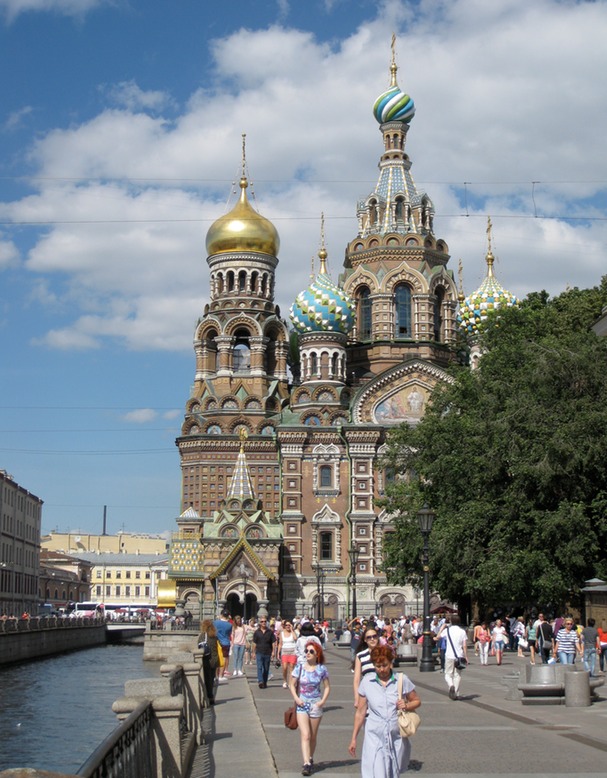
The Church of the Savior on Spilled Blood (!) marks the site of Tzar Alexander II's assassination.
To bring us back to earth, that evening we ate really bad fish and chips at the hotel and watched the Olympics.
The next morning Anna and a different driver took us on a tour of the Hermitage. What used to be an opulent winter palace for the Tzars is now a (still opulent) art museum.

Anna knew her way around, knew--and loved--Russian history, and knew what we wanted to see. Because we’d bought tickets ahead of time, we could avoid standing in line, and we skipped whole floors and wings of things we weren’t interested in (“Do you want to stay here after our time together is over?” she asked. “How much haven’t we seen?” we replied. “About 99%,” she said, smirking just a bit).
The Hermitage is an impressive place, but after four hours on our feet--accompanied by considerable Marxist aesthetics from Anna--we were ready for lunch. Anna recommended a restaurant we never would have discovered on our own: once again, there was nothing outside or on the door to indicate to an American that it was a restaurant, but it proved to be popular place with the locals: meat pies, fish pies, vegetable pies, and of course, dessert fruit pies. We had a delicious lunch for $17.75, including dessert and coffee.
And then we were on our own. Anna had assured us that the pickpocket and thug stories we’d read about were exaggerations, but we remained careful and alert anyway, and came away without incident. Later that afternoon, we took a boat tour in English that she had suggested. St. Petersburg is built on islands, in the midst of one major river and many small canals. The sky darkened as we waited for the boat, and within minutes of boarding a downpour drove us all inside. It rained off and on for the whole hour of the tour. Once again we had barely avoided getting soaked.
On Sunday morning we got out of the historical city center and went to a huge market in an older part of town. It went on for blocks and blocks: about a quarter of it in newer sheds, selling new goods, and the rest on tables and plastic sheets spread on the ground. Susan bought a child’s plastic sewing machine and considered it a find at $3.
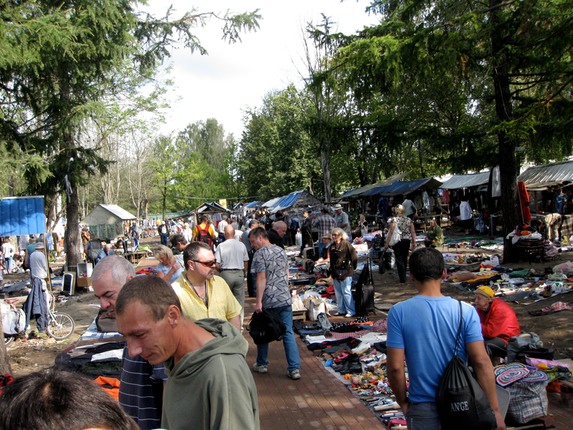
We then walked and walked, unsuccessfully seeking two other museums/shops the Lonely Planet guide had mentioned, and finally returned to the hotel to get our luggage and be picked up by a third driver, who took us to the ferry.
Both overnight ferry crossings were smooth. It takes an hour just to get out of the huge harbor at St Petersburg and into open water. A large part of the ship is devoted to partying, with bars and casino and duty-free shopping staying open all night. We had dinner and fell exhausted into bed.
We arrived back in Helsinki at 8 a.m., and after another long wait through customs got back to Rover in the campground by 10. She was waiting just as we had left her: refrigerator running, and all the appropriate monitors glowing green. Best of all, Susan’s stomach has stopped complaining every times she feeds it. It feels good to be “home” again.
August 8
One of the first things we do in a new city is get acquainted with its layout and public transportation. This is particularly important if we have firm deadlines to meet for something, as we did in Helsinki, take-off point for our trip to St Petersburg, Russia.
And Helsinki presented some challenges. For one thing, it has more than one harbor, so we needed to determine at which one our ferry to St Petersburg was docked. (It was the west harbor, the same departure point for the day trip we hoped to take later to Tallinn, Estonia.) Also, we learned that the only bus route going from the central station to the harbor ran only about every 15-20 minutes, so timing became even more important. Still, after we’d learned all that, we could relax and explore the town for a couple of days before boarding the ferry: churches, museums, markets, shops and lots of walking, admiring architecture and people-watching (they’re not all blonde in Finland, but almost; and not all tattooed, but nearly so).
We found it really easy to get around Helsinki. The subway was about a two-minute walk from our very nice campground on the outskirts of town, and a 20-minute ride brought us right to the train station in the center of the city, where there were connections to all the trams and buses.
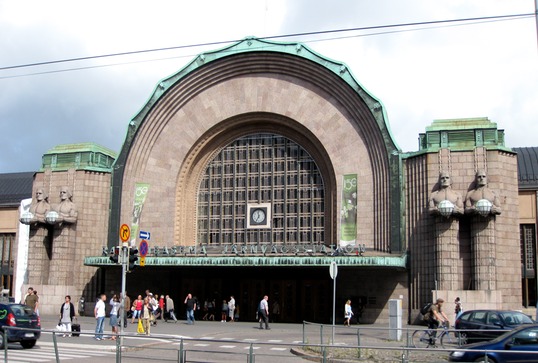
Helsinki Central Station, designed by Eliel Saarinen, 1919.
Once again we bought day passes so we could hop on and off public transportation as we wanted. They cost about $10 each, less than the cost of three rides.
Helsinki is the World Design Capital for 2012, and while it is heavily advertised here, we didn’t see that the title made much difference to us tourists. True, we visited a design museum and a showroom of that wonderful simple Scandinavian design, and in the markets there were lots of knitted items, real fur and Baltic amber jewelry . . . but somehow we expected more. Finally, on our last day in the city, we stumbled across an old porcelain factory/design showroom that had shops full of such innovative kitchen ware that we want to throw out everything we own and start over.
One of Helsinki’s major challenges is the language: Finnish is impossible for us. For one thing, it tends to add words together. During her stay in the hospital, for instance, Susan learned that Finnish makes “Turkuuniversityhospitalcafeteria” a single word. We can read it if we recognize the four words involved, but put that into Finnish with its K’s and V’s and umlauted vowels and doubled letters of all kinds and it becomes unintelligible. (A few examples:
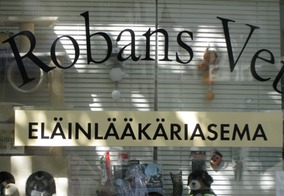


Because Sweden once controlled Finland, Swedish remains one of the country’s two official languages, so many signs are in both:
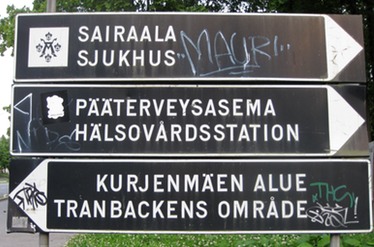
Once in a while, they also use English: it’s the default language for the Dutch, Germans, Italians, Asians, and French (who just hate it, you can tell) . . . which is really nice for us.
After we’d returned from St Petersburg, we decided to tempt the Seasick Gods once again and took a day trip to Tallinn, Estonia, to visit the old medieval walled city. It was a rough and windy two-hour crossing both ways. As the passengers got off the boat at either end, it was clear that many people take these trips just to stock up on liquor at the duty-free store on the ferry: they come with folding rolling carts and leave with them loaded with cases of vodka, whiskey and wines.
We walked the cobbled streets of this city’s charming old town district, snapped lots of photos we won’t inflict on you (well, OK, but just one):
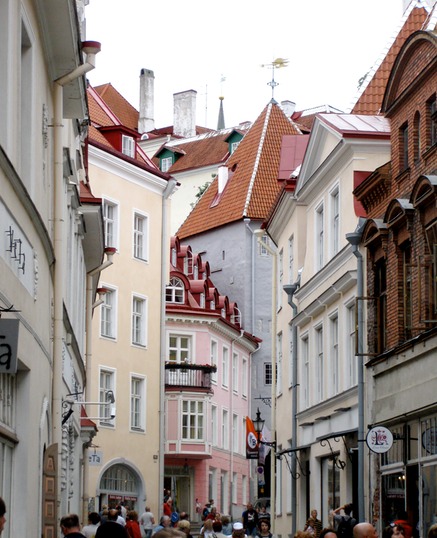
and visited a few churches and shops. Every other building is a restaurant; those that aren’t are souvenir shops. It is a popular day-trip destination: close to Helsinki, the old town small enough to see in a day, and, because Estonia is an EU nation, no passport control to slow anybody down (and of course there’s also the duty-free liquor).
We close with a “small world” story: in St Petersburg, our little canal boat tour group (seven) had included a young couple. Two days later, the male half of the pair was right behind us in line to board the ferry to Helsinki. Then, the day after that, as we left Tallinn, we saw him again, leaning against a doorway, as we made our way through the city wall to the boat. He was as astonished as we were to meet a third time. Apparently it was easier for him--but surely more expensive--to travel to Helsinki and do the “three-days-without-visa” trip to St Petersburg to visit his girlfriend than it would have been to go directly from Tallinn to St Petersburg.
August 14
It was David’s turn to feel sick: in his case, just really, really tired. So Susan drove out of Helsinki and all the way to Turku campground while David slept. Before we left the Helsinki campground, we filled the fresh water tank and dumped the black and gray water. This was the first time in 14 days that we had dumped--a record for us. But then Susan had been in the hospital for four of those days, and our St Petersburg trip kept us away for four nights. Still, we knew we were pushing our luck and decided to be careful lest we have to unplug and level again.
After sleeping for about 20 hours straight, David felt better again and we drove into Turku to visit their handicraft museum. This place is about a city block of 250-year-old wooden houses that survived the inevitable fire--this one in 1827--that had destroyed much of the city. The buildings are all in their original place and are now craft workshops and museums of a wide variety. More than half of the buildings were locked up, but it was still an interesting glimpse of what life had been like 250 years ago.
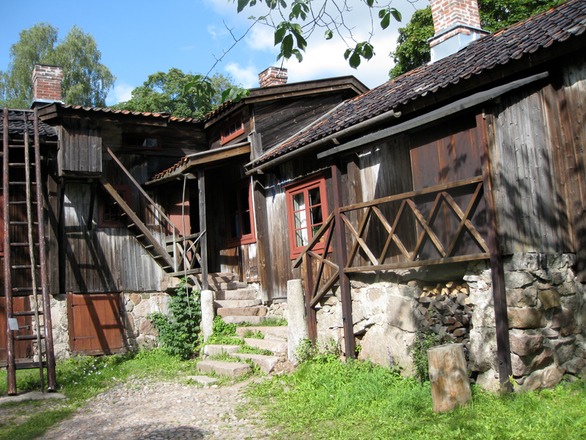
After that, we drove back to the hospital parking lot where we had parked for five nights while Susan was in the hospital. We wanted to be close to the ferry to Stockholm that was scheduled to sail early the next morning.
We were one of the last vehicles to be waved onboard the ferry . . . directed alongside a daunting row of 18-wheelers . . . just barely squeezing past . . . almost all the way to the bow of the ship . . . right in line to be one of the first ones off. We opted to shut down the refrigerator for the 12-hour trip rather than plug in to the ship’s generated current and risk some electrical problem like the one we’d had on the journey to Finland. (As it turned out, everything in the refrigerator seemed to survive without any problem.)
We had opted to pay a little extra for a private cabin (inboard; no window), so we would have a place to rest away from the many passengers who regarded the journey as a fine excuse to party--and the ship line, who encouraged this attitude by hiring Elvis-impersonators to entertain at 3:00 in the afternoon. Nevertheless, we did spend quite a bit of time at a good table right at the prow (but inside, protected from the wind). There is surprisingly little open water between Finland and Sweden, and from our table we could watch the ferry wending through the archipelago of rocky little islands as we left Turku. More than four hours later, we finally left them behind . . . only to soon be amid others like them as we approached Stockholm.
We were, indeed, one of the first off the ferry, and at the stoplight at the end of the wharf a sign directed us to the E4, so we were quickly on our way to Uppsala, 40 miles to the north. We found the city’s campground and chose a site outside its small Wifi zone rather than park closer to the antenna but next to a noisy group with children racing about and adults clearly planning a big outdoor party (do we sound like kill-joys, or what?). On Sunday we rode our bikes an easy ten minutes into the city, stopping first at the cathedral, where the choir was rehearsing for a service about to start. This cathedral is the largest in all of Scandinavia: red brick, undecorated, with two towers, each as high as the building is long.
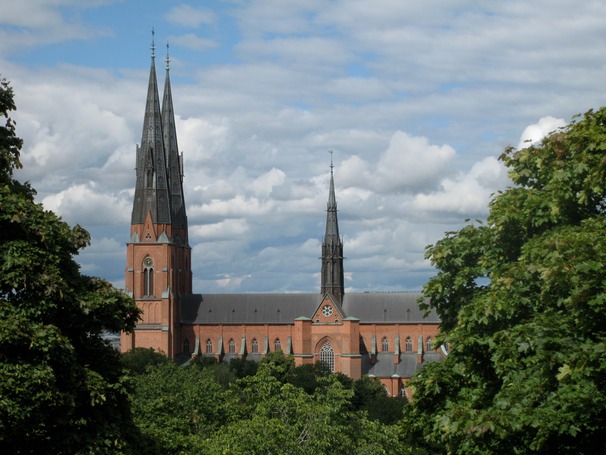
Unlike its plain, unadorned exterior, the cathedral had quite a lot of painted detail inside. We stayed for the first part of the service, but sat way in the back so we could easily sneak out, since we didn’t think we could make it through an hour and a half service--or so it was billed--in Swedish! We went in search of museums, and even on a Sunday were able to find a couple that were open. One was the home and garden of Carl Linnaeus, the biologist responsible for some of the systematic taxonomy we all learned in Biology 101. It was a lovely “fireproof” home that had survived the fire of 1702 that destroyed much of that city. (How many places on this trip have we heard of a fire destroying an entire city? Everywhere we go, it seems.)
We fell in love with Uppsala. It is a lovely university town: tree-lined streets and boulevards, tree-lined riverfront, hundreds of bike racks filled with thousands of bicycles, flowers everywhere, students even more plentiful. It is hard to imagine it on a cold, dark midwinter day.
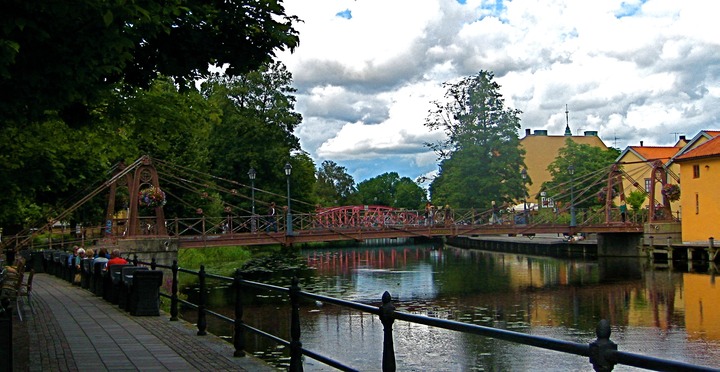
We stayed an extra night and went into the city again and visited the Carolina Rediviva (university library), where there is a Bible from the 6th century. And then, duly edified, we walked the shopping streets with everyone else.
We are heading east now, back to Norway. We are in Hallestammer, at our first campground with a swimming pool that is both free and open: 50 meters long, 8 lanes wide, alongside several smaller kiddie pools, all available to the public, but free to campers. We finally got our swim suits wet.
August 18
Winding our way west across southern Sweden, we have visited Nora, a small, mostly wooden one-story town, oozing charm, that has not yet burned to the ground. We also visited the castle in Örebro after finding a place to park Rover right alongside its moat in the center of the city. Later we drove just a little further into the town to Wadköping, another old handcraft village. Most of its buildings had been moved from elsewhere in the town to create the place. Unlike other similar places we’ve visited, nearly all of it was open, and it had a large used bookstore with an English section: always a popular find.
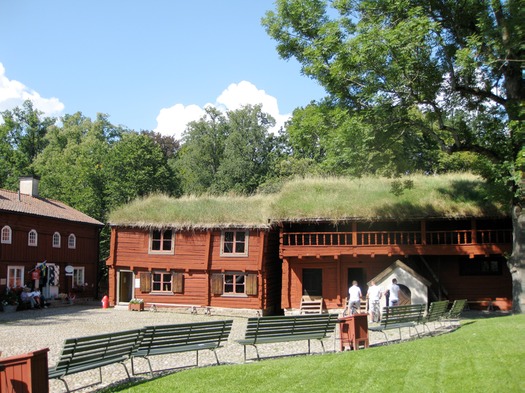
We stayed in Örebro that evening, in a huge resort campground where the receptionist just gave us a 24-hour internet password (even though the sign in the Reception had said we’d be charged for it). The next day we drove south to Kumla, to the largest shopping center in central Sweden, and then on to a shoe factory museum. The parking lots around the shopping centers have always been large and easy to maneuver, but finding parking in the center of these little towns is always a challenge. The shoe factory had its own little place for four cars, and Rover hung out just a bit on to the sidewalk . . . well, about 4 feet.
We are finding the still open campgrounds to be the large family-oriented resorts that cater to families during the Swedish vacation period. It seems to have ended in mid-August; in fact, one of the places we stayed at actually had closed down half the camping spots already. We drove on to Lidköping, stayed one night in the rain, and then drove north to the lovely Läckö Slott (Castle) standing out on a point on Vänern lake (and we certainly hope the purists among our readers appreciate the trouble we’ve taken to get the diacritic markings right!)
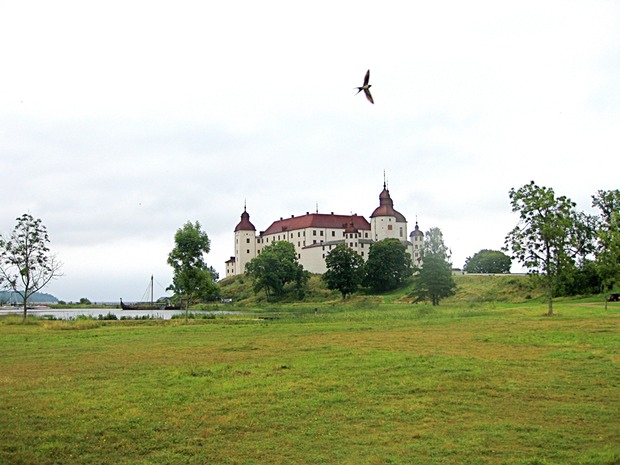
All of the detail inside the castle is original--and painted--no gold leaf here. Seeing it was worth driving the 30 miles on a country road. As we got nearer the castle, the path got more and more narrow. It was simply laid out over the terrain, up, down and around, not a tenth of a mile of it straight. But it was a good road just the same, well paved and not too bumpy, even through it offered no passing places.
We believe we had written earlier that the roads deteriorated when we left Norway and drove into Sweden. We take that back. The Swedish roads have been unfailingly excellent: wide, good shoulders, and well marked. (Of course, they do not have the Norwegian terrain to deal with.) One interesting driving regulation in Sweden calls for slower drivers to pull over when possible to let faster traffic pass. Some of the highways have wide shoulders just for that purpose, marked by broken white lines. The highway we were on today had shoulders sometimes almost the width of another full lane. We have had to detour on to country roads a few tmes and even those have been adequate and comfortable to drive Rover on.
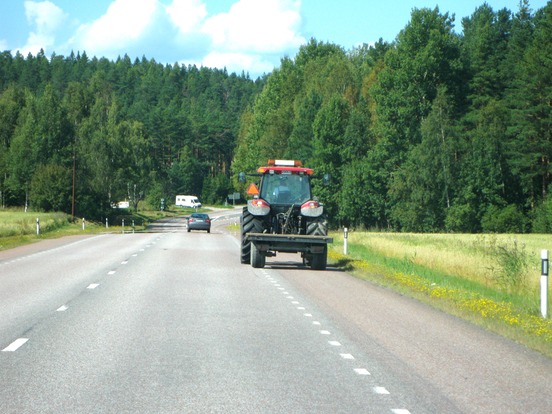
When we return to Lillehammer we will have to winterize Rover’s fresh water plumbing system before we consign her to Norway’s dark winter storage. We have been unable to find the nontoxic RV water system antifreeze that is so easily available at home: people here just give us a blank stare when we ask for it. Today we found a RV shop big enough to qualify as Sweden’s equivalent to our Camping World . . . but even they didn’t know what we were asking for. We talked at length to the RV dealer onsite, who told us that the German motorhomes he sells are insulated for winter and that they simply blow the lines out. (He also asked to see Rover and took several pictures.) We have never done this (and aren’t sure we can find fittings that will work with our half-American, half-European water-and-compressed-air systems), so we’re still hoping we can find antifreeze or an alternative. Vodka, anyone?
August 22
As we came closer to Norway, the flat farm fields of Sweden changed to rocky wooded hills. Just before reaching the border, we stopped to fill up with gas at the lower Swedish prices. The station was located in a large shopping center where the parking lot was full of cars with Norwegian license plates. We also counted twenty motorhomes there. Everyone was stocking up at the lower prices. We bought just a couple of things at the grocery store, but the guy behind us had eight 2-lb. packages of ground beef.
We are now back on Norway’s toll roads. There were no tolls in Sweden or Finland, but in Norway you drive through toll cameras every 20 miles or so. If you are going to travel for several weeks in Norway as we did, it is necessary to set up an account with a credit card: the Norwegian authorities then charge a couple of hundred dollars to the card and subtract the toll from that amount every time we drive past one of their many cameras. If necessary, they load more money into the account. Eventually--well after the end of your travels--they refund what’s left over. We had set up an account before we began driving through Norway at the beginning of this year’s trip; later, we had to set up a second account before our return into the country a second time. As a result, we have no idea how much tolls have cost us, because it will take a while before the Norwegian authorities reimburse our credit card account.
We stopped for one more day (two nights) in Oslo. The campground was much less busy this time, we had no problem finding an electric hookup . . . and our view of the city wasn't blocked by other campers.
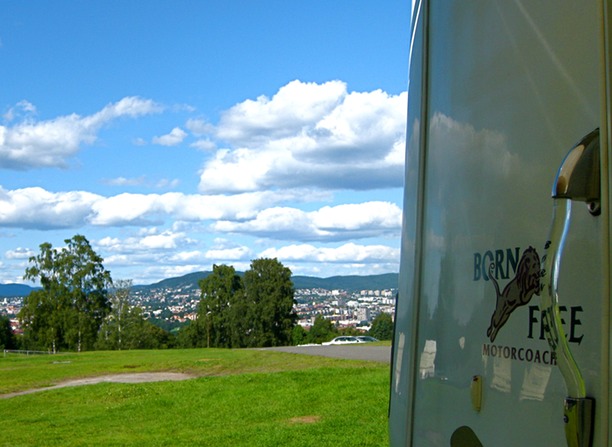
Also, getting to the campground this time, from the south and east, was a whole lot easier than approaching from the west and through the city had been a month ago. But if you are going to spend only one day in Oslo, don’t make it a Monday: anything worth visiting is closed.
On Tuesday we drove our final lap to Lillehammer.
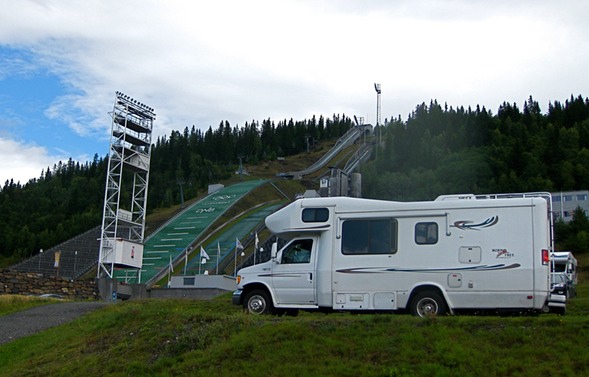
At Lillehammer's Olympic ski jump.
Along the way we found two more caravan stores that didn’t have RV antifreeze. We thought we were about to buy a large quantity of the world’s most expensive vodka (taxes on alcohol here being very high). But David read an internet help site on which the answer to winterizing a cabin cruiser’s water system involved “plumber’s antifreeze”; at about the same time, someone suggested we speak to a plumber about how people in Norway winterize water lines in a summer cabin; we did, and were sold 3.5 liters of a concentrated, non-toxic, lightly tinted liquid we are supposed to dilute with a liter of water.
To celebrate, we then spent the day giving Rover a much-needed bath and interior cleaning.
We have travelled 3538 miles, and after we have returned home and added up all our kroner (both Swedish and Norwegian), euros, rubles and dollars, we will post a final blog entry in early September.
August 31
Rover is now snugly tucked away in covered storage in Lillehammer, Norway. We found a plumber who sold us some (unnamed) liquid to use as antifreeze to winterize our plumbing. He assured us it was non-toxic and would do the job. So, having no real alternative, we pumped it in and trust it will work.
We keep close track of our spending, and knew after only a few days of travel that this was going to be an expensive trip. And so it proved to be.
Still, we tried really hard not to be continually converting currency in our heads, and most of the time we succeeded. If we wanted, say, two cups of coffee, we were determined to simply pay the $10-$12 and not let it bother us.
Or not too much.
Details:
During our three months of travel, we spent $4900 on food (including wine). This was easily double what it would have cost at home: if we each had a simple sandwich and cup of coffee for lunch, the cost could easily be $25 to $30; an evening restaurant meal with a glass of wine was $80; a 3-liter box of cheap wine $50.
Campground costs were $2530. This is $12/night more than we paid last year and more than $20/night higher than our first trip, in 2008.
We were on the road 75 days: 64 nights in campgrounds and 10 in free sites (three in designated motorhome parking, seven in parking lots). The cheapest campground was $19.71 (with only electrical service); the most expensive $66.25 (a large family resort in Norway in high season). We averaged $40 a night, including electricity and shower costs. Nearly every site charged extra for electricity ($3-$7) and many did for showers as well (between $.75 and $1.50 for five minutes of hot water).
The quality of the campgrounds and facilities was generally very good. They all had toilet seats, toilet paper and outlets for hair dryers. Only twice did we have access to water at our site; only twice was there a picnic table; only once were we offered our own sewer connection (which we declined as an unnecessary expense). Not every campground could accommodate our waste system, but we had no problem finding places that could: Norway, for instance, has an extensive system of waste stations, all of them well signed, at gas stations and rest stops.
We always felt safe and even left Rover alone for five days in Helsinki, Finland, while we took a ferry to St. Petersburg, Russia. And the prize for the best campground goes to that campground in Helsinki. Each of its large pitches had both paving and grass, as well as hedges for privacy. Public transportation was right across the street, and the campground’s facilities were good and clean. Rover was there for 9 nights at a cost of $28/night (the price was discounted because of the length of our stay).
Gasoline cost $3999, an average of $9.30/gallon. The cheapest gas, if we figured it correctly, was in Russia: $4/gallon (but of course we did not have Rover with us to take advantage of it . . . or of the $6/gallon price in Estonia).
We covered 3542 miles during the three months. Rover gets 10 mpg, partly because even on divided highways we drove no faster than 50 mph (the speed limit in Scandinavia for vehicles our size).
We spent $71 on LP gas, which we use for cooking, running the refrigerator when we are not plugged in, and the furnace. We filled the tank at the beginning of the trip in Lillehammer and topped it off about a month later; when we put Rover in storage, we still had more than half a tank left. It was not a hot summer, so we actually ran the furnace occasionally for a few minutes, never used the air conditioner, and had blankets on our beds every night.
One of our largest expense category was $2050 for miscellaneous transportation. This included all buses, taxis, and parking fees, but was primarily the short ferries in Norway and the longer ones from Helsinki to Estonia and from Stockholm to Turku, Finland (this last one was $980 round trip, with Rover, including a private bedroom).
We spent another $2050 on museums, churches, tours, boat rides, concerts, etc.
Internet access came to $150. Sometimes the WiFi was free, at other times cheap . . . and occasionally it was ridiculously expensive. Also, its speed and reliability was often poor (but at least more and more campgrounds are realizing they need to make it available).
We spent a lot of money--$6000--before we even left home. These costs included airfare ($1900), the St Petersburg trip ($2070 for the hotel, transport, tours and overnight ferry), RV insurance ($1036) and the previously mentioned Stockholm/Finland ferry.
Although our expenses were highest in June, which we spent entirely in Norway, one of this trip’s two really good deals was also in Norway: the $561 we paid for storage for Rover in Lillehammer until next April or May. But our greatest surprise--and one we greeted with much relief--was getting home and opening the hospital bills for Susan’s emergency room visits, ambulance ride, four days in isolation, and lab tests: $3061! And that includes a CT scan! In the US, ten times that amount wouldn’t have surprised us. Even better, our insurance should cover most of it.
At $1800/week, this was easily our most expensive trip to date. But while that number sounds very big to us, we remind ourselves that our “at home” expenses during these three months were minimal and, had we chosen to stay home in the US, we’d have been spending at least $1000/week anyway.
Besides all that, having time with our granddaughter is priceless.
The scenery in Norway was worth a lot, too: there wasn’t a day when we didn’t come over a mountain or out of a tunnel and say, “Wow.” Sometimes it really did take our breath away. The weather was mostly good--cool, never hot, some rain--and we magically managed to avoid being out in the worst of it. The effect of the 20+ hours of daylight is very strange, and we were happy to get further south and later in the year to return to a more normal daylight schedule.
As always, we were grateful to the people we met who learned to speak English and, particularly this year, were impressed by how very fluent they usually were.
Other pluses: the coffee in the cafes was excellent; we saw more of the Tour de France than we could have hoped for; and as a result of Susan’s hospitalization, we saw more of the Olympics than we’d expected (although it was in Finnish).
Rover, our 24RB (Rear Bath) Born Free performed perfectly: she gave us no problems with any of the systems or engine, is freshly equipped with six Michelin tires ($2076 in Norway), and now has 69,793 miles on her odometer.
18,307 of those miles have been racked up in Europe during 14 months of travel on five trips, but we haven’t yet seen everything we want to. Our tentative plan for next year is to start from Lillehammer a little earlier than June and immediately head south through Sweden into Denmark and Germany (in preparation, David will be taking a refresher German II class through Adult Education). We hope you will come along again.
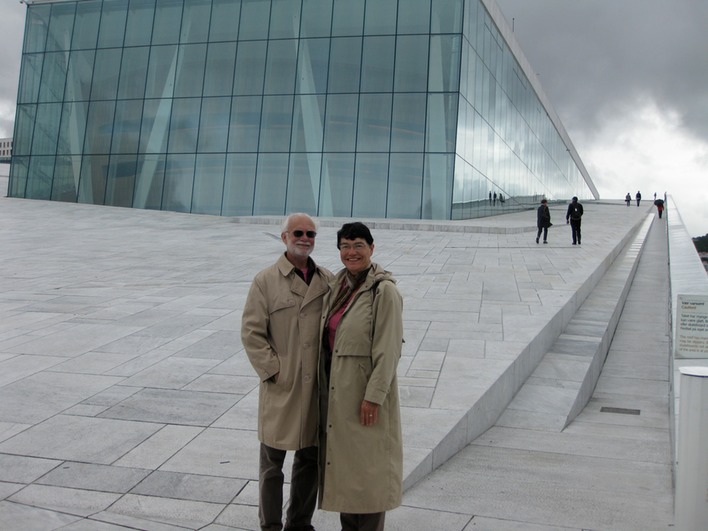
At Oslo's Opera House
June 5
Because we are headed to Scandinavia this year, we decided to postpone our departure until the very end of May in order to coincide with the later spring in northern climes. We left Minneapolis with three 50-lb. suitcases (much of it books and maps and stuff requested by our daughter) and one 58-lb. overweight cooler on wheels, packed with what we trust is a repaired inverter-charger. As far as we know no one questioned this heavy piece of electrical equipment: at any rate, we took it off the baggage carousel in Oslo, without incident and with great relief.
We then stopped at the first ATM machine and picked up our first pocketful of Norwegian Kroner. Then we headed to the only Starbucks in Norway--conveniently located at the airport--and bought two pounds of coffee, two cups of coffee, one sandwich and one muffin: $56 worth. This will not be an inexpensive trip.
The train to Lillehammer was very crowded, but the cooler provided seating for quite a while. When we arrived, we learned that our son-in-law had tried to pick Rover up from storage for us, but the battery had been dead. So we headed directly from the train station to the storage building, only to find that Rover still wouldn’t start; nor did she on Sunday, after a whole day of charging. Houston, we have a problem and it’s not the battery. It’s going to be an expensive one.
And David hasn’t even tried to reinstall the inverter-charger yet.
June 7
Because Rover was stored in the dark back corner of a very large building, we needed to tow her out into the (never-ending) Norwegian daylight in order to let the mechanic get to her problem. When we did and he did, it took only a few hours to fix the gas line. This problem had been complicated by the fact that Rover had been sitting for 11 months with very little old gas. We had been unable to put her in storage ourselves last July since nearly everyone in Norway goes on vacation for the month. So our son-in-law had driven her to storage after the owner returned to unlock the doors. We had neglected to fill her with gas, let alone give him the Stabil we’d bought just for that purpose.
So after the fix, an oil change, and many Kroner, we were on our way to the tire store where we left even more Kroner. (How expensive is Norway? The country recently eliminated the “penny,” with the result that now their smallest coin is worth 16 cents!)
We were glad to get Rover back to our daughter’s home, which has a wide flat driveway/parking space. There we were able to unpack and David reinstalled the inverter/charger. It was (for him) no easy task, but it appeared to work just fine . . . for about an hour. We left everything plugged in hoping the electrical fairy would fix everything overnight. But she didn’t show up: our gauges looked exactly like they had last year.
We were about to call the local campground for an RV technician when our daughter remembered a lovely Irishman, trained as an electrical engineer, who now works in the North Sea oil fields. He was near the end of the “off” leg of his “three weeks on-three weeks off” stint but agreed to come over and take a look at Rover’s problem. After about two hours of trouble-shooting, he found a loose ground wire and a melted wire nut with an arcing connection inside the fuse/circuit breaker box. When he corrected those two items, all the control panel indicators glowed green and everything worked for the first time in a year! Not only that, he absolutely refused to take any money--so we left some with our daughter to buy him and his wife a very nice bottle of wine and resolved to be on the lookout for someone in need for whom we could be an angel.
Maybe, just maybe, we will be on the road tomorrow.
June 10
Driving Rover in Norway is proving to be easier than driving on the (rest of the) Continent or in Great Britain. The roads are usually a bit wider--and when they aren’t, they’re well paved and have reasonably low speed limits--and parking lots are comparatively huge. We left Lillehammer on the E6. “E” highways are Norway’s version of interstates, but just north of Lillehammer this E becomes two-lane, often with a double yellow line down the middle. There are a few places where one can pull over and let others pass, but the speed limit is usually 50 mph (and brutally enforced to the tune of $700 tickets), with the result that hardly anyone passes.
We had gone 11 miles when we hit our first construction detour. It took us through a couple of small towns and then back on to an E6 that was still very much under construction. We were following a large flatbed truck loaded with large drainage tiles. He pulled over and stopped; we pulled around him. It was about that moment Susan asked David, “Where is the southbound traffic?” Answer: It was coming directly at us on the single lane that wound through the construction zone. When the flatbed truck had stopped, it had been at a red signal light that he was blocking our view of. So within 20 miles of our first outing, we were backing up about 50 yards, pulling over out of the way, letting the southbound traffic pass, and then letting the truck and the other northbound traffic pass us--the light having turned green--after which we pulled in behind them all and continued on our way. Not a good way to start a trip--but it was all easily accompished with great aplomb on our part. And actually it was quite funny.
We got off the E6 and drove east on a smaller road. Even with the occasional 10% grade up and one 12% grade down, it wasn’t difficult, probably because there was virtually no traffic. We drove about 60 miles and met maybe 20 vehicles. For a while we were above the tree line, where snow lingered on the tops on low mountains.

We passed lots of remote campgrounds and stopped for the night in Grimsbu, which appears as a town on the map, but consists only of the campground-with-restaurant, an ancient BP station,

a Joker store (kind of a 7-11) . . . and lots of sheep. At the end of the day, we were blessed with a beautiful rainbow.

The next day we drove on to Røros, stopping on the way in a town with a Vinmonopol. The name is accurate: it’s a state-run store that has a monopoly on the sale of wine and hard liquor. Like any self-respecting monopoly, it sells its goods at very high prices. We bought a 3-liter box of their cheapest wine (the equivalent of four bottles) for $50. Yes, beer can be purchased in grocery stores, but it’s not the same thing.
Røros is a UNESCO world heritage site: a little town built next to and on a slag heap from copper mining, with a very impressive museum in some of the old mining buildings.

A women’s bike race had just ended on one of the main shopping streets in town, so there was a very festive atmosphere with lots of people, and stores stayed open on the pedestrian streets to accommodate us all. We camped in a small field adjacent to a hotel and several soccer fields. So far, campgrounds with electricity have cost nearly $40 a night. But Norway is prosperous and doesn’t need our economic aid, so we will be aiming for a free place when we get to Trondheim.
June 11
All in all, Trondheim has proved to be pretty easy . . . except for getting lost on our bikes. To begin with, the GPS led us to the city’s free “bobil parkering,” a nice big lot where half a dozen other RVs were already parked. Then we got our bikes out, re-educated ourselves on how to unfold them, carefully rode down a big hill on their very soft tires to a nearby gas station, filled the tires, and then headed further down the hill into the “sentrum”--about a 15 minute ride. Easy.
The old city center is an island, easily walkable and full of bicycles. Our first stop was at the Nideros Cathedral, Scandinavia’s largest church building. We were charged admission to enter, and the cloudy day didn’t do justice to the stained glass windows in the dim interior. But we also heard a beautiful choir performance that evening, sung without accompaniment in that massive, echo-y space.

(If you've been following our blog for any length of time, you'll recognize this as the inevitable "cathedral facade" photo.)
Usually we don’t go out in the evening, preferring to be back to Rover by dark. But as far north as we are now, and as close to the summer solstice, there’s no such thing as “dark.” It was barely twilight by the time the concert finished at 9 pm. So we could easily see our way home even though it was the wrong way: our GPS still thought we were a truck and didn’t want to let us go on bike paths. And much of it was uphill (like all of Norway, so far as we can tell). As a result, the return trip was considerably longer than the one into town that morning had been.
Like most cities in Norway, Trondheim was originally built from the pine trees that grow all over the country . . . and, also like many of the nation’s cities, it has burned to the ground several times. After its last major fire, in 1681, it was rebuilt with wide streets, so it has quite a modern feel, even though many of the buildings are very old. It is also home to a large science and technical university, so there are lots of students around.
The next day we had no trouble driving all of three miles right through the middle of the old city to another “bobil parkering” even closer to the city center (no more uphill jaunts on a folding bike, misled by a GPS, thank you very much). This lot had no services, just free 24-hour parking, but it also was only a short walk across the river to the city. With no plug-ins, we had to depend on our batteries for 12-volt and 110-volt power both days, but so far they have held up well (of course, we have hardly had to turn the lights on).
We spent our (mostly sunny) second day in Trondheim walking the neighborhoods . . .

. . . visiting shops and museums and reading English language papers at the library. It is amusing to see streets and alleys and whole sections of town called Brattsomething: Brattorga, Brattorgt, Brattorvieta. . . . Trondheim is on a fjord, so there are plenty of seagulls. As we walked past an outdoor cafe, we saw one swoop down and take the last bite of bread off a woman’s plate. She was very startled and upset about this large scavenger literally flying in her face. (The bird, however, seemed rather proud of himself.) Later in the day as we were eating our sandwiches on a bench, we were circled by seagulls keeping a close eye on us--as we did on them. We knew enough to keep our food out of sight, but they didn’t leave until we had finished and disposed of everything. They were . . . intimidating.
The weather is cool and there’s often a brisk breeze: we wore gloves and headbands today, June 11. On the other hand, this is the first day since we got to Norway that it hasn’t rained even a little!
June 14
Trick question: which of the pictures below is of a Norwegian “E” highway, i.e., the highest designation, one of the roads than which there is no better?
This?

Or this?

Answer: both of them.
The first one was taken a bit north of Trondheim, where the countryside is more densely populated; the second is of the road much farther north, where the promise of less traffic seems to have given the civil engineers license to let nature dictate not only the road’s direction but also its width, severity of ascent and descent, camber. . . .
For the first 240 miles north of Trondheim, the E6 is pretty easy driving: there’s a yellow line down the center, pull-over places, and quite a few small rest areas. Driveways and streets enter directly on the road, and there’s restricted access only in bigger towns (where one might actually want to access a gas station or grocery). There are narrow places and a few single-lane bridges, but generally, thanks to the spectacular scenery, it is a beautiful drive--at least for the passenger.
We followed along the Trondheimfjord and then through farm country that looked like Germany’s Black Forest. But the road goes mostly through pine forests and along lakes, rushing rivers and streams--RIGHT along the very edge of rushing rivers and streams--through a few tunnels, winding up and down a whole lot of big, big hills. We passed many motorhomes going south and often we went for miles without seeing anyone, feeling very remote.
We camped overnight in Mosjoen (pronounced sort of like “motion”) at a campground that boasted the first bowling alley we’ve seen in Norway. The next morning we continue our trek north toward our goal . . . the Arctic Circle. Ominously, the road begins to deteriorate: the yellow center line disappears, the severity of the winding and climbing and falling increase, the road is trafficked mostly by motorhomes and 18-wheelers. Sometimes there are guardrails, but mostly not. The only shoulders are on newly paved sections, which generally don’t amount to more than a mile or so. There is just barely room to pass at 40 mph. Then the pièce de résistance: work on a tunnel sends us on a 9-mile detour up and down a mountain. We pass a woman pushing her bike up the 9% grade.
At the Arctic Circle there is a tourist store, a marker, and a parking lot full of motorhomes. One had an Australian license plate, and we saw someone taking a picture of ours. The “Polarsirkelsenteret” is above the tree line and, appropriately, there was still snow on the ground. The temperature was in the low 50s so the snow was melting fast, filling the waterfalls and streams we had seen along the way. We took the necessary pictures,

walked around the shop, bought the obligatory t-shirt and bumper sticker, had lunch . . . and then headed Rover back south, this time knowing exactly what kind of road we faced.
It was a beautiful drive through a bazillion spruce trees and birches, and we are glad we did it. True, with Rover getting 10 mpg and gas at $9/gallon, it was a pretty expensive side trip. But we can say, “We made it to the Arctic Circle!”
And so can Rover.

June 16
Trondheim to Kristiansund. We are headed for the west coast and then south. Kristiansund is a fairly large port city situated on three islands connected by impressive bridges and expensive tunnels (there’s a surprise). We have learned that motorhomes of 6 meters is the limit for the low tolls; we are 7.6, so we pay what the big trucks pay. We took our first ferry where the E39 ends at the water’s edge and continues on the other side of a 20-minute, $45 ride. By accident, we timed our arrival at the queue perfectly and waited no more than 15 minutes for the ferry. Everyone drove on and it left immediately: the toll was collected on the ferry. There were a couple other motorhomes and about 15 cars on our trip, with room for a least twice that many.
We headed to the city and to the campground just above it. Then we walked down to the active harbor where one of the huge Hurtigruten ferries was just arriving, with a band playing on one of its decks and hundreds of passengers taking in the view of the city. But apart from that, Kristiansund was pretty closed up at 5 pm on this Friday night, so we made our way back to the campground.

When we write “Friday night,” of course we don’t really mean “night.” The sun dipped below the horizon around 10:45 pm, after which the sky remained twilight all night long. Some evenings we will be reading and suddenly discover that it is well past our bedtime. And, of course, if we wake up at 3 or 4 am, the sun will be shining already. Rover’s day/night shades are definitely not of room-darkening quality.
Because we were parked right next to a water spigot in the campground, Susan gave Rover a one-pail-of-water bath, and when we filled our fresh water tank she got a quick rinse (Rover, that is). Generally, washing motorhomes is forbidden, but we did it anyway. Worse yet, this bath required David’s sacrifice of a 23-year-old RAGBRAI t-shirt.
Then we took off for the five mile tunnel under the fjord and headed south to the Atlantic Road and its seven bridges. It proved to be well traveled and not at all intimidating. Because we had not been able to get a picture of Rover in front of the Eiffel Tower or at Buckingham Palace, Susan was determined to get one of her (once again, that’s Rover) on the iconic bridge. Along with many others, we stopped at a pull-over spot and then David drove over the bridge to the next turn-around while Susan took pictures. Then he actually returned for her (!) and we continued south.

The roads have been good and the traffic light. This was a fairly short day of driving, ending up in Molde at the best campground yet. We are right on the Moldefjord, looking out at the mountains where we are headed next.

June 18
Before we left Molde, we decided to use the campground’s new sanitary dump. It would have easily accommodated Rover’s American-style discharge equipment, but the space was surrounded by low bushes and despite several attempts there was no way we could maneuver into it. So we gave up on that plan and made our way to the ferry dock.
We timed it perfectly. All the other vehicles had been loaded, and the crew was about to raise the ramp when they saw us coming and waited for us. We drove right on and the boat was moving within a minute. Then it was off the ferry and across hillside farm country to the city of Ålesund. The GPS gave us an interesting and totally unnecessary route to a “bobil parkering” right on the waterfront. It is an unstaffed place with free showers, toilets, water, and dump, but no electricity. We are among about 20 other motorhomes. Rover’s front end is less than 10 feet from what our (Norwegian) road map calls the “Norwegian Ocean.” And we are literally just a couple of blocks from the city center. It is a great place to be . . . if only it hadn’t been so difficult to get to.
Ålesund is a lovely town. It burned to the ground in 1904 and was rebuilt in a few years in the Art Nouveau style. All the buildings in the city center are now brick or stone, most with some lovely detail in their design.

We took a “train” tour (the wheeled variety) through the city and up a hill overlooking the town. We also walked the streets and toured several museums. In one we saw a replica of the 18-foot enclosed lifeboat “Uroed” that crossed the Atlantic Ocean with four men in 1904.

A clerk in a store told us they are having the same weather now that they had in January: she called it “a green winter.” It has rained off and on since we arrived here, but the only heavy downpours have come after we have returned to Rover. As today’s rains fall, we can watch the ferries and fishing boats pass directly in front of us.

June 21
Today we made a bus back up. Tour buses are the bullies of the Norwegian roads: they know where they are going because they have been there before so they drive fast, they take turns wide, and they often roam in gangs.
We had made our way to Hellesylt, a small village on the (we are continually assured by the travel brochures) “world famous Geirangerfjord.” The road to the town was remarkably good until we came to a very dark, narrow, loooong tunnel. It was an old one, and (like many of a certain age we could name) it was dim, dripping water . . . and going downhill fast. Fortunately, we met only two cars in it. It spilled us out into an incredible view of the fjord that we scarcely had time to look at before the road sent us through two more short tunnels and into Hellesylt. There we found a bank, a woolen goods outlet shop, two grocery stores (right next to each other, as we often see in Norway), a ferry port, two souvenir shops and a campground whose owner shows up for an hour at 8 pm. We stayed there for two nights.
The next day, leaving Rover in the campground, we took the ferry tour along the fjord to the tourist trap town of Geiranger. The views are indeed magnificent.

The town was comfortably full of tourists disgorged from two large tour boats in the harbor, and we counted 50 motorhomes that, unlike us, had dared to drive mountains and hairpin curves to get there. In addition to the souvenir shops there was a very good museum half a mile up the hill that we trekked up to in the rain. We took the ferry back to Hellesylt for the night, and today we headed south.

Today’s adventure was a 9-kilometer stretch of very narrow road. True, it had many pullover spots, but you have to hit them right: they do you no good if you’re between two of them when the truck is coming at you. Fortunately, traffic on this stretch was light, but at a construction site, after we had wormed our way through a single-lane detour, we were met by a tour bus that had pulled up so far he couldn’t be bothered to give us full access to the road. We couldn’t back up; he shrugged sneeringly, as if to insist that he could hardly be expected to, either; finally, though, he relented and did.

Then the road went up and up with several hairpin turns before descending for miles at an 8% grade into Byrkjelo, a little village with a nice campground. We decided 67 miles of these roads were enough for today.
And then the sun came out!
June 23
For the past two days we have been surrounded by incredible natural beauty. The road we took south through the Vatedalen Valley rivals the Geiranger fjord in landscapes. Probably the only reason it is not inundated with tourists is that, unlike fjords, it is inaccessible to 3000-passenger cruise ships. The views were stunning and varied: sheer rock walls, farms, waterfalls, racing streams, forests and lakes . . . and all with good roads (the kind with yellow lines down the middle!) and only a few tunnels.

We passed what looked to us like a glacier and then, as confirmation that we’d been right, stumbled upon the Norwegian Glacier Museum. Its exhibits were wonderfully well done. Like another museum we visited recently, this one had beautiful movies without any words--only music. This is a good solution to the problem of addressing the great variety of languages among the tourists visiting Norway: the pictures really do speak for themselves.
Recently, no day of driving has been complete without at least a minor adventure: thus, as we made our way into Sogndal’s town center and looked for the “I” (for “tourist information”) sign, the only one we saw directed us onto a road--a road that soon became a narrow track--a track taking us away from and far, far above the town center. There was no way to turn around, so we just had to keep going, accompanied by David’s curses at each turn, bump, blind driveway. . . . Eventually we were dumped onto a more heavily trafficked road that led us back to the city. We finally found a place to park and walked to the tourist office (in the center of town, of course--oblivious to all around us, we’d passed within 50 meters of it at the beginning of our tour of Sogndal’s suburbs). In impeccible English, the young woman at the desk acknowledged that, indeed, the sign whose directions we had followed was no longer correct. She got on the phone to express her chagrin on our behalf to somebody upstairs.
We camped there anyway.
The next day we drove only a few miles north to take a 15-minute ferry ride to Urnes. As we’ve grown to expect, the secondary road from the main road down to the ferry was about a mile and a half of narrow, winding descent with some hairpins, blind turns and, once, barely a single lane.
Leaving Rover in the small parking lot, we took the ferry and walked up the 1 km hill to the Urnes stave church, built in 1130.

We barely beat a tour bus to the spot, took the tour (again delivered in impeccible English) and had a much easier walk down the hill to catch the boat back to Rover. The bus full of lazy tourists made it onto the boat with us, so we decided to tag along behind, back up the hill, and let it clear traffic for us. A good strategy: we met three cars and three motorhomes, all of which pulled over and stopped to let the bus (and us) go by.
Then we drove on to our next ferry (“Do they never cease?” you ask. No, they don’t--at least, not anywhere near the west coast of Norway). We didn’t time this one particularly well, but during the three hours we had to wait, we ate lunch, toured another 900-year-old stave church, and visited a ship museum right by the ferry dock.
The day was very cloudy, but the ferry to Gudvangen featured two hours of non-stop scenery. Even more important, it eliminated a lot of narrow, winding roads for us. It rained on the way, but these big boats have comfortable salons with large windows, so we stayed dry and enjoyed the view. As we passed a wedding party being photographed on a dock, the captain blew the ship’s whistle to them.

Gudvangen is only a ferry dock, a few houses and a campground, but all of it in incredible surroundings. We stayed two nights, using the location to take a bus to Flåm and avoid driving through 12 miles of tunnels, but when we arrived we saw many motorhomes whose drivers apparently don’t mind going through long tunnels with lots of bus traffic.
Flåm is another major tourist attraction, and they do it well. It is home to a famous mountain train that connects with a line running between Bergen and Oslo. However, like most of the passengers, we took it to the end of the line and back again for the sake of its spectacular views.

On the way up, there was hardly anyone in our car; on the return, though, the train was full of people, many of them Japanese tourists, nearly all carrying expensive cameras
June 26
We picked the wrong time to make our way to Voss: the week of the annual Extreme Sport Festival. We got the last spot in the campground, which is perfectly located for a visit to this town: in a park on the lake, only three blocks from the city center. But even empty it would have been a tight fit for us, as the spaces are short and close together. This week, every speck of grass had a tent on it and every tent came with a car with a kayak or some other piece of equipment attached. Some neighbors moved a car so David had a better shot at backing into our space. The place was full of young athletes and their friends. A huge festival stage and tent had been erected about a block away, so we knew we were in for a late night since the party started at 9:30 pm. But . . . location, location, location: any other campsite was miles away and all the parking spots in town were taken.
The weather was perfect, so we got our bikes out, found the Folk School that our son-in-law had attended some years ago, and then took the cable car to the top of the mountain. From there we watched paragliders running down the mountain and hurtling themselves into space. The view from the top was beautiful on this clear, sunny day, and in the evening a sky-diving show brought a crowd to the park.

(Paraglider at 11 o'clock; festival tent above cable car; campground above tent.)
We survived the late night with the help of earplugs. Then we headed for Bergen, eager (!) to see what new driving adventure the day would bring. We had taken a good look at the map and decided against (what one map said was) a yellow road with scores of tunnels and instead chose (what another map said was) a red road that took a slightly longer route.
The GPS disagreed. “Make a U-turn,” it said. Usually when it tells us this, it adapts to reality after a few miles, mutters “Oh, all right,” and sulkily maps out the course we had decided on. This time, though, was different: after 5 miles of travel, the device was still insisting that we turn around...and then 10 miles.15….Worse, after those first 15 miles, we took a right turn and the road got really narrow and winding. David put up with this for 7 miles, meeting way too much traffic. “U-turn,” insisted the GPS; and “I told you so, but would you listen?” We finally conceded, turned around and made our way back through the 7 miles, including coming to a complete standstill once while a truck scraped by as we scraped our awning support on the stone ledge on the right. We made it back to Voss and went the other way--the GPS sniggering quietly to itself, but making sure we heard--on a road with a yellow line down the middle and through many tunnels.
(Truth be told, we don’t actually listen to the GPS; we muted its annoying voice years ago. But its screen still prints its messages to us, and “U-turn” is one it’s particularly fond of.)
The GPS brought us to an ugly camping place in Bergen, right on the water in an industrial area. Small and medium sized motorhomes are packed in here, and the place is full. Its sole virtue is that it is a very easy 30-minute walk over the bridge to the old city center. And since we bought the Bergen Card today, it will be a five minute bus ride to the city center for us. Location, location, location.

(We do wonder just a little what horrors awaited us on that road we abandoned.)
June 29
Bergen is a delightful city. Even though Rover was in a crowded, dumpy place, we felt comfortable leaving her for the whole day and going into the city. (We have rarely felt unsafe in any campground.)
Our own comfort is sometimes another matter entirely; witness this site’s ridiculous showers. There were two small shower stalls for men and two others for women, each with a door opening in and a second, hinged clear plastic door that took the place of a shower curtain. The arrangement would be impossible for anyone overweight. There was a hook for bags and towels, but one had to remove them before opening the door to put the token in the meter, cunningly located outside the stall (and costing $1.68 for 4 minutes of hot water). The water started running as soon as the token was inserted, so one had to shut the door, hang everything back up, and get behind the plastic shower door before actually beginning to take the shower. Although it was suitably clean and hot, it was, nevertheless, ridiculous . . . and not too refreshing. We skipped them the second night.
We had been warned that it would rain in Bergen, but we had three days of beautiful sunshine. The weather brought out all the locals and the tourists by the thousands (We counted five cruise ships in the harbor the first day). We bought 48-hour Bergen Cards and then did our best to get our money’s worth: museums, the funicular to the top of the mountain, a bus tour of the city, an organ concert at a church, a visit to an unadorned cathedral, stops at about 50 souvenir shops and markets. . . .

The city is a busy, bustling place. We especially enjoyed just walking through the old neighborhoods with their unique shops and houses.

On the day we left we were concerned about how we would be able to get Rover out of the camping “lot.” When we had arrived, the middle one of the lot’s three rows was empty, but we felt we were too big for the marked spots provided, so we maneuvered into an out-of-the-way spot in a corner . . . after which, of course, the place filled up around us. On the day we wanted to leave, we were happy to find that a few RVs directly in front of us had left, so we were able to move Rover into another slot, from which we could just drive her out. Having moved her, we went back into the city for a while (It was just too easy to do with the free bus passes that were part of the Bergen Card).
After a visit to one of the oldest homes in Bergen, we drove only 12 miles to a campground where we had very decent showers, did some laundry and had wifi access. Susan was hanging the washing out to dry in the sunlight when our son phoned us from Washington, D.C., about the health care decision. So we used our (very expensive) wifi connection to listen to Talk of the Nation on Minnesota Public Radio for a while that evening,
And then it poured rain.
July 1
We moved on to Stavanger, a relatively easy 109 miles on the E39. But this main road ends too at the water’s edge. We had two ferry rides. Because this is a main road the ferries are very frequent: we had to wait about 15 minutes for one and drove right on to the second. When we were still a mile from the boat landing, we knew the ferry had just come in because car after car after motorhome after big truck kept coming toward us on the highway.
These ferries were just as fast and efficient as the ones before--and at a similar cost ($91 for one, $86 for the other). But we pay the price because there is simply no way to get down the west coast of Norway without using ferries.
Our campground in Stavanger was located close to the city center on a small lake. We easily biked into the city twice. The campground is a sloping field with quite a few trees and very few electrical posts, each one with half a dozen outlets. There were no clearly defined spots for RVs--people just parked anywhere they wanted--so when we told the woman in the office that we would like electricity, she told us to go see if any outlets were free. It was very different from a British campground, where every “pitch” would be laid out with geometrical precision and the office would assign campers to particular slots.
We did find some free electrical outlets, but it was difficult to find a place to park without being right on top of someone else (which is frowned upon). We parked just off a paved path and strung out our electrical cable a long, long way. It has rained several times since we arrived, and some of the campground has turned into a swamp, reducing the available parking places. We are amazed at the number of RVers who continue to come in late at night. We like to arrive plenty early to increase out chances of finding a spot open. (Also, we’re not on a tight schedule, so we can afford to quit driving early if we want to.)
We really enjoyed Stavanger. The central city, smaller than Bergen, is easily walkable. We toured five different museums, among them a surprisingly interesting cannery museum. Canning sardines played a big role in the growth of this city. Today, though, it is the new oil industry. So we also toured the oil museum, detailing Norway’s newfound wealth in the North Sea. All of this history has occurred since l969. Both museums were very well done.
We also attended a wedding at the cathedral, completely by accident of timing. There were 21 people in the pews, and it was obvious that some of the others were also tourists. A beautiful bride in a lovely white gown and practically nobody there--it was kind of sad.
Like many other Norwegian towns, this one burned down somewhere in its past. The old warehouses on the wharf that have survived are now restaurants and museums.

And one old section of historic small white wooden houses, some with lovely little gardens, still stands above the harbor. A young man was washing his little house and Susan had the nerve to ask him what a house like his might be worth--maybe 20’ x 20’ story and a half--and he said over $500,000. “Many people like to live here,” he said. It was a truly quaint street, like a movie set: not big enough for cars.

Like every other city we’ve been to in Norway, Stavanger’s businesses, except for restaurants, closed up at 4 pm, in spite of the fact that the streets were still full of tourists. And on Sunday, only the restaurants and some of the museums were open.
We walked the streets and visited shops and--the high point--we bought coffee from a real coffee shop. Our Starbucks had ran out long ago, and we had been unable to find good coffee at grocery stores. So when we came upon this shop, we asked for a dark roast, ground for a french press, and indicated the size of bag we wanted. When we got back to Rover, we figured out we had just paid about $25 for a pound of coffee.
We roughly added up our expenses for the month of June and found we are spending money at quite an alarming rate, compared to our trips in previous years. Campgrounds are regularly $45 and up by the time pay extra for electricity and showers and usually wifi, and if we eat out we are spending $70 or $80. We don’t do McDonalds--which are here, along with Burger King--but we don’t eat at the most expensive places, either. Our costs are mainly food, campgrounds, gas and museums, so it’s kind of hard to find a place to cut back.
July 3
We sometimes feel that we are other people’s entertainment, as they watch us try to back Rover into a tiny site or simply look us over, noticing the Minnesota license plates and especially the bristle “mud flaps” on the back bumper. But yesterday someone else provided the entertainment.
We were camped in a beautiful location in a campground that had only 13 sites for overnight touring guests. The other places were occupied by pretty old permanent small trailers used on holiday and weekends. Some of these are so permanent that they have little wooden decks built next to them: frames of 2x4s, covered with something like 1x6 lumber.
The day’s entertainers, an elderly Dutch couple, drove in, looked around for a place to park, and decided one of the unused decks was actually a parking pad. We couldn’t get out quickly enough to stop them; we could only watch as they drove onto the flimsy structure. The RV’s front end did quite nicely, but when the back tires got onto the wood, they very quickly went right through the deck to the ground. By this time the woman was climbing out and yelling (better late than never, we supposed), at which the old man backed up, ramming his way back over the edge. But of course, now the front end went down into the hole made by the rear tires, so a little more ramming--and ineffectually yelling--was required before they extricated themselves from the now-destroyed deck.
They then pulled up alongside it (as they were supposed to before--who says people don’t learn from experience?--but then decided they didn’t want to be parked next to a destroyed deck (who can blame them?), so they picked a spot to one side of their destruction, just behind us, where someone had left a dishpan full of plastic toys. The technique of leaving something on a site had indicated to us that another RVer had been there, reserved this spot, and driven off for the day’s sightseeing. Indeed, as we watched, we saw another camper, who had been incredulously watching all this, try to tell our heroes as much, but they ignored her, leveled their RV, and hooked up their electrics. Sure enough, about an hour later the couple who had reserved the spot returned and asked them to move, which they did, albeit with a bad grace.
As if that entertainment weren’t enough for one day, we found an unlocked WiFi network. The office had told us their WiFi wasn’t any good because of the mountains, but our mystery host worked quite well for quite a while.
And today, even more entertainment: we watched a family of six trying to position their trailer on a little knob of a hill. First they pushed it uphill by hand; then they voted (nobody found the location satisfactory); they pushed again, discussed and criticized, pushed….
We are in Kristiansand, Norway’s fourth largest city. The countryside here is rocky: big rocks, little rocks, small mountains of rocks, and the campground is a winding road going through low rocky hills. There are no marked sites. Our GPS was unaware that the gate it was directing us to had been closed, but a young boy on a scooter was eager to show us how to get in (his English wasn’t quite impeccable--he was only 8, after all--but it was good enough). The sign at the entrance said to find a place and come back to pay at 4 pm. This campground is about half an hour’s walk to the city center. We were surprised that it wasn’t crowded, since this is high season for Norway vacationers.
The cathedral here is only (!) a couple hundred years old. No marble or stone carvings here--it has a lovely folk feel--all carved out of wood. It is on the main city square, where construction and a children’s carnival were going on the same time. We thought we could hear what sounded like Native American drums and chanting, and sure enough, down the block some people dressed in leather and feather headdresses, and looking somewhat like Sioux dancers from Minnesota, were singing and selling CD’s and beadwork. (Disconcertingly, though, they were also playing what sounded like Peruvian flutes.)
Once again the were a lot of people in the streets; once again everything closed at 4 pm. This town, like many others along the south coast, has an old section of historically protected little white houses, here, though, with wider streets. Somehow having cars parked in front of them reduces their charm a great deal.
Because we decided we didn’t want walk all the way back to the campground, we found the tourist office, where we were directed to the bus stop. A helpful lady told us which stop was ours. It proved to be quite a long walk to the campground anyway, but at least this time we knew how to get back in.
July 6
The last few days seem to be repeating themselves. Each new town we visit along Norway’s south coast has an old section of little wooden white houses, an abundance of flowers, busy harbors and ever more beautiful views out to sea.
We stumbled into a free overnight parking place in Grimstad, a lovely town that claims to be the sunniest place in Norway. It certainly lived up to its reputation during our visit. As we approached the town, wondering where we could possibly park, we took a chance by turning at a sign that promised “parking.” Most often this tactic leads only to an impossibly small lot for small cars, but this time it rewarded us with a jettty featuring a “Motorhome Parkering 24 timer max” sign and space for five RVs. It was a great place to be: right on the water and right in the middle of everything. We enjoyed a visit to the Henrik Ibsen museum, set in the building where he worked for six years as a pharmacist’s apprentice. The original pharmacy still exists with its original equipment.

In the afternoon we stopped for coffee at the Cafe Ibsen across the street from the museum and used their WiFi to watch the Tour de France on our computer. The cafe closed at 4 pm (!) but they let us stay until they locked up, after which one of the waitresses gave us a bag of four large pastries that she said they would otherwise have to throw away. We then moved on to a bar, where for the price of nachos. salsa and orange pop we watched the end of the race on their wide-screen. Free parking, free food, free tv, sunshine . . . what’s not to like about Grimstad?
The great weather continued the next day, when we visited two more towns--two more neighborhoods of white houses, churches, harbors and market places. In one of them, we first found ourselves in a too tight parking lot too far from the “sentrum”; regrouping (and paying more heed to our GPS), we then made our way to one in the center of town where Rover’s back end hung out over the sea.

We are starting to see the influx of vacationers of which the guide books warned us. In Risør, many many large saillboats were gathering as part of some tour or another.

We’re also seeing the boosted prices that define high season: a night at a large family camping place, paying $66 for the privilege, and two loads of laundry (including only one use of the dryer) for $20.
The roads have gotten busier and also wider as we get closer to Oslo; we even get four lanes occasionally. We drove into Porsgrunn (where Susan successfully read a detour sign in time to notify the GPS) and visited the porcelain outlet. We also hit a second Henrik Ibsen museum--this time the farm where he grew up outside Skien. Norwegians are clearly very proud of their favorite son and do a really good job with these museums. The only thing they don’t do well is signpost to them: often we would see a sign at a traffic circle pointing us in the right direction, but then never see another at any of the next four crucial intersections; worse, the museum would not come up on the GPS. Finally we made our way to another museum in Skien, where the clerk told us how to get there. (The staff at the Ibsen Museum sympathized with us but blamed the local government bureaucracy for not dealing with the signage properly.)
Part of the Ibsen Museum’s program included a film about his plays which mentioned the Commonweal Theatre in Lanesboro, Minnesota, near where we once lived. But the narrator referred to it as “Lanesboro, Minneapolis.” Since this error is on film, that’s one correction that won’t get made soon.
July 7
We have been very fortunate with rain: it seems to come mostly at night. On Saturday we left the campground in a light drizzle, stopped for our first moose on the road, and spent the rest of the day in a mist that never quite managed to get organized enough to become real rain.

Arriving in Larvik, we first found a gas station to dump our full tanks and then once again stumbled on a motorhome parking place in the center of town near the water. This one wasn’t quite as pretty as Grimstad’s, but the location was good. It cost $20 to park there overnight, and it provided free electrical hook-ups and (for those who dared) a water hose. For a while we were the only ones there, but by the evening half a dozen others had come in, so between our fellow RVers and the raucous sea gulls, we had quite a bit of company.
Everything in this town was uphill, and at first we could find nothing of interest, not even with the help of a map. But by the afternoon we had been to a couple of museums and found the Thor Heyerdahl statue (facing away from the ocean for some unfathomable reason); later we just walked into a big hotel, found their large-screen tv in the lounge and watched the last hour of the Tour de France. No one else was around. Then it was downhill back to Rover, where we saved even more money by eating in.
We were wondering if the sea gulls would quiet down for the night when, at 10 pm, we were blasted with ‘50s rock and roll from a wedding party in a pavilion on the waterfront about a block away. We knew this would last quite a while and actually contemplated moving to a different location but decided to put up with it. When Elvis finally quit at 11:45 pm, we could hear music and a big bass beat from a club somewhere else. That went on for a long long time and we could feel the beat even wearing our ear plugs. Ah, memories of married student housing at UC-Santa Barbara, lo, these many years--nay, decades--ago. Eventually, though, we and the sea gulls all got a little sleep.
July 8
On Sundays everything (including many churches) is closed except for a few museums. Now headed north towards Oslo, we stopped in Sandefjord to see the whaling fountain and museum. Apart from a huge ferry just leaving for Denmark, the streets, parking lots, and sea were empty. Whaling used to be the economic engine of this town; now it’s ferries and tourists, but not so much of either on Sundays.

We had seen an advertisement for a Viking Market in Borre National Park. We couldn’t find it on the GPS or any map, but we did find a little town called Borre, so because we were headed in that general direction anyway, we decided to see what we could find.
We came upon hundreds of people walking from hundreds of cars towards something of obvious interest. So we drove to the next traffic circle and came back (we’ve grown to appreciate traffic circles just for this reason). While attempting to park, we found we were very close to a crowded campground, so we decided to stay there for the night. Then we joined everyone else walking to the Viking Market.
This proved to be a Renaissance Faire kind of thing with the emphasis on selling goods, located in a park that included Viking burial mounds and a museum on a hill. There were hundreds of tents--no Coleman tents here: all of them “the real thing”--crowded together under the trees along the fjord. They were selling anything that could possibly be considered Viking: leather goods, jewelry, clothing, yarn, toys, weapons, pottery.

All the vendors and many of the visitors were in costume. People were cooking over fires, and there were a few fun demonstrations going on--all very festive and fun. It took us quite a while to take it all in. And not a single horned helmet or purple football jersey anywhere. We were glad to be close by in the campground when the whole thing closed down at 6 pm.
July 11
We have been dealing with rather weak internet connections and blog loading problems for a few days. It has been frustrating trying to resolve it all. We needed a good internet connection at the right time of day to make a phone call to our blog server in the US. One day we tried at a hotel while watching the Tour de France (2 Pepsis = $12) but didn’t get anywhere. The next day we found a cafe with free internet, but lots of noise from the street four feet away had David shouting into the phone (2 fruit smoothies =$16). So much for free internet, and who knows what the phone call to the US will cost. But we hope we now have the problem solved. (Please note that we uploaded three blog entries and ‘Things We Have Learned’ in one afternoon.)
Yesterday we left Rover in a parking lot in Notodden and took a bus about 45 miles on a road we didn’t want to drive. Our destination was Rjukan, the site of a hydro power plant at Vemork, where the Germans in WWII made heavy water for nuclear research. The result was a famous sabotage story, a pretty good movie, and (the town hopes) new life as a tourist destination for this now economically depressed region.
Rjukan is strung out for several hilly miles in a narrow valley, requiring us to take taxis to get where we wanted to go. This included crossing a very narrow bridge 84 meters above the water.

The town also offers a trip up the mountain in the oldest cable car still in operation (originally used to take laborers up to the sunshine once in a while, since the town gets so little). We are told you can see 1/6th of Norway from the top, but not when that top is covered in clouds, as it was during our visit . . . so we decided to skip that trip.
Today we first headed to Heddal to see the 800+ year old wooden stave church, the largest of the few remaining examples of these old churches. “Stave” refers to the large wooden posts inside that hold up the high roofs. They are just amazing structures. Like the others we’ve visited, this one was set in the middle of a cemetery with some very old gravestones.

Then we drove on to Oslo. We managed to get lost when the signposts to the campground ran out well before the highway maze did, while the GPS directions resembled a pretzel. We went through the Operatunnelen three times in about 10 minutes--probably some kind of record, at least for an American-licensed vehicle. But we finally made it up the hill to the campground to find motorhomes and trailers parked any which way in a big wet field. We headed for the highest and driest point. We were lucky to find an electrical hookup, but our cord is strung out across a road. We didn’t go into the city because it was already well into the afternoon, we were tired and Susan wanted to do some laundry. Unfortunately, so did everyone else in the campground. By evening we were surrounded by other vehicles. A neighbor said there is space here for 700 but only 150 electrical outlets are provided. Worse yet, only three washing machines.
July 16
Oslo has been great fun: two days of mostly rain, followed by three days of sunshine. The campground remains a mud pit in places and we are amazed that people aren’t getting stuck as they leave or come in, dozens per day in each direction. We kept an eye out for neighbors leaving, and after the first night were able to plug in on our side of the road. On Sunday we discovered that in our absence, the electricity had stopped coming in, which scared us in light of our past electrical problems. But we think it may merely have gotten wet because it has worked fine after we reset the circuit breaker in the campground’s outlet box. (David was particularly relieved because the problem was on the level of the elementary sort of things he understands and can do something about with confidence.)
One of the worst things about this campground is the noise from neighbors (probably unavoidable when you’re alongside vacationers whose idea of a good time is to take the dogs along and let the kids run around outside until midnight). One of the best things is the easy access into the city center. Buses arrive every 15 minutes at a stop at the campground’s front gate, and 10 minutes later we are in the sentrum. We bought Oslo Passes which we thought would cost us $80 each but instead found we qualified for the “senior” (Pensioners) rate of $23 apiece. This gave us free access to transportation (including ferries) and most museums for three days-- a really great deal!
Oslo has proved to be better than we’d expected. The first place we visited was the new Opera House, its roof sloping into the fjord and inviting people to walk on it (as they do, in great numbers).

Of course, we also visited many museums, all of them very well done. We have seen Thor Heyerdahl’s actual Kon Tiki from 1947 and Ra II from 1970. We also saw three Viking burial ships more than a thousand years old--not only were the ships and the dead royalty buried, but also the everyday stuff thought to be needed for the afterlife: food, tools, household goods, clothing, sleds, horses! (And not a horned helmet among them.) The ships were huge--100+ feet long.

In another museum we were allowed on Roald Amundsen’s Polarship Fram--the actual ship, enclosed indoors--from his trip to the North Pole in l893-96. It spent three years trapped in ice (by design).
We also went to a third Henrik Ibsen museum--surely all that anyone, even theatre people, should be expected to visit--this one the apartment where he spent the last 11 years of his life. His study is just as he left it, including the portrait of August Strindberg over the fireplace. (Ibsen said he needed his rival’s “mad eyes” staring down at him to motivate him to write.) Since he was a wealthy man by then it was quite a well appointed place--just across the street from the Royal Palace. And of course we also visited the Vigeland sculpture garden, along with everyone else in Norway, who was glad to get out into the sunshine after a few days of rain.
We were thinking these had been pretty impressive days . . . but then came Sunday. We had saved a few free museums because our three-day Oslo passes had expired, so we first stopped at the Rådhus (city hall), not knowing what to expect. We were absolutely blown away. It is in this building’s great marble hall that the Nobel Peace Prize is awarded every year. The place is filled with painted murals that are just captivating. We decided it was the best part of the trip so far. (If you visit, it might be worthwhile to wait until a Sunday, when none of the other meeting rooms, also beautifully muraled, are being used for ordinary political business.)

Three times we have been able to end our day in the city by finding a sports bar and watching the end of the Tour de France. It’s a great way to relax after being on our feet so much of the day. And that’s when it rained again today--while we were safely inside.
July 19
(Note: we've had some problems loading pictures into our "2012 Photo Album." Even now some of the navigation tools, like arrows at the tops of pages, are missing...but they will work, even if you don't see them. Just trust your cursor. And if you see a "?" instead of a picture on a preface page, click anyway--the picture will appear, we promise.)
We have crossed from Norway into Sweden, headed for Stockholm and whatever else we find on our way. At the border the condition of the roads immediately deteriorated some, but they are still wide and have generous enough shoulders to remain in the “good” category. The E18, the main road between Oslo and Stockholm, varies from 2- to 3- to 4-lane configurations with controlled access. The 3-lane version is interesting: the road will be divided, with two lanes assigned to one direction for about two miles and then to the other direction for another two miles. Faster traffic has a chance to pass once in a while, but at a considerable savings in construction costs compared to a 4-lane road. (And we have noticed faster traffic: we have been passed by more vehicles in one day on the two-lane portion than we were during a week in Norway.)
We have also found fewer campgrounds. The first night we stayed in a very large and very crowded family resort, where we were able to find a Swedish Campground guide in English that has been very helpful. We also picked up a Swedish/English dictionary. We had become quite comfortable with the few Norwegian signs we had figured out, but the Swedish ones are remarkably different. They talk funny, too (Swedes, that is, not the road signs). We had become accustomed to the softly bubbling Norwegian tone, only to hear the Swedish language kind of bouncing along . . . and we understand none of it. Still, it is remarkable how well a mono-lingual American can get along--English is just about everywhere.
We have also noticed that costs have dropped. We waited until we got into Sweden before buying gas and stocking up on groceries. Gas proved to be $8.11/gallon, compared to Norway’s $9.60+. Everything else also seems to be about 20% cheaper. And a box of cheap wine went from $50 to $19, so we will be enjoying wine again. (Unfortunately, we cannot stock up before returning to Norway: we are permitted to return with only 4 bottles or 1 box of wine.)
Our only excursion on the way has been a detour of a couple of miles from our second campground to see Picasso’s largest outdoor sculpture.

Turns out it was supervised, but not made, by him. Big whoop: Susan was more impressed with her first real (i.e., Swedish) IKEA.

July 21
Before Norway slips out of our memory bank entirely--don’t laugh, it’s getting easier and easier for that sort of thing to happen--here’s a tutorial of miscellaneous notations for Americans driving around parts of Europe.
Followed, with your indulgence, by a rant.
1. The first bit of notation is specific to Norway and Sweden (and maybe Finland and Denmark, too, but we haven’t been there yet):

Numbers like these appear on parking signs and shop fronts; occasionally they’re even painted on buildings. They refer to things like a store’s opening hours or, as here, the times of day when you need to feed the parking meter. The first set of numbers refers to Monday through Friday hours; the second, in parentheses, is for Saturday; occasionally you’ll also see a second set of parentheticals for Sunday. (You won’t often see that second set in Norway because just about everything in the country is closed on Sunday.)
2. If you do find a grocery open on Sunday in Norway and make your way to the beer cooler, you may see this:

If the store is not in a high-density-tourist area, the helpful explanatory sign will be missing, leaving only the piece of canvas covering the beer cooler, as if to avoid taunting you with the sight of what you’re not allowed to buy on Sunday.
3. These next two are important, and they can be found all over Europe. They can cause more trouble than you might think, especially for American drivers, who aren’t used to them.


You’ll usually see the first sign (top left) along major highways. It means you are on a “priority” road, i.e., you don’t have to yield to traffic that is intersecting your road; instead, if the intersection is not controlled by a traffic light or a sign of some sort, you can drive through the intersection as if the other vehicles did have a stop sign.
And, after you’ve been driving in Europe and seen lots of black diagonal slashes on signs, you know that the sign on the bottom right one means you are on a “non-priority” road. Usually, you’ll see it on a highway that formerly had had priority status but has had that status suspended in a built-up area.
So what’s the big deal about non-priority roads? It’s this: when you’re on a non-priority road you are required to yield the right-of-way to any traffic entering your road from your righthand side.
The point of this practice, I’m told, is to reduce the speed of all traffic in a built-up area by making all drivers, regardless of the nature of the road they’re on, come to a stop when a vehicle approaches from their right (again, intersections controlled by traffic lights or some other signage are an exception).
One problem with this practice is that the poor driver--usually American--busily trying to cope with city traffic, pedestrians at crosswalks, signage in a foreign language, traffic signals in unfamiliar locations at intersections, etc., now has yet another thing to notice and keep track of: “Now I’m non-priority . . . OK, now I’m priority again . . . [crash] . . . oops, I guess I missed that last non-priority notice. . . .”
Another problem is that the whole system depends on every driver at an intersection knowing the “priority” status of every other driver’s roadway. If I’m on a non-priority road when I approach an intersection, my success at avoiding a collision may depend on whether I know the “priority” status of the guy approaching the intersection from my left: if (I know) the other road has priority, I yield; if (I know) it does not, I don’t; but (here’s the kicker) if I think I know but I’m wrong, there’s a 50-50 chance I’ll be pulling into the intersection in front of a driver who wasn’t planning to stop.
Happy motoring.
4. The Rant
Norway is justifiably proud of Henrik Ibsen. After all, the history books call him “The Father of Modern Theatre” (that should be “European” or “Western” Modern Theatre, but who’s counting).
And so:
--while he was living abroad for decades, building his international reputation by churning out masterpieces that trashed his native land for its philistinism and provincialism (and weather), his fellow countrymen bore it in silence;
--when toward the end of his life he deigned to return to Norway to live, they showered him with honors;
--when every noon he entered the Grand Cafe in Oslo for his customary midday meal, they rose from their tables and remained standing until he was seated (or so the waiter there assured us when we asked which was his table);
--at his death, they established three museums to him in places he’d lived around the country. (And, maybe most remarkably, they saw to it that the commentaries on his life and works in these museums were exceptionally insightful and the tour guides staffing them extraordinarily knowledgeable about his life and personality.)
--And, of course, they also erected his statue in front of the National Theatre in Oslo

and bade the artists working there keep his plays alive so that (as they love to point out . . . but modestly, ever so diffidently) he will continue to be the second-most-performed playwright--trailing only Shakespeare. And that, unlike the “Father of Modern Theatre” business, is not only in Europe or the West but throughout the world.
So then: Truly, Ibsen was a remarkable talent, and Norwegians are rightfully proud of his legacy and should do what they can to keep it alive around the land. Most particularly, they should do so at the country’s flagship dramatic institution, the National Theatre in Oslo (where they erected his statue, remember).
Ahem.
About that National Theatre.
But first, about Oslo:
Oslo is, of couse, the capital city of Norway, and many roads lead to it.
And Norway is one of the many countries in Europe that (virtually) shuts down during the month of July and sends (nearly) everybody off on vacation.
And because Oslo is the capital city and many roads lead to it,
--and because Norwegians are a really patriotic people,
--and also because Oslo is pretty far south (pretty far for Norway, anyhow), so the weather there might be expected to be warmer than most other places in the country . . .
for all these reasons, lots and lots of Norwegians spend at least part of their vacation … in Oslo.
(And lots of other Europeans come there, too, as well as quite a few Americans, because it’s a really lovely city, and because maybe they can learn somthing--you think?--from the people of Norway about things like . . .
oh, I don’t know . .
things like how to keep their citizens alive longer at less cost
and how to give science a leading role in establishing policies about their environment
and how to discourage drunk driving by taking away their licenses at the slightest whiff of alcohol instead of this “.06,” “ .08” crap,
and how to encourage healthy family life with maternity and paternity leaves at full pay and subsidized early childhood education and don’t get me started. . . .
(But I digress.
Where was I?
Oh, yes.)
So the point is--the points are--
(a) Ibsen continues to be really important to Norwegians and to the country’s cultural identity;
(b) there are hoardes of Norwegians in Oslo in July;
(c) Oslo is where the National Theatre, dedicated to the preservation of Ibsen’s works, is; and
(d) seeing a first-class production of one of a guy’s plays--instead of just reading it, say, or, God help us, being reduced to talking about it in a classroom--seeing a play is a really good way of coming to appreciate the work and how the guy’s mind works.
(Can you see where I’m going here?)
Conclusion: July would be an awfully good time for Norway’s National Theatre to be busy as hell, doing Ibsen plays as well as they can do them. . . .
But they don’t do it!
The National Theatre is closed.
And not just in July: it’s closed all summer!!
WHAT’S UP WITH THAT?
July 25
We stopped on the outskirts of Stockholm for two nights in a crowded little campground (“crowded” means we tried to put down our awning to keep out the hot sun, but it hung over the narrow paved road by about 3 feet so we put it right back up again--no British “3 meters between caravans” in Sweden, thank you).
We picked this spot because we wanted to visit the Drottningholm palace and the Royal Theatre, which were within walking distance of the campground. It proved to be almost an hour’s walk, but a nice one through the forest and around a lake. The palace is the actual residence of the current king and queen, but much of it is open to the public just the same. Its vast grounds were inspired by Versailles, so it was quite spectacular.

But the real charm was the Royal Theatre. It is 250 years old and had been used regularly for about 100 years until the death of the king who had been its biggest patron. The theatre was then closed down, forgotten for years, and rediscovered only in 1920.
Nearly all of it is still in its original, unrestored condition, including painted scenery hundreds of years old. We were able to take a tour but were not allowed to take photographs. The most interesting fact is that scenery onstage can be completely shifted within seconds--and in full view of the audience--by a team of stagehands under the stage. (They accomplish this by turning a large wooden drum, around which ropes, connected to scenic trolleys, wrap and unwrap [got that? any questions? yes, this will be on the test.]) The whole thing was worth the walk . . . but we took the bus back to the campground anyway.
After Drottningholm, we went to our reserved camping place in the city of Stockholm. Getting to it meant going across a narrow concrete bridge with the GPS (in red) telling us we were a truck and what did we think we were doing, using this bridge? But we could see 60 motorhomes already on the other side, so we went anyway. This campground proved to be another gravel parking lot with motorhomes just lined up in rows. The facilities were OK, except that we had no WiFi for four days. But the bus and subway connections to get to the city center only two miles from us were only a short walk away (when it comes to campground facilities, convenience counts for a lot more than luxury with us).
According to a brochure we saw, Stockholm has 84 museums; it also has wonderful little--and big--shopping streets. It was a very busy place, and the good weather brought out people by the thousands. Once again we bought the Tourist Card for discounts and free admissions, and immediately set out to get our money’s worth. We visited three or four museums every day, took a boat tour and had guided tours of the National Theatre and the Opera House.
But the winner was the Vasa Museum. The Vasa was a huge warship built in 1628 and fitted out with 100 or so cannons. On the day it was launched, amid much celebration, with His Majesty the King looking on proudly, the wind filled its sails . . . it listed to one side . . . water poured into the open cannon port holes . . . and it sank to the bottom of the harbor: all this within about 20 minutes.
It stayed on the bottom for 333 years, until 1961, when it was found by divers and the project to raise it began. This work took two years, but now it is preserved and in a museum, along with all the artifacts that were brought up with it (including several skeletons). Everything but the food, fabrics and some of the wood had survived: tools, household goods, weapons, even some leather shoes. The museum’s low lighting made for poor photographs, but it was an amazing sight.

Susan has developed some stomach problems, but they haven’t really slowed us down much. Tomorrow the ferry to Finland will be a time to relax a little.
July 27
We left really early for the ferry to Finland, once again crossing the bridge forbidden by our GPS, and driving less than two miles to the landing. They offered us use of electricity on board, which we gladly accepted: since we had to have the LP tank sealed in the “off” position, not having electricity would mean the refrigerator would be off or running on battery power for the twelve-hour trip. But when we returned to Rover at the end of the voyage, we found that something had tripped the main circuit breaker, and those few battery lights that remained were glowing red. (Surely there’s a moral to this story, but we don’t know enough about electricity to figure out what it is.)
Susan slept for ten hours of the twelve-hour trip and found a bit of time to look up her intestinal problem on the internet. It was just enough information to get her really worried. With a little help from the Viking Line information desk and a call to the US Embassy in Helsinki, we were instructed how to get to a hospital emergency room in Turku. So within 15 minutes of driving off the ferry, we were sitting in the waiting room, with Rover parked in a perfectly level and mostly free parking lot.
They did some blood tests, gave her some meds and told her to come back in the morning. So we stayed right in the parking lot overnight, running the engine for a while to bring the batteries back. In the morning they took x-rays and then transfered her by ambulance to a bigger hospital, where she had a CT scan and was admitted with a severe kidney infection. Rover is staying put right in the first hospital’s parking lot. Not at all what we had planned, but all part of the adventure.
August 1
After four days in an isolation ward, Susan was finally released from the Turku University Hostpital with a functioning digestive system and a box full of antibiotics. (We are not any lighter in the wallet, though; they will send a bill to our home address in the US.) We immediately drove the 100 miles to Helsinki, got stopped in an hour-long traffic back up, and easily found the campground.
This is quite a nice place with large sites separated by flowering hedges. We immediately did two loads of laundry ($6 to wash, $6 to dry = $24). This was the first time we had been able to fully plug in the electricals since the power problem on the ferry, and we were relieved to find everything working properly.
In our limited touring of the city today, we had one really lovely moment. We had arrived at the Helsiniki (Lutheran) Cathedral just as a short English prayer service was ending. The fifty or so people there, some seated, others milling (quietly) about, still others standing still, received the blessing; and then the pastor invited us to sing together “Now Thank We All Our God.” We may have been the only ones who sang with her, and Susan was certainly the only one who knew all three verses (David almost did). That was the song we sang at our wedding some 45 years ago.
Tomorrow we leave for four nights on a side trip, by ferry, to St. Petersburg, Russia. Rover and the computer will not be accompanying us, so we want our fans--among whom you, dear reader, are chief--to be aware that we will not be posting for a few days.
August 6
This post has virtually nothing to do with camping in Europe. It is, rather, a brief description of our brief trip to St Petersburg, Russia.
Leaving Rover and the computer behind in the campground in Helsinki, we took an overnight ferry to St Petersburg. Before leaving the U.S., we had purchased a tour that allows entry into Russia without a visa for a 3-day stay with a firm exit date. It didn’t offer a way through customs, though, so after an interminable wait in that line, we were met by our young guide, Anna, and a driver and given a three-hour car tour of the city. It got us oriented, and we also received good advice about how to get around in the city. So after Anna dropped us off at the hotel in the early afternoon, we immediately headed for the ATM machine in the lobby, took out 1000 Russian rubles . . . and when we got to our room, we figured out we had just gotten the grand sum of $30. So on our way out, we got another 6000 rubles and left for the subway and the central city.
St. Petersburg is remarkably clean--even the heavily used subway, which had the longest escalators we have ever seen: fully a 2-½ minute trip from top to bottom. Many of the buildings are beautifully decorated, and the bright colors of their facades surprised us. But up close, most look to be in need of plaster repair and a fresh coat of paint. Every one has several large downspouts painted to match the building. Susan finally stopped and measured one: 8-½ inches diameter.

The main shopping street, Nevsky Prospect, is 8 lanes wide with few opportunities to cross, and is fronted by opulent buildings. Once we left Nevsky Prospect, though, we often could hardly tell whether we were passing by shops or not: there were few big display windows, lots of closed doors, and no markings to distinguish them from private entrances. Purely through stubbornness, we did find a theatre museum--it started on the third floor of the building--with four old ladies who made sure that we saw the whole thing . . . leading us from room to room, turning lights on and off as we entered and left, and seeing to it that we operated the wind and rain and thunder machines. The many scene design models ranged from antiquity to the high point of Russian theatre in the 1920s. But nothing was translated from Russian. In fact, outside of the hotel, we found very few clerks or wait staff who spoke any English.
We also visited three Orthodox churches: one where all the Tzars are buried, another with mosaics that rival Ravenna, Italy, a third filled with icons . . . and all of them over the top with gold leaf.

The Church of the Savior on Spilled Blood (!) marks the site of Tzar Alexander II's assassination.
To bring us back to earth, that evening we ate really bad fish and chips at the hotel and watched the Olympics.
The next morning Anna and a different driver took us on a tour of the Hermitage. What used to be an opulent winter palace for the Tzars is now a (still opulent) art museum.

Anna knew her way around, knew--and loved--Russian history, and knew what we wanted to see. Because we’d bought tickets ahead of time, we could avoid standing in line, and we skipped whole floors and wings of things we weren’t interested in (“Do you want to stay here after our time together is over?” she asked. “How much haven’t we seen?” we replied. “About 99%,” she said, smirking just a bit).
The Hermitage is an impressive place, but after four hours on our feet--accompanied by considerable Marxist aesthetics from Anna--we were ready for lunch. Anna recommended a restaurant we never would have discovered on our own: once again, there was nothing outside or on the door to indicate to an American that it was a restaurant, but it proved to be popular place with the locals: meat pies, fish pies, vegetable pies, and of course, dessert fruit pies. We had a delicious lunch for $17.75, including dessert and coffee.
And then we were on our own. Anna had assured us that the pickpocket and thug stories we’d read about were exaggerations, but we remained careful and alert anyway, and came away without incident. Later that afternoon, we took a boat tour in English that she had suggested. St. Petersburg is built on islands, in the midst of one major river and many small canals. The sky darkened as we waited for the boat, and within minutes of boarding a downpour drove us all inside. It rained off and on for the whole hour of the tour. Once again we had barely avoided getting soaked.
On Sunday morning we got out of the historical city center and went to a huge market in an older part of town. It went on for blocks and blocks: about a quarter of it in newer sheds, selling new goods, and the rest on tables and plastic sheets spread on the ground. Susan bought a child’s plastic sewing machine and considered it a find at $3.

We then walked and walked, unsuccessfully seeking two other museums/shops the Lonely Planet guide had mentioned, and finally returned to the hotel to get our luggage and be picked up by a third driver, who took us to the ferry.
Both overnight ferry crossings were smooth. It takes an hour just to get out of the huge harbor at St Petersburg and into open water. A large part of the ship is devoted to partying, with bars and casino and duty-free shopping staying open all night. We had dinner and fell exhausted into bed.
We arrived back in Helsinki at 8 a.m., and after another long wait through customs got back to Rover in the campground by 10. She was waiting just as we had left her: refrigerator running, and all the appropriate monitors glowing green. Best of all, Susan’s stomach has stopped complaining every times she feeds it. It feels good to be “home” again.
August 8
One of the first things we do in a new city is get acquainted with its layout and public transportation. This is particularly important if we have firm deadlines to meet for something, as we did in Helsinki, take-off point for our trip to St Petersburg, Russia.
And Helsinki presented some challenges. For one thing, it has more than one harbor, so we needed to determine at which one our ferry to St Petersburg was docked. (It was the west harbor, the same departure point for the day trip we hoped to take later to Tallinn, Estonia.) Also, we learned that the only bus route going from the central station to the harbor ran only about every 15-20 minutes, so timing became even more important. Still, after we’d learned all that, we could relax and explore the town for a couple of days before boarding the ferry: churches, museums, markets, shops and lots of walking, admiring architecture and people-watching (they’re not all blonde in Finland, but almost; and not all tattooed, but nearly so).
We found it really easy to get around Helsinki. The subway was about a two-minute walk from our very nice campground on the outskirts of town, and a 20-minute ride brought us right to the train station in the center of the city, where there were connections to all the trams and buses.

Helsinki Central Station, designed by Eliel Saarinen, 1919.
Once again we bought day passes so we could hop on and off public transportation as we wanted. They cost about $10 each, less than the cost of three rides.
Helsinki is the World Design Capital for 2012, and while it is heavily advertised here, we didn’t see that the title made much difference to us tourists. True, we visited a design museum and a showroom of that wonderful simple Scandinavian design, and in the markets there were lots of knitted items, real fur and Baltic amber jewelry . . . but somehow we expected more. Finally, on our last day in the city, we stumbled across an old porcelain factory/design showroom that had shops full of such innovative kitchen ware that we want to throw out everything we own and start over.
One of Helsinki’s major challenges is the language: Finnish is impossible for us. For one thing, it tends to add words together. During her stay in the hospital, for instance, Susan learned that Finnish makes “Turkuuniversityhospitalcafeteria” a single word. We can read it if we recognize the four words involved, but put that into Finnish with its K’s and V’s and umlauted vowels and doubled letters of all kinds and it becomes unintelligible. (A few examples:



Because Sweden once controlled Finland, Swedish remains one of the country’s two official languages, so many signs are in both:

Once in a while, they also use English: it’s the default language for the Dutch, Germans, Italians, Asians, and French (who just hate it, you can tell) . . . which is really nice for us.
After we’d returned from St Petersburg, we decided to tempt the Seasick Gods once again and took a day trip to Tallinn, Estonia, to visit the old medieval walled city. It was a rough and windy two-hour crossing both ways. As the passengers got off the boat at either end, it was clear that many people take these trips just to stock up on liquor at the duty-free store on the ferry: they come with folding rolling carts and leave with them loaded with cases of vodka, whiskey and wines.
We walked the cobbled streets of this city’s charming old town district, snapped lots of photos we won’t inflict on you (well, OK, but just one):

and visited a few churches and shops. Every other building is a restaurant; those that aren’t are souvenir shops. It is a popular day-trip destination: close to Helsinki, the old town small enough to see in a day, and, because Estonia is an EU nation, no passport control to slow anybody down (and of course there’s also the duty-free liquor).
We close with a “small world” story: in St Petersburg, our little canal boat tour group (seven) had included a young couple. Two days later, the male half of the pair was right behind us in line to board the ferry to Helsinki. Then, the day after that, as we left Tallinn, we saw him again, leaning against a doorway, as we made our way through the city wall to the boat. He was as astonished as we were to meet a third time. Apparently it was easier for him--but surely more expensive--to travel to Helsinki and do the “three-days-without-visa” trip to St Petersburg to visit his girlfriend than it would have been to go directly from Tallinn to St Petersburg.
August 14
It was David’s turn to feel sick: in his case, just really, really tired. So Susan drove out of Helsinki and all the way to Turku campground while David slept. Before we left the Helsinki campground, we filled the fresh water tank and dumped the black and gray water. This was the first time in 14 days that we had dumped--a record for us. But then Susan had been in the hospital for four of those days, and our St Petersburg trip kept us away for four nights. Still, we knew we were pushing our luck and decided to be careful lest we have to unplug and level again.
After sleeping for about 20 hours straight, David felt better again and we drove into Turku to visit their handicraft museum. This place is about a city block of 250-year-old wooden houses that survived the inevitable fire--this one in 1827--that had destroyed much of the city. The buildings are all in their original place and are now craft workshops and museums of a wide variety. More than half of the buildings were locked up, but it was still an interesting glimpse of what life had been like 250 years ago.

After that, we drove back to the hospital parking lot where we had parked for five nights while Susan was in the hospital. We wanted to be close to the ferry to Stockholm that was scheduled to sail early the next morning.
We were one of the last vehicles to be waved onboard the ferry . . . directed alongside a daunting row of 18-wheelers . . . just barely squeezing past . . . almost all the way to the bow of the ship . . . right in line to be one of the first ones off. We opted to shut down the refrigerator for the 12-hour trip rather than plug in to the ship’s generated current and risk some electrical problem like the one we’d had on the journey to Finland. (As it turned out, everything in the refrigerator seemed to survive without any problem.)
We had opted to pay a little extra for a private cabin (inboard; no window), so we would have a place to rest away from the many passengers who regarded the journey as a fine excuse to party--and the ship line, who encouraged this attitude by hiring Elvis-impersonators to entertain at 3:00 in the afternoon. Nevertheless, we did spend quite a bit of time at a good table right at the prow (but inside, protected from the wind). There is surprisingly little open water between Finland and Sweden, and from our table we could watch the ferry wending through the archipelago of rocky little islands as we left Turku. More than four hours later, we finally left them behind . . . only to soon be amid others like them as we approached Stockholm.
We were, indeed, one of the first off the ferry, and at the stoplight at the end of the wharf a sign directed us to the E4, so we were quickly on our way to Uppsala, 40 miles to the north. We found the city’s campground and chose a site outside its small Wifi zone rather than park closer to the antenna but next to a noisy group with children racing about and adults clearly planning a big outdoor party (do we sound like kill-joys, or what?). On Sunday we rode our bikes an easy ten minutes into the city, stopping first at the cathedral, where the choir was rehearsing for a service about to start. This cathedral is the largest in all of Scandinavia: red brick, undecorated, with two towers, each as high as the building is long.

Unlike its plain, unadorned exterior, the cathedral had quite a lot of painted detail inside. We stayed for the first part of the service, but sat way in the back so we could easily sneak out, since we didn’t think we could make it through an hour and a half service--or so it was billed--in Swedish! We went in search of museums, and even on a Sunday were able to find a couple that were open. One was the home and garden of Carl Linnaeus, the biologist responsible for some of the systematic taxonomy we all learned in Biology 101. It was a lovely “fireproof” home that had survived the fire of 1702 that destroyed much of that city. (How many places on this trip have we heard of a fire destroying an entire city? Everywhere we go, it seems.)
We fell in love with Uppsala. It is a lovely university town: tree-lined streets and boulevards, tree-lined riverfront, hundreds of bike racks filled with thousands of bicycles, flowers everywhere, students even more plentiful. It is hard to imagine it on a cold, dark midwinter day.

We stayed an extra night and went into the city again and visited the Carolina Rediviva (university library), where there is a Bible from the 6th century. And then, duly edified, we walked the shopping streets with everyone else.
We are heading east now, back to Norway. We are in Hallestammer, at our first campground with a swimming pool that is both free and open: 50 meters long, 8 lanes wide, alongside several smaller kiddie pools, all available to the public, but free to campers. We finally got our swim suits wet.
August 18
Winding our way west across southern Sweden, we have visited Nora, a small, mostly wooden one-story town, oozing charm, that has not yet burned to the ground. We also visited the castle in Örebro after finding a place to park Rover right alongside its moat in the center of the city. Later we drove just a little further into the town to Wadköping, another old handcraft village. Most of its buildings had been moved from elsewhere in the town to create the place. Unlike other similar places we’ve visited, nearly all of it was open, and it had a large used bookstore with an English section: always a popular find.

We stayed in Örebro that evening, in a huge resort campground where the receptionist just gave us a 24-hour internet password (even though the sign in the Reception had said we’d be charged for it). The next day we drove south to Kumla, to the largest shopping center in central Sweden, and then on to a shoe factory museum. The parking lots around the shopping centers have always been large and easy to maneuver, but finding parking in the center of these little towns is always a challenge. The shoe factory had its own little place for four cars, and Rover hung out just a bit on to the sidewalk . . . well, about 4 feet.
We are finding the still open campgrounds to be the large family-oriented resorts that cater to families during the Swedish vacation period. It seems to have ended in mid-August; in fact, one of the places we stayed at actually had closed down half the camping spots already. We drove on to Lidköping, stayed one night in the rain, and then drove north to the lovely Läckö Slott (Castle) standing out on a point on Vänern lake (and we certainly hope the purists among our readers appreciate the trouble we’ve taken to get the diacritic markings right!)

All of the detail inside the castle is original--and painted--no gold leaf here. Seeing it was worth driving the 30 miles on a country road. As we got nearer the castle, the path got more and more narrow. It was simply laid out over the terrain, up, down and around, not a tenth of a mile of it straight. But it was a good road just the same, well paved and not too bumpy, even through it offered no passing places.
We believe we had written earlier that the roads deteriorated when we left Norway and drove into Sweden. We take that back. The Swedish roads have been unfailingly excellent: wide, good shoulders, and well marked. (Of course, they do not have the Norwegian terrain to deal with.) One interesting driving regulation in Sweden calls for slower drivers to pull over when possible to let faster traffic pass. Some of the highways have wide shoulders just for that purpose, marked by broken white lines. The highway we were on today had shoulders sometimes almost the width of another full lane. We have had to detour on to country roads a few tmes and even those have been adequate and comfortable to drive Rover on.

When we return to Lillehammer we will have to winterize Rover’s fresh water plumbing system before we consign her to Norway’s dark winter storage. We have been unable to find the nontoxic RV water system antifreeze that is so easily available at home: people here just give us a blank stare when we ask for it. Today we found a RV shop big enough to qualify as Sweden’s equivalent to our Camping World . . . but even they didn’t know what we were asking for. We talked at length to the RV dealer onsite, who told us that the German motorhomes he sells are insulated for winter and that they simply blow the lines out. (He also asked to see Rover and took several pictures.) We have never done this (and aren’t sure we can find fittings that will work with our half-American, half-European water-and-compressed-air systems), so we’re still hoping we can find antifreeze or an alternative. Vodka, anyone?
August 22
As we came closer to Norway, the flat farm fields of Sweden changed to rocky wooded hills. Just before reaching the border, we stopped to fill up with gas at the lower Swedish prices. The station was located in a large shopping center where the parking lot was full of cars with Norwegian license plates. We also counted twenty motorhomes there. Everyone was stocking up at the lower prices. We bought just a couple of things at the grocery store, but the guy behind us had eight 2-lb. packages of ground beef.
We are now back on Norway’s toll roads. There were no tolls in Sweden or Finland, but in Norway you drive through toll cameras every 20 miles or so. If you are going to travel for several weeks in Norway as we did, it is necessary to set up an account with a credit card: the Norwegian authorities then charge a couple of hundred dollars to the card and subtract the toll from that amount every time we drive past one of their many cameras. If necessary, they load more money into the account. Eventually--well after the end of your travels--they refund what’s left over. We had set up an account before we began driving through Norway at the beginning of this year’s trip; later, we had to set up a second account before our return into the country a second time. As a result, we have no idea how much tolls have cost us, because it will take a while before the Norwegian authorities reimburse our credit card account.
We stopped for one more day (two nights) in Oslo. The campground was much less busy this time, we had no problem finding an electric hookup . . . and our view of the city wasn't blocked by other campers.

Also, getting to the campground this time, from the south and east, was a whole lot easier than approaching from the west and through the city had been a month ago. But if you are going to spend only one day in Oslo, don’t make it a Monday: anything worth visiting is closed.
On Tuesday we drove our final lap to Lillehammer.

At Lillehammer's Olympic ski jump.
Along the way we found two more caravan stores that didn’t have RV antifreeze. We thought we were about to buy a large quantity of the world’s most expensive vodka (taxes on alcohol here being very high). But David read an internet help site on which the answer to winterizing a cabin cruiser’s water system involved “plumber’s antifreeze”; at about the same time, someone suggested we speak to a plumber about how people in Norway winterize water lines in a summer cabin; we did, and were sold 3.5 liters of a concentrated, non-toxic, lightly tinted liquid we are supposed to dilute with a liter of water.
To celebrate, we then spent the day giving Rover a much-needed bath and interior cleaning.
We have travelled 3538 miles, and after we have returned home and added up all our kroner (both Swedish and Norwegian), euros, rubles and dollars, we will post a final blog entry in early September.
August 31
Rover is now snugly tucked away in covered storage in Lillehammer, Norway. We found a plumber who sold us some (unnamed) liquid to use as antifreeze to winterize our plumbing. He assured us it was non-toxic and would do the job. So, having no real alternative, we pumped it in and trust it will work.
We keep close track of our spending, and knew after only a few days of travel that this was going to be an expensive trip. And so it proved to be.
Still, we tried really hard not to be continually converting currency in our heads, and most of the time we succeeded. If we wanted, say, two cups of coffee, we were determined to simply pay the $10-$12 and not let it bother us.
Or not too much.
Details:
During our three months of travel, we spent $4900 on food (including wine). This was easily double what it would have cost at home: if we each had a simple sandwich and cup of coffee for lunch, the cost could easily be $25 to $30; an evening restaurant meal with a glass of wine was $80; a 3-liter box of cheap wine $50.
Campground costs were $2530. This is $12/night more than we paid last year and more than $20/night higher than our first trip, in 2008.
We were on the road 75 days: 64 nights in campgrounds and 10 in free sites (three in designated motorhome parking, seven in parking lots). The cheapest campground was $19.71 (with only electrical service); the most expensive $66.25 (a large family resort in Norway in high season). We averaged $40 a night, including electricity and shower costs. Nearly every site charged extra for electricity ($3-$7) and many did for showers as well (between $.75 and $1.50 for five minutes of hot water).
The quality of the campgrounds and facilities was generally very good. They all had toilet seats, toilet paper and outlets for hair dryers. Only twice did we have access to water at our site; only twice was there a picnic table; only once were we offered our own sewer connection (which we declined as an unnecessary expense). Not every campground could accommodate our waste system, but we had no problem finding places that could: Norway, for instance, has an extensive system of waste stations, all of them well signed, at gas stations and rest stops.
We always felt safe and even left Rover alone for five days in Helsinki, Finland, while we took a ferry to St. Petersburg, Russia. And the prize for the best campground goes to that campground in Helsinki. Each of its large pitches had both paving and grass, as well as hedges for privacy. Public transportation was right across the street, and the campground’s facilities were good and clean. Rover was there for 9 nights at a cost of $28/night (the price was discounted because of the length of our stay).
Gasoline cost $3999, an average of $9.30/gallon. The cheapest gas, if we figured it correctly, was in Russia: $4/gallon (but of course we did not have Rover with us to take advantage of it . . . or of the $6/gallon price in Estonia).
We covered 3542 miles during the three months. Rover gets 10 mpg, partly because even on divided highways we drove no faster than 50 mph (the speed limit in Scandinavia for vehicles our size).
We spent $71 on LP gas, which we use for cooking, running the refrigerator when we are not plugged in, and the furnace. We filled the tank at the beginning of the trip in Lillehammer and topped it off about a month later; when we put Rover in storage, we still had more than half a tank left. It was not a hot summer, so we actually ran the furnace occasionally for a few minutes, never used the air conditioner, and had blankets on our beds every night.
One of our largest expense category was $2050 for miscellaneous transportation. This included all buses, taxis, and parking fees, but was primarily the short ferries in Norway and the longer ones from Helsinki to Estonia and from Stockholm to Turku, Finland (this last one was $980 round trip, with Rover, including a private bedroom).
We spent another $2050 on museums, churches, tours, boat rides, concerts, etc.
Internet access came to $150. Sometimes the WiFi was free, at other times cheap . . . and occasionally it was ridiculously expensive. Also, its speed and reliability was often poor (but at least more and more campgrounds are realizing they need to make it available).
We spent a lot of money--$6000--before we even left home. These costs included airfare ($1900), the St Petersburg trip ($2070 for the hotel, transport, tours and overnight ferry), RV insurance ($1036) and the previously mentioned Stockholm/Finland ferry.
Although our expenses were highest in June, which we spent entirely in Norway, one of this trip’s two really good deals was also in Norway: the $561 we paid for storage for Rover in Lillehammer until next April or May. But our greatest surprise--and one we greeted with much relief--was getting home and opening the hospital bills for Susan’s emergency room visits, ambulance ride, four days in isolation, and lab tests: $3061! And that includes a CT scan! In the US, ten times that amount wouldn’t have surprised us. Even better, our insurance should cover most of it.
At $1800/week, this was easily our most expensive trip to date. But while that number sounds very big to us, we remind ourselves that our “at home” expenses during these three months were minimal and, had we chosen to stay home in the US, we’d have been spending at least $1000/week anyway.
Besides all that, having time with our granddaughter is priceless.
The scenery in Norway was worth a lot, too: there wasn’t a day when we didn’t come over a mountain or out of a tunnel and say, “Wow.” Sometimes it really did take our breath away. The weather was mostly good--cool, never hot, some rain--and we magically managed to avoid being out in the worst of it. The effect of the 20+ hours of daylight is very strange, and we were happy to get further south and later in the year to return to a more normal daylight schedule.
As always, we were grateful to the people we met who learned to speak English and, particularly this year, were impressed by how very fluent they usually were.
Other pluses: the coffee in the cafes was excellent; we saw more of the Tour de France than we could have hoped for; and as a result of Susan’s hospitalization, we saw more of the Olympics than we’d expected (although it was in Finnish).
Rover, our 24RB (Rear Bath) Born Free performed perfectly: she gave us no problems with any of the systems or engine, is freshly equipped with six Michelin tires ($2076 in Norway), and now has 69,793 miles on her odometer.
18,307 of those miles have been racked up in Europe during 14 months of travel on five trips, but we haven’t yet seen everything we want to. Our tentative plan for next year is to start from Lillehammer a little earlier than June and immediately head south through Sweden into Denmark and Germany (in preparation, David will be taking a refresher German II class through Adult Education). We hope you will come along again.

At Oslo's Opera House
June 5
Because we are headed to Scandinavia this year, we decided to postpone our departure until the very end of May in order to coincide with the later spring in northern climes. We left Minneapolis with three 50-lb. suitcases (much of it books and maps and stuff requested by our daughter) and one 58-lb. overweight cooler on wheels, packed with what we trust is a repaired inverter-charger. As far as we know no one questioned this heavy piece of electrical equipment: at any rate, we took it off the baggage carousel in Oslo, without incident and with great relief.
We then stopped at the first ATM machine and picked up our first pocketful of Norwegian Kroner. Then we headed to the only Starbucks in Norway--conveniently located at the airport--and bought two pounds of coffee, two cups of coffee, one sandwich and one muffin: $56 worth. This will not be an inexpensive trip.
The train to Lillehammer was very crowded, but the cooler provided seating for quite a while. When we arrived, we learned that our son-in-law had tried to pick Rover up from storage for us, but the battery had been dead. So we headed directly from the train station to the storage building, only to find that Rover still wouldn’t start; nor did she on Sunday, after a whole day of charging. Houston, we have a problem and it’s not the battery. It’s going to be an expensive one.
And David hasn’t even tried to reinstall the inverter-charger yet.
June 7
Because Rover was stored in the dark back corner of a very large building, we needed to tow her out into the (never-ending) Norwegian daylight in order to let the mechanic get to her problem. When we did and he did, it took only a few hours to fix the gas line. This problem had been complicated by the fact that Rover had been sitting for 11 months with very little old gas. We had been unable to put her in storage ourselves last July since nearly everyone in Norway goes on vacation for the month. So our son-in-law had driven her to storage after the owner returned to unlock the doors. We had neglected to fill her with gas, let alone give him the Stabil we’d bought just for that purpose.
So after the fix, an oil change, and many Kroner, we were on our way to the tire store where we left even more Kroner. (How expensive is Norway? The country recently eliminated the “penny,” with the result that now their smallest coin is worth 16 cents!)
We were glad to get Rover back to our daughter’s home, which has a wide flat driveway/parking space. There we were able to unpack and David reinstalled the inverter/charger. It was (for him) no easy task, but it appeared to work just fine . . . for about an hour. We left everything plugged in hoping the electrical fairy would fix everything overnight. But she didn’t show up: our gauges looked exactly like they had last year.
We were about to call the local campground for an RV technician when our daughter remembered a lovely Irishman, trained as an electrical engineer, who now works in the North Sea oil fields. He was near the end of the “off” leg of his “three weeks on-three weeks off” stint but agreed to come over and take a look at Rover’s problem. After about two hours of trouble-shooting, he found a loose ground wire and a melted wire nut with an arcing connection inside the fuse/circuit breaker box. When he corrected those two items, all the control panel indicators glowed green and everything worked for the first time in a year! Not only that, he absolutely refused to take any money--so we left some with our daughter to buy him and his wife a very nice bottle of wine and resolved to be on the lookout for someone in need for whom we could be an angel.
Maybe, just maybe, we will be on the road tomorrow.
June 10
Driving Rover in Norway is proving to be easier than driving on the (rest of the) Continent or in Great Britain. The roads are usually a bit wider--and when they aren’t, they’re well paved and have reasonably low speed limits--and parking lots are comparatively huge. We left Lillehammer on the E6. “E” highways are Norway’s version of interstates, but just north of Lillehammer this E becomes two-lane, often with a double yellow line down the middle. There are a few places where one can pull over and let others pass, but the speed limit is usually 50 mph (and brutally enforced to the tune of $700 tickets), with the result that hardly anyone passes.
We had gone 11 miles when we hit our first construction detour. It took us through a couple of small towns and then back on to an E6 that was still very much under construction. We were following a large flatbed truck loaded with large drainage tiles. He pulled over and stopped; we pulled around him. It was about that moment Susan asked David, “Where is the southbound traffic?” Answer: It was coming directly at us on the single lane that wound through the construction zone. When the flatbed truck had stopped, it had been at a red signal light that he was blocking our view of. So within 20 miles of our first outing, we were backing up about 50 yards, pulling over out of the way, letting the southbound traffic pass, and then letting the truck and the other northbound traffic pass us--the light having turned green--after which we pulled in behind them all and continued on our way. Not a good way to start a trip--but it was all easily accompished with great aplomb on our part. And actually it was quite funny.
We got off the E6 and drove east on a smaller road. Even with the occasional 10% grade up and one 12% grade down, it wasn’t difficult, probably because there was virtually no traffic. We drove about 60 miles and met maybe 20 vehicles. For a while we were above the tree line, where snow lingered on the tops on low mountains.

We passed lots of remote campgrounds and stopped for the night in Grimsbu, which appears as a town on the map, but consists only of the campground-with-restaurant, an ancient BP station,

a Joker store (kind of a 7-11) . . . and lots of sheep. At the end of the day, we were blessed with a beautiful rainbow.

The next day we drove on to Røros, stopping on the way in a town with a Vinmonopol. The name is accurate: it’s a state-run store that has a monopoly on the sale of wine and hard liquor. Like any self-respecting monopoly, it sells its goods at very high prices. We bought a 3-liter box of their cheapest wine (the equivalent of four bottles) for $50. Yes, beer can be purchased in grocery stores, but it’s not the same thing.
Røros is a UNESCO world heritage site: a little town built next to and on a slag heap from copper mining, with a very impressive museum in some of the old mining buildings.

A women’s bike race had just ended on one of the main shopping streets in town, so there was a very festive atmosphere with lots of people, and stores stayed open on the pedestrian streets to accommodate us all. We camped in a small field adjacent to a hotel and several soccer fields. So far, campgrounds with electricity have cost nearly $40 a night. But Norway is prosperous and doesn’t need our economic aid, so we will be aiming for a free place when we get to Trondheim.
June 11
All in all, Trondheim has proved to be pretty easy . . . except for getting lost on our bikes. To begin with, the GPS led us to the city’s free “bobil parkering,” a nice big lot where half a dozen other RVs were already parked. Then we got our bikes out, re-educated ourselves on how to unfold them, carefully rode down a big hill on their very soft tires to a nearby gas station, filled the tires, and then headed further down the hill into the “sentrum”--about a 15 minute ride. Easy.
The old city center is an island, easily walkable and full of bicycles. Our first stop was at the Nideros Cathedral, Scandinavia’s largest church building. We were charged admission to enter, and the cloudy day didn’t do justice to the stained glass windows in the dim interior. But we also heard a beautiful choir performance that evening, sung without accompaniment in that massive, echo-y space.

(If you've been following our blog for any length of time, you'll recognize this as the inevitable "cathedral facade" photo.)
Usually we don’t go out in the evening, preferring to be back to Rover by dark. But as far north as we are now, and as close to the summer solstice, there’s no such thing as “dark.” It was barely twilight by the time the concert finished at 9 pm. So we could easily see our way home even though it was the wrong way: our GPS still thought we were a truck and didn’t want to let us go on bike paths. And much of it was uphill (like all of Norway, so far as we can tell). As a result, the return trip was considerably longer than the one into town that morning had been.
Like most cities in Norway, Trondheim was originally built from the pine trees that grow all over the country . . . and, also like many of the nation’s cities, it has burned to the ground several times. After its last major fire, in 1681, it was rebuilt with wide streets, so it has quite a modern feel, even though many of the buildings are very old. It is also home to a large science and technical university, so there are lots of students around.
The next day we had no trouble driving all of three miles right through the middle of the old city to another “bobil parkering” even closer to the city center (no more uphill jaunts on a folding bike, misled by a GPS, thank you very much). This lot had no services, just free 24-hour parking, but it also was only a short walk across the river to the city. With no plug-ins, we had to depend on our batteries for 12-volt and 110-volt power both days, but so far they have held up well (of course, we have hardly had to turn the lights on).
We spent our (mostly sunny) second day in Trondheim walking the neighborhoods . . .

. . . visiting shops and museums and reading English language papers at the library. It is amusing to see streets and alleys and whole sections of town called Brattsomething: Brattorga, Brattorgt, Brattorvieta. . . . Trondheim is on a fjord, so there are plenty of seagulls. As we walked past an outdoor cafe, we saw one swoop down and take the last bite of bread off a woman’s plate. She was very startled and upset about this large scavenger literally flying in her face. (The bird, however, seemed rather proud of himself.) Later in the day as we were eating our sandwiches on a bench, we were circled by seagulls keeping a close eye on us--as we did on them. We knew enough to keep our food out of sight, but they didn’t leave until we had finished and disposed of everything. They were . . . intimidating.
The weather is cool and there’s often a brisk breeze: we wore gloves and headbands today, June 11. On the other hand, this is the first day since we got to Norway that it hasn’t rained even a little!
June 14
Trick question: which of the pictures below is of a Norwegian “E” highway, i.e., the highest designation, one of the roads than which there is no better?
This?

Or this?

Answer: both of them.
The first one was taken a bit north of Trondheim, where the countryside is more densely populated; the second is of the road much farther north, where the promise of less traffic seems to have given the civil engineers license to let nature dictate not only the road’s direction but also its width, severity of ascent and descent, camber. . . .
For the first 240 miles north of Trondheim, the E6 is pretty easy driving: there’s a yellow line down the center, pull-over places, and quite a few small rest areas. Driveways and streets enter directly on the road, and there’s restricted access only in bigger towns (where one might actually want to access a gas station or grocery). There are narrow places and a few single-lane bridges, but generally, thanks to the spectacular scenery, it is a beautiful drive--at least for the passenger.
We followed along the Trondheimfjord and then through farm country that looked like Germany’s Black Forest. But the road goes mostly through pine forests and along lakes, rushing rivers and streams--RIGHT along the very edge of rushing rivers and streams--through a few tunnels, winding up and down a whole lot of big, big hills. We passed many motorhomes going south and often we went for miles without seeing anyone, feeling very remote.
We camped overnight in Mosjoen (pronounced sort of like “motion”) at a campground that boasted the first bowling alley we’ve seen in Norway. The next morning we continue our trek north toward our goal . . . the Arctic Circle. Ominously, the road begins to deteriorate: the yellow center line disappears, the severity of the winding and climbing and falling increase, the road is trafficked mostly by motorhomes and 18-wheelers. Sometimes there are guardrails, but mostly not. The only shoulders are on newly paved sections, which generally don’t amount to more than a mile or so. There is just barely room to pass at 40 mph. Then the pièce de résistance: work on a tunnel sends us on a 9-mile detour up and down a mountain. We pass a woman pushing her bike up the 9% grade.
At the Arctic Circle there is a tourist store, a marker, and a parking lot full of motorhomes. One had an Australian license plate, and we saw someone taking a picture of ours. The “Polarsirkelsenteret” is above the tree line and, appropriately, there was still snow on the ground. The temperature was in the low 50s so the snow was melting fast, filling the waterfalls and streams we had seen along the way. We took the necessary pictures,

walked around the shop, bought the obligatory t-shirt and bumper sticker, had lunch . . . and then headed Rover back south, this time knowing exactly what kind of road we faced.
It was a beautiful drive through a bazillion spruce trees and birches, and we are glad we did it. True, with Rover getting 10 mpg and gas at $9/gallon, it was a pretty expensive side trip. But we can say, “We made it to the Arctic Circle!”
And so can Rover.

June 16
Trondheim to Kristiansund. We are headed for the west coast and then south. Kristiansund is a fairly large port city situated on three islands connected by impressive bridges and expensive tunnels (there’s a surprise). We have learned that motorhomes of 6 meters is the limit for the low tolls; we are 7.6, so we pay what the big trucks pay. We took our first ferry where the E39 ends at the water’s edge and continues on the other side of a 20-minute, $45 ride. By accident, we timed our arrival at the queue perfectly and waited no more than 15 minutes for the ferry. Everyone drove on and it left immediately: the toll was collected on the ferry. There were a couple other motorhomes and about 15 cars on our trip, with room for a least twice that many.
We headed to the city and to the campground just above it. Then we walked down to the active harbor where one of the huge Hurtigruten ferries was just arriving, with a band playing on one of its decks and hundreds of passengers taking in the view of the city. But apart from that, Kristiansund was pretty closed up at 5 pm on this Friday night, so we made our way back to the campground.

When we write “Friday night,” of course we don’t really mean “night.” The sun dipped below the horizon around 10:45 pm, after which the sky remained twilight all night long. Some evenings we will be reading and suddenly discover that it is well past our bedtime. And, of course, if we wake up at 3 or 4 am, the sun will be shining already. Rover’s day/night shades are definitely not of room-darkening quality.
Because we were parked right next to a water spigot in the campground, Susan gave Rover a one-pail-of-water bath, and when we filled our fresh water tank she got a quick rinse (Rover, that is). Generally, washing motorhomes is forbidden, but we did it anyway. Worse yet, this bath required David’s sacrifice of a 23-year-old RAGBRAI t-shirt.
Then we took off for the five mile tunnel under the fjord and headed south to the Atlantic Road and its seven bridges. It proved to be well traveled and not at all intimidating. Because we had not been able to get a picture of Rover in front of the Eiffel Tower or at Buckingham Palace, Susan was determined to get one of her (once again, that’s Rover) on the iconic bridge. Along with many others, we stopped at a pull-over spot and then David drove over the bridge to the next turn-around while Susan took pictures. Then he actually returned for her (!) and we continued south.

The roads have been good and the traffic light. This was a fairly short day of driving, ending up in Molde at the best campground yet. We are right on the Moldefjord, looking out at the mountains where we are headed next.

June 18
Before we left Molde, we decided to use the campground’s new sanitary dump. It would have easily accommodated Rover’s American-style discharge equipment, but the space was surrounded by low bushes and despite several attempts there was no way we could maneuver into it. So we gave up on that plan and made our way to the ferry dock.
We timed it perfectly. All the other vehicles had been loaded, and the crew was about to raise the ramp when they saw us coming and waited for us. We drove right on and the boat was moving within a minute. Then it was off the ferry and across hillside farm country to the city of Ålesund. The GPS gave us an interesting and totally unnecessary route to a “bobil parkering” right on the waterfront. It is an unstaffed place with free showers, toilets, water, and dump, but no electricity. We are among about 20 other motorhomes. Rover’s front end is less than 10 feet from what our (Norwegian) road map calls the “Norwegian Ocean.” And we are literally just a couple of blocks from the city center. It is a great place to be . . . if only it hadn’t been so difficult to get to.
Ålesund is a lovely town. It burned to the ground in 1904 and was rebuilt in a few years in the Art Nouveau style. All the buildings in the city center are now brick or stone, most with some lovely detail in their design.

We took a “train” tour (the wheeled variety) through the city and up a hill overlooking the town. We also walked the streets and toured several museums. In one we saw a replica of the 18-foot enclosed lifeboat “Uroed” that crossed the Atlantic Ocean with four men in 1904.

A clerk in a store told us they are having the same weather now that they had in January: she called it “a green winter.” It has rained off and on since we arrived here, but the only heavy downpours have come after we have returned to Rover. As today’s rains fall, we can watch the ferries and fishing boats pass directly in front of us.

June 21
Today we made a bus back up. Tour buses are the bullies of the Norwegian roads: they know where they are going because they have been there before so they drive fast, they take turns wide, and they often roam in gangs.
We had made our way to Hellesylt, a small village on the (we are continually assured by the travel brochures) “world famous Geirangerfjord.” The road to the town was remarkably good until we came to a very dark, narrow, loooong tunnel. It was an old one, and (like many of a certain age we could name) it was dim, dripping water . . . and going downhill fast. Fortunately, we met only two cars in it. It spilled us out into an incredible view of the fjord that we scarcely had time to look at before the road sent us through two more short tunnels and into Hellesylt. There we found a bank, a woolen goods outlet shop, two grocery stores (right next to each other, as we often see in Norway), a ferry port, two souvenir shops and a campground whose owner shows up for an hour at 8 pm. We stayed there for two nights.
The next day, leaving Rover in the campground, we took the ferry tour along the fjord to the tourist trap town of Geiranger. The views are indeed magnificent.

The town was comfortably full of tourists disgorged from two large tour boats in the harbor, and we counted 50 motorhomes that, unlike us, had dared to drive mountains and hairpin curves to get there. In addition to the souvenir shops there was a very good museum half a mile up the hill that we trekked up to in the rain. We took the ferry back to Hellesylt for the night, and today we headed south.

Today’s adventure was a 9-kilometer stretch of very narrow road. True, it had many pullover spots, but you have to hit them right: they do you no good if you’re between two of them when the truck is coming at you. Fortunately, traffic on this stretch was light, but at a construction site, after we had wormed our way through a single-lane detour, we were met by a tour bus that had pulled up so far he couldn’t be bothered to give us full access to the road. We couldn’t back up; he shrugged sneeringly, as if to insist that he could hardly be expected to, either; finally, though, he relented and did.

Then the road went up and up with several hairpin turns before descending for miles at an 8% grade into Byrkjelo, a little village with a nice campground. We decided 67 miles of these roads were enough for today.
And then the sun came out!
June 23
For the past two days we have been surrounded by incredible natural beauty. The road we took south through the Vatedalen Valley rivals the Geiranger fjord in landscapes. Probably the only reason it is not inundated with tourists is that, unlike fjords, it is inaccessible to 3000-passenger cruise ships. The views were stunning and varied: sheer rock walls, farms, waterfalls, racing streams, forests and lakes . . . and all with good roads (the kind with yellow lines down the middle!) and only a few tunnels.

We passed what looked to us like a glacier and then, as confirmation that we’d been right, stumbled upon the Norwegian Glacier Museum. Its exhibits were wonderfully well done. Like another museum we visited recently, this one had beautiful movies without any words--only music. This is a good solution to the problem of addressing the great variety of languages among the tourists visiting Norway: the pictures really do speak for themselves.
Recently, no day of driving has been complete without at least a minor adventure: thus, as we made our way into Sogndal’s town center and looked for the “I” (for “tourist information”) sign, the only one we saw directed us onto a road--a road that soon became a narrow track--a track taking us away from and far, far above the town center. There was no way to turn around, so we just had to keep going, accompanied by David’s curses at each turn, bump, blind driveway. . . . Eventually we were dumped onto a more heavily trafficked road that led us back to the city. We finally found a place to park and walked to the tourist office (in the center of town, of course--oblivious to all around us, we’d passed within 50 meters of it at the beginning of our tour of Sogndal’s suburbs). In impeccible English, the young woman at the desk acknowledged that, indeed, the sign whose directions we had followed was no longer correct. She got on the phone to express her chagrin on our behalf to somebody upstairs.
We camped there anyway.
The next day we drove only a few miles north to take a 15-minute ferry ride to Urnes. As we’ve grown to expect, the secondary road from the main road down to the ferry was about a mile and a half of narrow, winding descent with some hairpins, blind turns and, once, barely a single lane.
Leaving Rover in the small parking lot, we took the ferry and walked up the 1 km hill to the Urnes stave church, built in 1130.

We barely beat a tour bus to the spot, took the tour (again delivered in impeccible English) and had a much easier walk down the hill to catch the boat back to Rover. The bus full of lazy tourists made it onto the boat with us, so we decided to tag along behind, back up the hill, and let it clear traffic for us. A good strategy: we met three cars and three motorhomes, all of which pulled over and stopped to let the bus (and us) go by.
Then we drove on to our next ferry (“Do they never cease?” you ask. No, they don’t--at least, not anywhere near the west coast of Norway). We didn’t time this one particularly well, but during the three hours we had to wait, we ate lunch, toured another 900-year-old stave church, and visited a ship museum right by the ferry dock.
The day was very cloudy, but the ferry to Gudvangen featured two hours of non-stop scenery. Even more important, it eliminated a lot of narrow, winding roads for us. It rained on the way, but these big boats have comfortable salons with large windows, so we stayed dry and enjoyed the view. As we passed a wedding party being photographed on a dock, the captain blew the ship’s whistle to them.

Gudvangen is only a ferry dock, a few houses and a campground, but all of it in incredible surroundings. We stayed two nights, using the location to take a bus to Flåm and avoid driving through 12 miles of tunnels, but when we arrived we saw many motorhomes whose drivers apparently don’t mind going through long tunnels with lots of bus traffic.
Flåm is another major tourist attraction, and they do it well. It is home to a famous mountain train that connects with a line running between Bergen and Oslo. However, like most of the passengers, we took it to the end of the line and back again for the sake of its spectacular views.

On the way up, there was hardly anyone in our car; on the return, though, the train was full of people, many of them Japanese tourists, nearly all carrying expensive cameras
June 26
We picked the wrong time to make our way to Voss: the week of the annual Extreme Sport Festival. We got the last spot in the campground, which is perfectly located for a visit to this town: in a park on the lake, only three blocks from the city center. But even empty it would have been a tight fit for us, as the spaces are short and close together. This week, every speck of grass had a tent on it and every tent came with a car with a kayak or some other piece of equipment attached. Some neighbors moved a car so David had a better shot at backing into our space. The place was full of young athletes and their friends. A huge festival stage and tent had been erected about a block away, so we knew we were in for a late night since the party started at 9:30 pm. But . . . location, location, location: any other campsite was miles away and all the parking spots in town were taken.
The weather was perfect, so we got our bikes out, found the Folk School that our son-in-law had attended some years ago, and then took the cable car to the top of the mountain. From there we watched paragliders running down the mountain and hurtling themselves into space. The view from the top was beautiful on this clear, sunny day, and in the evening a sky-diving show brought a crowd to the park.

(Paraglider at 11 o'clock; festival tent above cable car; campground above tent.)
We survived the late night with the help of earplugs. Then we headed for Bergen, eager (!) to see what new driving adventure the day would bring. We had taken a good look at the map and decided against (what one map said was) a yellow road with scores of tunnels and instead chose (what another map said was) a red road that took a slightly longer route.
The GPS disagreed. “Make a U-turn,” it said. Usually when it tells us this, it adapts to reality after a few miles, mutters “Oh, all right,” and sulkily maps out the course we had decided on. This time, though, was different: after 5 miles of travel, the device was still insisting that we turn around...and then 10 miles.15….Worse, after those first 15 miles, we took a right turn and the road got really narrow and winding. David put up with this for 7 miles, meeting way too much traffic. “U-turn,” insisted the GPS; and “I told you so, but would you listen?” We finally conceded, turned around and made our way back through the 7 miles, including coming to a complete standstill once while a truck scraped by as we scraped our awning support on the stone ledge on the right. We made it back to Voss and went the other way--the GPS sniggering quietly to itself, but making sure we heard--on a road with a yellow line down the middle and through many tunnels.
(Truth be told, we don’t actually listen to the GPS; we muted its annoying voice years ago. But its screen still prints its messages to us, and “U-turn” is one it’s particularly fond of.)
The GPS brought us to an ugly camping place in Bergen, right on the water in an industrial area. Small and medium sized motorhomes are packed in here, and the place is full. Its sole virtue is that it is a very easy 30-minute walk over the bridge to the old city center. And since we bought the Bergen Card today, it will be a five minute bus ride to the city center for us. Location, location, location.

(We do wonder just a little what horrors awaited us on that road we abandoned.)
June 29
Bergen is a delightful city. Even though Rover was in a crowded, dumpy place, we felt comfortable leaving her for the whole day and going into the city. (We have rarely felt unsafe in any campground.)
Our own comfort is sometimes another matter entirely; witness this site’s ridiculous showers. There were two small shower stalls for men and two others for women, each with a door opening in and a second, hinged clear plastic door that took the place of a shower curtain. The arrangement would be impossible for anyone overweight. There was a hook for bags and towels, but one had to remove them before opening the door to put the token in the meter, cunningly located outside the stall (and costing $1.68 for 4 minutes of hot water). The water started running as soon as the token was inserted, so one had to shut the door, hang everything back up, and get behind the plastic shower door before actually beginning to take the shower. Although it was suitably clean and hot, it was, nevertheless, ridiculous . . . and not too refreshing. We skipped them the second night.
We had been warned that it would rain in Bergen, but we had three days of beautiful sunshine. The weather brought out all the locals and the tourists by the thousands (We counted five cruise ships in the harbor the first day). We bought 48-hour Bergen Cards and then did our best to get our money’s worth: museums, the funicular to the top of the mountain, a bus tour of the city, an organ concert at a church, a visit to an unadorned cathedral, stops at about 50 souvenir shops and markets. . . .

The city is a busy, bustling place. We especially enjoyed just walking through the old neighborhoods with their unique shops and houses.

On the day we left we were concerned about how we would be able to get Rover out of the camping “lot.” When we had arrived, the middle one of the lot’s three rows was empty, but we felt we were too big for the marked spots provided, so we maneuvered into an out-of-the-way spot in a corner . . . after which, of course, the place filled up around us. On the day we wanted to leave, we were happy to find that a few RVs directly in front of us had left, so we were able to move Rover into another slot, from which we could just drive her out. Having moved her, we went back into the city for a while (It was just too easy to do with the free bus passes that were part of the Bergen Card).
After a visit to one of the oldest homes in Bergen, we drove only 12 miles to a campground where we had very decent showers, did some laundry and had wifi access. Susan was hanging the washing out to dry in the sunlight when our son phoned us from Washington, D.C., about the health care decision. So we used our (very expensive) wifi connection to listen to Talk of the Nation on Minnesota Public Radio for a while that evening,
And then it poured rain.
July 1
We moved on to Stavanger, a relatively easy 109 miles on the E39. But this main road ends too at the water’s edge. We had two ferry rides. Because this is a main road the ferries are very frequent: we had to wait about 15 minutes for one and drove right on to the second. When we were still a mile from the boat landing, we knew the ferry had just come in because car after car after motorhome after big truck kept coming toward us on the highway.
These ferries were just as fast and efficient as the ones before--and at a similar cost ($91 for one, $86 for the other). But we pay the price because there is simply no way to get down the west coast of Norway without using ferries.
Our campground in Stavanger was located close to the city center on a small lake. We easily biked into the city twice. The campground is a sloping field with quite a few trees and very few electrical posts, each one with half a dozen outlets. There were no clearly defined spots for RVs--people just parked anywhere they wanted--so when we told the woman in the office that we would like electricity, she told us to go see if any outlets were free. It was very different from a British campground, where every “pitch” would be laid out with geometrical precision and the office would assign campers to particular slots.
We did find some free electrical outlets, but it was difficult to find a place to park without being right on top of someone else (which is frowned upon). We parked just off a paved path and strung out our electrical cable a long, long way. It has rained several times since we arrived, and some of the campground has turned into a swamp, reducing the available parking places. We are amazed at the number of RVers who continue to come in late at night. We like to arrive plenty early to increase out chances of finding a spot open. (Also, we’re not on a tight schedule, so we can afford to quit driving early if we want to.)
We really enjoyed Stavanger. The central city, smaller than Bergen, is easily walkable. We toured five different museums, among them a surprisingly interesting cannery museum. Canning sardines played a big role in the growth of this city. Today, though, it is the new oil industry. So we also toured the oil museum, detailing Norway’s newfound wealth in the North Sea. All of this history has occurred since l969. Both museums were very well done.
We also attended a wedding at the cathedral, completely by accident of timing. There were 21 people in the pews, and it was obvious that some of the others were also tourists. A beautiful bride in a lovely white gown and practically nobody there--it was kind of sad.
Like many other Norwegian towns, this one burned down somewhere in its past. The old warehouses on the wharf that have survived are now restaurants and museums.

And one old section of historic small white wooden houses, some with lovely little gardens, still stands above the harbor. A young man was washing his little house and Susan had the nerve to ask him what a house like his might be worth--maybe 20’ x 20’ story and a half--and he said over $500,000. “Many people like to live here,” he said. It was a truly quaint street, like a movie set: not big enough for cars.

Like every other city we’ve been to in Norway, Stavanger’s businesses, except for restaurants, closed up at 4 pm, in spite of the fact that the streets were still full of tourists. And on Sunday, only the restaurants and some of the museums were open.
We walked the streets and visited shops and--the high point--we bought coffee from a real coffee shop. Our Starbucks had ran out long ago, and we had been unable to find good coffee at grocery stores. So when we came upon this shop, we asked for a dark roast, ground for a french press, and indicated the size of bag we wanted. When we got back to Rover, we figured out we had just paid about $25 for a pound of coffee.
We roughly added up our expenses for the month of June and found we are spending money at quite an alarming rate, compared to our trips in previous years. Campgrounds are regularly $45 and up by the time pay extra for electricity and showers and usually wifi, and if we eat out we are spending $70 or $80. We don’t do McDonalds--which are here, along with Burger King--but we don’t eat at the most expensive places, either. Our costs are mainly food, campgrounds, gas and museums, so it’s kind of hard to find a place to cut back.
July 3
We sometimes feel that we are other people’s entertainment, as they watch us try to back Rover into a tiny site or simply look us over, noticing the Minnesota license plates and especially the bristle “mud flaps” on the back bumper. But yesterday someone else provided the entertainment.
We were camped in a beautiful location in a campground that had only 13 sites for overnight touring guests. The other places were occupied by pretty old permanent small trailers used on holiday and weekends. Some of these are so permanent that they have little wooden decks built next to them: frames of 2x4s, covered with something like 1x6 lumber.
The day’s entertainers, an elderly Dutch couple, drove in, looked around for a place to park, and decided one of the unused decks was actually a parking pad. We couldn’t get out quickly enough to stop them; we could only watch as they drove onto the flimsy structure. The RV’s front end did quite nicely, but when the back tires got onto the wood, they very quickly went right through the deck to the ground. By this time the woman was climbing out and yelling (better late than never, we supposed), at which the old man backed up, ramming his way back over the edge. But of course, now the front end went down into the hole made by the rear tires, so a little more ramming--and ineffectually yelling--was required before they extricated themselves from the now-destroyed deck.
They then pulled up alongside it (as they were supposed to before--who says people don’t learn from experience?--but then decided they didn’t want to be parked next to a destroyed deck (who can blame them?), so they picked a spot to one side of their destruction, just behind us, where someone had left a dishpan full of plastic toys. The technique of leaving something on a site had indicated to us that another RVer had been there, reserved this spot, and driven off for the day’s sightseeing. Indeed, as we watched, we saw another camper, who had been incredulously watching all this, try to tell our heroes as much, but they ignored her, leveled their RV, and hooked up their electrics. Sure enough, about an hour later the couple who had reserved the spot returned and asked them to move, which they did, albeit with a bad grace.
As if that entertainment weren’t enough for one day, we found an unlocked WiFi network. The office had told us their WiFi wasn’t any good because of the mountains, but our mystery host worked quite well for quite a while.
And today, even more entertainment: we watched a family of six trying to position their trailer on a little knob of a hill. First they pushed it uphill by hand; then they voted (nobody found the location satisfactory); they pushed again, discussed and criticized, pushed….
We are in Kristiansand, Norway’s fourth largest city. The countryside here is rocky: big rocks, little rocks, small mountains of rocks, and the campground is a winding road going through low rocky hills. There are no marked sites. Our GPS was unaware that the gate it was directing us to had been closed, but a young boy on a scooter was eager to show us how to get in (his English wasn’t quite impeccable--he was only 8, after all--but it was good enough). The sign at the entrance said to find a place and come back to pay at 4 pm. This campground is about half an hour’s walk to the city center. We were surprised that it wasn’t crowded, since this is high season for Norway vacationers.
The cathedral here is only (!) a couple hundred years old. No marble or stone carvings here--it has a lovely folk feel--all carved out of wood. It is on the main city square, where construction and a children’s carnival were going on the same time. We thought we could hear what sounded like Native American drums and chanting, and sure enough, down the block some people dressed in leather and feather headdresses, and looking somewhat like Sioux dancers from Minnesota, were singing and selling CD’s and beadwork. (Disconcertingly, though, they were also playing what sounded like Peruvian flutes.)
Once again the were a lot of people in the streets; once again everything closed at 4 pm. This town, like many others along the south coast, has an old section of historically protected little white houses, here, though, with wider streets. Somehow having cars parked in front of them reduces their charm a great deal.
Because we decided we didn’t want walk all the way back to the campground, we found the tourist office, where we were directed to the bus stop. A helpful lady told us which stop was ours. It proved to be quite a long walk to the campground anyway, but at least this time we knew how to get back in.
July 6
The last few days seem to be repeating themselves. Each new town we visit along Norway’s south coast has an old section of little wooden white houses, an abundance of flowers, busy harbors and ever more beautiful views out to sea.
We stumbled into a free overnight parking place in Grimstad, a lovely town that claims to be the sunniest place in Norway. It certainly lived up to its reputation during our visit. As we approached the town, wondering where we could possibly park, we took a chance by turning at a sign that promised “parking.” Most often this tactic leads only to an impossibly small lot for small cars, but this time it rewarded us with a jettty featuring a “Motorhome Parkering 24 timer max” sign and space for five RVs. It was a great place to be: right on the water and right in the middle of everything. We enjoyed a visit to the Henrik Ibsen museum, set in the building where he worked for six years as a pharmacist’s apprentice. The original pharmacy still exists with its original equipment.

In the afternoon we stopped for coffee at the Cafe Ibsen across the street from the museum and used their WiFi to watch the Tour de France on our computer. The cafe closed at 4 pm (!) but they let us stay until they locked up, after which one of the waitresses gave us a bag of four large pastries that she said they would otherwise have to throw away. We then moved on to a bar, where for the price of nachos. salsa and orange pop we watched the end of the race on their wide-screen. Free parking, free food, free tv, sunshine . . . what’s not to like about Grimstad?
The great weather continued the next day, when we visited two more towns--two more neighborhoods of white houses, churches, harbors and market places. In one of them, we first found ourselves in a too tight parking lot too far from the “sentrum”; regrouping (and paying more heed to our GPS), we then made our way to one in the center of town where Rover’s back end hung out over the sea.

We are starting to see the influx of vacationers of which the guide books warned us. In Risør, many many large saillboats were gathering as part of some tour or another.

We’re also seeing the boosted prices that define high season: a night at a large family camping place, paying $66 for the privilege, and two loads of laundry (including only one use of the dryer) for $20.
The roads have gotten busier and also wider as we get closer to Oslo; we even get four lanes occasionally. We drove into Porsgrunn (where Susan successfully read a detour sign in time to notify the GPS) and visited the porcelain outlet. We also hit a second Henrik Ibsen museum--this time the farm where he grew up outside Skien. Norwegians are clearly very proud of their favorite son and do a really good job with these museums. The only thing they don’t do well is signpost to them: often we would see a sign at a traffic circle pointing us in the right direction, but then never see another at any of the next four crucial intersections; worse, the museum would not come up on the GPS. Finally we made our way to another museum in Skien, where the clerk told us how to get there. (The staff at the Ibsen Museum sympathized with us but blamed the local government bureaucracy for not dealing with the signage properly.)
Part of the Ibsen Museum’s program included a film about his plays which mentioned the Commonweal Theatre in Lanesboro, Minnesota, near where we once lived. But the narrator referred to it as “Lanesboro, Minneapolis.” Since this error is on film, that’s one correction that won’t get made soon.
July 7
We have been very fortunate with rain: it seems to come mostly at night. On Saturday we left the campground in a light drizzle, stopped for our first moose on the road, and spent the rest of the day in a mist that never quite managed to get organized enough to become real rain.

Arriving in Larvik, we first found a gas station to dump our full tanks and then once again stumbled on a motorhome parking place in the center of town near the water. This one wasn’t quite as pretty as Grimstad’s, but the location was good. It cost $20 to park there overnight, and it provided free electrical hook-ups and (for those who dared) a water hose. For a while we were the only ones there, but by the evening half a dozen others had come in, so between our fellow RVers and the raucous sea gulls, we had quite a bit of company.
Everything in this town was uphill, and at first we could find nothing of interest, not even with the help of a map. But by the afternoon we had been to a couple of museums and found the Thor Heyerdahl statue (facing away from the ocean for some unfathomable reason); later we just walked into a big hotel, found their large-screen tv in the lounge and watched the last hour of the Tour de France. No one else was around. Then it was downhill back to Rover, where we saved even more money by eating in.
We were wondering if the sea gulls would quiet down for the night when, at 10 pm, we were blasted with ‘50s rock and roll from a wedding party in a pavilion on the waterfront about a block away. We knew this would last quite a while and actually contemplated moving to a different location but decided to put up with it. When Elvis finally quit at 11:45 pm, we could hear music and a big bass beat from a club somewhere else. That went on for a long long time and we could feel the beat even wearing our ear plugs. Ah, memories of married student housing at UC-Santa Barbara, lo, these many years--nay, decades--ago. Eventually, though, we and the sea gulls all got a little sleep.
July 8
On Sundays everything (including many churches) is closed except for a few museums. Now headed north towards Oslo, we stopped in Sandefjord to see the whaling fountain and museum. Apart from a huge ferry just leaving for Denmark, the streets, parking lots, and sea were empty. Whaling used to be the economic engine of this town; now it’s ferries and tourists, but not so much of either on Sundays.

We had seen an advertisement for a Viking Market in Borre National Park. We couldn’t find it on the GPS or any map, but we did find a little town called Borre, so because we were headed in that general direction anyway, we decided to see what we could find.
We came upon hundreds of people walking from hundreds of cars towards something of obvious interest. So we drove to the next traffic circle and came back (we’ve grown to appreciate traffic circles just for this reason). While attempting to park, we found we were very close to a crowded campground, so we decided to stay there for the night. Then we joined everyone else walking to the Viking Market.
This proved to be a Renaissance Faire kind of thing with the emphasis on selling goods, located in a park that included Viking burial mounds and a museum on a hill. There were hundreds of tents--no Coleman tents here: all of them “the real thing”--crowded together under the trees along the fjord. They were selling anything that could possibly be considered Viking: leather goods, jewelry, clothing, yarn, toys, weapons, pottery.

All the vendors and many of the visitors were in costume. People were cooking over fires, and there were a few fun demonstrations going on--all very festive and fun. It took us quite a while to take it all in. And not a single horned helmet or purple football jersey anywhere. We were glad to be close by in the campground when the whole thing closed down at 6 pm.
July 11
We have been dealing with rather weak internet connections and blog loading problems for a few days. It has been frustrating trying to resolve it all. We needed a good internet connection at the right time of day to make a phone call to our blog server in the US. One day we tried at a hotel while watching the Tour de France (2 Pepsis = $12) but didn’t get anywhere. The next day we found a cafe with free internet, but lots of noise from the street four feet away had David shouting into the phone (2 fruit smoothies =$16). So much for free internet, and who knows what the phone call to the US will cost. But we hope we now have the problem solved. (Please note that we uploaded three blog entries and ‘Things We Have Learned’ in one afternoon.)
Yesterday we left Rover in a parking lot in Notodden and took a bus about 45 miles on a road we didn’t want to drive. Our destination was Rjukan, the site of a hydro power plant at Vemork, where the Germans in WWII made heavy water for nuclear research. The result was a famous sabotage story, a pretty good movie, and (the town hopes) new life as a tourist destination for this now economically depressed region.
Rjukan is strung out for several hilly miles in a narrow valley, requiring us to take taxis to get where we wanted to go. This included crossing a very narrow bridge 84 meters above the water.

The town also offers a trip up the mountain in the oldest cable car still in operation (originally used to take laborers up to the sunshine once in a while, since the town gets so little). We are told you can see 1/6th of Norway from the top, but not when that top is covered in clouds, as it was during our visit . . . so we decided to skip that trip.
Today we first headed to Heddal to see the 800+ year old wooden stave church, the largest of the few remaining examples of these old churches. “Stave” refers to the large wooden posts inside that hold up the high roofs. They are just amazing structures. Like the others we’ve visited, this one was set in the middle of a cemetery with some very old gravestones.

Then we drove on to Oslo. We managed to get lost when the signposts to the campground ran out well before the highway maze did, while the GPS directions resembled a pretzel. We went through the Operatunnelen three times in about 10 minutes--probably some kind of record, at least for an American-licensed vehicle. But we finally made it up the hill to the campground to find motorhomes and trailers parked any which way in a big wet field. We headed for the highest and driest point. We were lucky to find an electrical hookup, but our cord is strung out across a road. We didn’t go into the city because it was already well into the afternoon, we were tired and Susan wanted to do some laundry. Unfortunately, so did everyone else in the campground. By evening we were surrounded by other vehicles. A neighbor said there is space here for 700 but only 150 electrical outlets are provided. Worse yet, only three washing machines.
July 16
Oslo has been great fun: two days of mostly rain, followed by three days of sunshine. The campground remains a mud pit in places and we are amazed that people aren’t getting stuck as they leave or come in, dozens per day in each direction. We kept an eye out for neighbors leaving, and after the first night were able to plug in on our side of the road. On Sunday we discovered that in our absence, the electricity had stopped coming in, which scared us in light of our past electrical problems. But we think it may merely have gotten wet because it has worked fine after we reset the circuit breaker in the campground’s outlet box. (David was particularly relieved because the problem was on the level of the elementary sort of things he understands and can do something about with confidence.)
One of the worst things about this campground is the noise from neighbors (probably unavoidable when you’re alongside vacationers whose idea of a good time is to take the dogs along and let the kids run around outside until midnight). One of the best things is the easy access into the city center. Buses arrive every 15 minutes at a stop at the campground’s front gate, and 10 minutes later we are in the sentrum. We bought Oslo Passes which we thought would cost us $80 each but instead found we qualified for the “senior” (Pensioners) rate of $23 apiece. This gave us free access to transportation (including ferries) and most museums for three days-- a really great deal!
Oslo has proved to be better than we’d expected. The first place we visited was the new Opera House, its roof sloping into the fjord and inviting people to walk on it (as they do, in great numbers).

Of course, we also visited many museums, all of them very well done. We have seen Thor Heyerdahl’s actual Kon Tiki from 1947 and Ra II from 1970. We also saw three Viking burial ships more than a thousand years old--not only were the ships and the dead royalty buried, but also the everyday stuff thought to be needed for the afterlife: food, tools, household goods, clothing, sleds, horses! (And not a horned helmet among them.) The ships were huge--100+ feet long.

In another museum we were allowed on Roald Amundsen’s Polarship Fram--the actual ship, enclosed indoors--from his trip to the North Pole in l893-96. It spent three years trapped in ice (by design).
We also went to a third Henrik Ibsen museum--surely all that anyone, even theatre people, should be expected to visit--this one the apartment where he spent the last 11 years of his life. His study is just as he left it, including the portrait of August Strindberg over the fireplace. (Ibsen said he needed his rival’s “mad eyes” staring down at him to motivate him to write.) Since he was a wealthy man by then it was quite a well appointed place--just across the street from the Royal Palace. And of course we also visited the Vigeland sculpture garden, along with everyone else in Norway, who was glad to get out into the sunshine after a few days of rain.
We were thinking these had been pretty impressive days . . . but then came Sunday. We had saved a few free museums because our three-day Oslo passes had expired, so we first stopped at the Rådhus (city hall), not knowing what to expect. We were absolutely blown away. It is in this building’s great marble hall that the Nobel Peace Prize is awarded every year. The place is filled with painted murals that are just captivating. We decided it was the best part of the trip so far. (If you visit, it might be worthwhile to wait until a Sunday, when none of the other meeting rooms, also beautifully muraled, are being used for ordinary political business.)

Three times we have been able to end our day in the city by finding a sports bar and watching the end of the Tour de France. It’s a great way to relax after being on our feet so much of the day. And that’s when it rained again today--while we were safely inside.
July 19
(Note: we've had some problems loading pictures into our "2012 Photo Album." Even now some of the navigation tools, like arrows at the tops of pages, are missing...but they will work, even if you don't see them. Just trust your cursor. And if you see a "?" instead of a picture on a preface page, click anyway--the picture will appear, we promise.)
We have crossed from Norway into Sweden, headed for Stockholm and whatever else we find on our way. At the border the condition of the roads immediately deteriorated some, but they are still wide and have generous enough shoulders to remain in the “good” category. The E18, the main road between Oslo and Stockholm, varies from 2- to 3- to 4-lane configurations with controlled access. The 3-lane version is interesting: the road will be divided, with two lanes assigned to one direction for about two miles and then to the other direction for another two miles. Faster traffic has a chance to pass once in a while, but at a considerable savings in construction costs compared to a 4-lane road. (And we have noticed faster traffic: we have been passed by more vehicles in one day on the two-lane portion than we were during a week in Norway.)
We have also found fewer campgrounds. The first night we stayed in a very large and very crowded family resort, where we were able to find a Swedish Campground guide in English that has been very helpful. We also picked up a Swedish/English dictionary. We had become quite comfortable with the few Norwegian signs we had figured out, but the Swedish ones are remarkably different. They talk funny, too (Swedes, that is, not the road signs). We had become accustomed to the softly bubbling Norwegian tone, only to hear the Swedish language kind of bouncing along . . . and we understand none of it. Still, it is remarkable how well a mono-lingual American can get along--English is just about everywhere.
We have also noticed that costs have dropped. We waited until we got into Sweden before buying gas and stocking up on groceries. Gas proved to be $8.11/gallon, compared to Norway’s $9.60+. Everything else also seems to be about 20% cheaper. And a box of cheap wine went from $50 to $19, so we will be enjoying wine again. (Unfortunately, we cannot stock up before returning to Norway: we are permitted to return with only 4 bottles or 1 box of wine.)
Our only excursion on the way has been a detour of a couple of miles from our second campground to see Picasso’s largest outdoor sculpture.

Turns out it was supervised, but not made, by him. Big whoop: Susan was more impressed with her first real (i.e., Swedish) IKEA.

July 21
Before Norway slips out of our memory bank entirely--don’t laugh, it’s getting easier and easier for that sort of thing to happen--here’s a tutorial of miscellaneous notations for Americans driving around parts of Europe.
Followed, with your indulgence, by a rant.
1. The first bit of notation is specific to Norway and Sweden (and maybe Finland and Denmark, too, but we haven’t been there yet):

Numbers like these appear on parking signs and shop fronts; occasionally they’re even painted on buildings. They refer to things like a store’s opening hours or, as here, the times of day when you need to feed the parking meter. The first set of numbers refers to Monday through Friday hours; the second, in parentheses, is for Saturday; occasionally you’ll also see a second set of parentheticals for Sunday. (You won’t often see that second set in Norway because just about everything in the country is closed on Sunday.)
2. If you do find a grocery open on Sunday in Norway and make your way to the beer cooler, you may see this:

If the store is not in a high-density-tourist area, the helpful explanatory sign will be missing, leaving only the piece of canvas covering the beer cooler, as if to avoid taunting you with the sight of what you’re not allowed to buy on Sunday.
3. These next two are important, and they can be found all over Europe. They can cause more trouble than you might think, especially for American drivers, who aren’t used to them.


You’ll usually see the first sign (top left) along major highways. It means you are on a “priority” road, i.e., you don’t have to yield to traffic that is intersecting your road; instead, if the intersection is not controlled by a traffic light or a sign of some sort, you can drive through the intersection as if the other vehicles did have a stop sign.
And, after you’ve been driving in Europe and seen lots of black diagonal slashes on signs, you know that the sign on the bottom right one means you are on a “non-priority” road. Usually, you’ll see it on a highway that formerly had had priority status but has had that status suspended in a built-up area.
So what’s the big deal about non-priority roads? It’s this: when you’re on a non-priority road you are required to yield the right-of-way to any traffic entering your road from your righthand side.
The point of this practice, I’m told, is to reduce the speed of all traffic in a built-up area by making all drivers, regardless of the nature of the road they’re on, come to a stop when a vehicle approaches from their right (again, intersections controlled by traffic lights or some other signage are an exception).
One problem with this practice is that the poor driver--usually American--busily trying to cope with city traffic, pedestrians at crosswalks, signage in a foreign language, traffic signals in unfamiliar locations at intersections, etc., now has yet another thing to notice and keep track of: “Now I’m non-priority . . . OK, now I’m priority again . . . [crash] . . . oops, I guess I missed that last non-priority notice. . . .”
Another problem is that the whole system depends on every driver at an intersection knowing the “priority” status of every other driver’s roadway. If I’m on a non-priority road when I approach an intersection, my success at avoiding a collision may depend on whether I know the “priority” status of the guy approaching the intersection from my left: if (I know) the other road has priority, I yield; if (I know) it does not, I don’t; but (here’s the kicker) if I think I know but I’m wrong, there’s a 50-50 chance I’ll be pulling into the intersection in front of a driver who wasn’t planning to stop.
Happy motoring.
4. The Rant
Norway is justifiably proud of Henrik Ibsen. After all, the history books call him “The Father of Modern Theatre” (that should be “European” or “Western” Modern Theatre, but who’s counting).
And so:
--while he was living abroad for decades, building his international reputation by churning out masterpieces that trashed his native land for its philistinism and provincialism (and weather), his fellow countrymen bore it in silence;
--when toward the end of his life he deigned to return to Norway to live, they showered him with honors;
--when every noon he entered the Grand Cafe in Oslo for his customary midday meal, they rose from their tables and remained standing until he was seated (or so the waiter there assured us when we asked which was his table);
--at his death, they established three museums to him in places he’d lived around the country. (And, maybe most remarkably, they saw to it that the commentaries on his life and works in these museums were exceptionally insightful and the tour guides staffing them extraordinarily knowledgeable about his life and personality.)
--And, of course, they also erected his statue in front of the National Theatre in Oslo

and bade the artists working there keep his plays alive so that (as they love to point out . . . but modestly, ever so diffidently) he will continue to be the second-most-performed playwright--trailing only Shakespeare. And that, unlike the “Father of Modern Theatre” business, is not only in Europe or the West but throughout the world.
So then: Truly, Ibsen was a remarkable talent, and Norwegians are rightfully proud of his legacy and should do what they can to keep it alive around the land. Most particularly, they should do so at the country’s flagship dramatic institution, the National Theatre in Oslo (where they erected his statue, remember).
Ahem.
About that National Theatre.
But first, about Oslo:
Oslo is, of couse, the capital city of Norway, and many roads lead to it.
And Norway is one of the many countries in Europe that (virtually) shuts down during the month of July and sends (nearly) everybody off on vacation.
And because Oslo is the capital city and many roads lead to it,
--and because Norwegians are a really patriotic people,
--and also because Oslo is pretty far south (pretty far for Norway, anyhow), so the weather there might be expected to be warmer than most other places in the country . . .
for all these reasons, lots and lots of Norwegians spend at least part of their vacation … in Oslo.
(And lots of other Europeans come there, too, as well as quite a few Americans, because it’s a really lovely city, and because maybe they can learn somthing--you think?--from the people of Norway about things like . . .
oh, I don’t know . .
things like how to keep their citizens alive longer at less cost
and how to give science a leading role in establishing policies about their environment
and how to discourage drunk driving by taking away their licenses at the slightest whiff of alcohol instead of this “.06,” “ .08” crap,
and how to encourage healthy family life with maternity and paternity leaves at full pay and subsidized early childhood education and don’t get me started. . . .
(But I digress.
Where was I?
Oh, yes.)
So the point is--the points are--
(a) Ibsen continues to be really important to Norwegians and to the country’s cultural identity;
(b) there are hoardes of Norwegians in Oslo in July;
(c) Oslo is where the National Theatre, dedicated to the preservation of Ibsen’s works, is; and
(d) seeing a first-class production of one of a guy’s plays--instead of just reading it, say, or, God help us, being reduced to talking about it in a classroom--seeing a play is a really good way of coming to appreciate the work and how the guy’s mind works.
(Can you see where I’m going here?)
Conclusion: July would be an awfully good time for Norway’s National Theatre to be busy as hell, doing Ibsen plays as well as they can do them. . . .
But they don’t do it!
The National Theatre is closed.
And not just in July: it’s closed all summer!!
WHAT’S UP WITH THAT?
July 25
We stopped on the outskirts of Stockholm for two nights in a crowded little campground (“crowded” means we tried to put down our awning to keep out the hot sun, but it hung over the narrow paved road by about 3 feet so we put it right back up again--no British “3 meters between caravans” in Sweden, thank you).
We picked this spot because we wanted to visit the Drottningholm palace and the Royal Theatre, which were within walking distance of the campground. It proved to be almost an hour’s walk, but a nice one through the forest and around a lake. The palace is the actual residence of the current king and queen, but much of it is open to the public just the same. Its vast grounds were inspired by Versailles, so it was quite spectacular.

But the real charm was the Royal Theatre. It is 250 years old and had been used regularly for about 100 years until the death of the king who had been its biggest patron. The theatre was then closed down, forgotten for years, and rediscovered only in 1920.
Nearly all of it is still in its original, unrestored condition, including painted scenery hundreds of years old. We were able to take a tour but were not allowed to take photographs. The most interesting fact is that scenery onstage can be completely shifted within seconds--and in full view of the audience--by a team of stagehands under the stage. (They accomplish this by turning a large wooden drum, around which ropes, connected to scenic trolleys, wrap and unwrap [got that? any questions? yes, this will be on the test.]) The whole thing was worth the walk . . . but we took the bus back to the campground anyway.
After Drottningholm, we went to our reserved camping place in the city of Stockholm. Getting to it meant going across a narrow concrete bridge with the GPS (in red) telling us we were a truck and what did we think we were doing, using this bridge? But we could see 60 motorhomes already on the other side, so we went anyway. This campground proved to be another gravel parking lot with motorhomes just lined up in rows. The facilities were OK, except that we had no WiFi for four days. But the bus and subway connections to get to the city center only two miles from us were only a short walk away (when it comes to campground facilities, convenience counts for a lot more than luxury with us).
According to a brochure we saw, Stockholm has 84 museums; it also has wonderful little--and big--shopping streets. It was a very busy place, and the good weather brought out people by the thousands. Once again we bought the Tourist Card for discounts and free admissions, and immediately set out to get our money’s worth. We visited three or four museums every day, took a boat tour and had guided tours of the National Theatre and the Opera House.
But the winner was the Vasa Museum. The Vasa was a huge warship built in 1628 and fitted out with 100 or so cannons. On the day it was launched, amid much celebration, with His Majesty the King looking on proudly, the wind filled its sails . . . it listed to one side . . . water poured into the open cannon port holes . . . and it sank to the bottom of the harbor: all this within about 20 minutes.
It stayed on the bottom for 333 years, until 1961, when it was found by divers and the project to raise it began. This work took two years, but now it is preserved and in a museum, along with all the artifacts that were brought up with it (including several skeletons). Everything but the food, fabrics and some of the wood had survived: tools, household goods, weapons, even some leather shoes. The museum’s low lighting made for poor photographs, but it was an amazing sight.

Susan has developed some stomach problems, but they haven’t really slowed us down much. Tomorrow the ferry to Finland will be a time to relax a little.
July 27
We left really early for the ferry to Finland, once again crossing the bridge forbidden by our GPS, and driving less than two miles to the landing. They offered us use of electricity on board, which we gladly accepted: since we had to have the LP tank sealed in the “off” position, not having electricity would mean the refrigerator would be off or running on battery power for the twelve-hour trip. But when we returned to Rover at the end of the voyage, we found that something had tripped the main circuit breaker, and those few battery lights that remained were glowing red. (Surely there’s a moral to this story, but we don’t know enough about electricity to figure out what it is.)
Susan slept for ten hours of the twelve-hour trip and found a bit of time to look up her intestinal problem on the internet. It was just enough information to get her really worried. With a little help from the Viking Line information desk and a call to the US Embassy in Helsinki, we were instructed how to get to a hospital emergency room in Turku. So within 15 minutes of driving off the ferry, we were sitting in the waiting room, with Rover parked in a perfectly level and mostly free parking lot.
They did some blood tests, gave her some meds and told her to come back in the morning. So we stayed right in the parking lot overnight, running the engine for a while to bring the batteries back. In the morning they took x-rays and then transfered her by ambulance to a bigger hospital, where she had a CT scan and was admitted with a severe kidney infection. Rover is staying put right in the first hospital’s parking lot. Not at all what we had planned, but all part of the adventure.
August 1
After four days in an isolation ward, Susan was finally released from the Turku University Hostpital with a functioning digestive system and a box full of antibiotics. (We are not any lighter in the wallet, though; they will send a bill to our home address in the US.) We immediately drove the 100 miles to Helsinki, got stopped in an hour-long traffic back up, and easily found the campground.
This is quite a nice place with large sites separated by flowering hedges. We immediately did two loads of laundry ($6 to wash, $6 to dry = $24). This was the first time we had been able to fully plug in the electricals since the power problem on the ferry, and we were relieved to find everything working properly.
In our limited touring of the city today, we had one really lovely moment. We had arrived at the Helsiniki (Lutheran) Cathedral just as a short English prayer service was ending. The fifty or so people there, some seated, others milling (quietly) about, still others standing still, received the blessing; and then the pastor invited us to sing together “Now Thank We All Our God.” We may have been the only ones who sang with her, and Susan was certainly the only one who knew all three verses (David almost did). That was the song we sang at our wedding some 45 years ago.
Tomorrow we leave for four nights on a side trip, by ferry, to St. Petersburg, Russia. Rover and the computer will not be accompanying us, so we want our fans--among whom you, dear reader, are chief--to be aware that we will not be posting for a few days.
August 6
This post has virtually nothing to do with camping in Europe. It is, rather, a brief description of our brief trip to St Petersburg, Russia.
Leaving Rover and the computer behind in the campground in Helsinki, we took an overnight ferry to St Petersburg. Before leaving the U.S., we had purchased a tour that allows entry into Russia without a visa for a 3-day stay with a firm exit date. It didn’t offer a way through customs, though, so after an interminable wait in that line, we were met by our young guide, Anna, and a driver and given a three-hour car tour of the city. It got us oriented, and we also received good advice about how to get around in the city. So after Anna dropped us off at the hotel in the early afternoon, we immediately headed for the ATM machine in the lobby, took out 1000 Russian rubles . . . and when we got to our room, we figured out we had just gotten the grand sum of $30. So on our way out, we got another 6000 rubles and left for the subway and the central city.
St. Petersburg is remarkably clean--even the heavily used subway, which had the longest escalators we have ever seen: fully a 2-½ minute trip from top to bottom. Many of the buildings are beautifully decorated, and the bright colors of their facades surprised us. But up close, most look to be in need of plaster repair and a fresh coat of paint. Every one has several large downspouts painted to match the building. Susan finally stopped and measured one: 8-½ inches diameter.

The main shopping street, Nevsky Prospect, is 8 lanes wide with few opportunities to cross, and is fronted by opulent buildings. Once we left Nevsky Prospect, though, we often could hardly tell whether we were passing by shops or not: there were few big display windows, lots of closed doors, and no markings to distinguish them from private entrances. Purely through stubbornness, we did find a theatre museum--it started on the third floor of the building--with four old ladies who made sure that we saw the whole thing . . . leading us from room to room, turning lights on and off as we entered and left, and seeing to it that we operated the wind and rain and thunder machines. The many scene design models ranged from antiquity to the high point of Russian theatre in the 1920s. But nothing was translated from Russian. In fact, outside of the hotel, we found very few clerks or wait staff who spoke any English.
We also visited three Orthodox churches: one where all the Tzars are buried, another with mosaics that rival Ravenna, Italy, a third filled with icons . . . and all of them over the top with gold leaf.

The Church of the Savior on Spilled Blood (!) marks the site of Tzar Alexander II's assassination.
To bring us back to earth, that evening we ate really bad fish and chips at the hotel and watched the Olympics.
The next morning Anna and a different driver took us on a tour of the Hermitage. What used to be an opulent winter palace for the Tzars is now a (still opulent) art museum.

Anna knew her way around, knew--and loved--Russian history, and knew what we wanted to see. Because we’d bought tickets ahead of time, we could avoid standing in line, and we skipped whole floors and wings of things we weren’t interested in (“Do you want to stay here after our time together is over?” she asked. “How much haven’t we seen?” we replied. “About 99%,” she said, smirking just a bit).
The Hermitage is an impressive place, but after four hours on our feet--accompanied by considerable Marxist aesthetics from Anna--we were ready for lunch. Anna recommended a restaurant we never would have discovered on our own: once again, there was nothing outside or on the door to indicate to an American that it was a restaurant, but it proved to be popular place with the locals: meat pies, fish pies, vegetable pies, and of course, dessert fruit pies. We had a delicious lunch for $17.75, including dessert and coffee.
And then we were on our own. Anna had assured us that the pickpocket and thug stories we’d read about were exaggerations, but we remained careful and alert anyway, and came away without incident. Later that afternoon, we took a boat tour in English that she had suggested. St. Petersburg is built on islands, in the midst of one major river and many small canals. The sky darkened as we waited for the boat, and within minutes of boarding a downpour drove us all inside. It rained off and on for the whole hour of the tour. Once again we had barely avoided getting soaked.
On Sunday morning we got out of the historical city center and went to a huge market in an older part of town. It went on for blocks and blocks: about a quarter of it in newer sheds, selling new goods, and the rest on tables and plastic sheets spread on the ground. Susan bought a child’s plastic sewing machine and considered it a find at $3.

We then walked and walked, unsuccessfully seeking two other museums/shops the Lonely Planet guide had mentioned, and finally returned to the hotel to get our luggage and be picked up by a third driver, who took us to the ferry.
Both overnight ferry crossings were smooth. It takes an hour just to get out of the huge harbor at St Petersburg and into open water. A large part of the ship is devoted to partying, with bars and casino and duty-free shopping staying open all night. We had dinner and fell exhausted into bed.
We arrived back in Helsinki at 8 a.m., and after another long wait through customs got back to Rover in the campground by 10. She was waiting just as we had left her: refrigerator running, and all the appropriate monitors glowing green. Best of all, Susan’s stomach has stopped complaining every times she feeds it. It feels good to be “home” again.
August 8
One of the first things we do in a new city is get acquainted with its layout and public transportation. This is particularly important if we have firm deadlines to meet for something, as we did in Helsinki, take-off point for our trip to St Petersburg, Russia.
And Helsinki presented some challenges. For one thing, it has more than one harbor, so we needed to determine at which one our ferry to St Petersburg was docked. (It was the west harbor, the same departure point for the day trip we hoped to take later to Tallinn, Estonia.) Also, we learned that the only bus route going from the central station to the harbor ran only about every 15-20 minutes, so timing became even more important. Still, after we’d learned all that, we could relax and explore the town for a couple of days before boarding the ferry: churches, museums, markets, shops and lots of walking, admiring architecture and people-watching (they’re not all blonde in Finland, but almost; and not all tattooed, but nearly so).
We found it really easy to get around Helsinki. The subway was about a two-minute walk from our very nice campground on the outskirts of town, and a 20-minute ride brought us right to the train station in the center of the city, where there were connections to all the trams and buses.

Helsinki Central Station, designed by Eliel Saarinen, 1919.
Once again we bought day passes so we could hop on and off public transportation as we wanted. They cost about $10 each, less than the cost of three rides.
Helsinki is the World Design Capital for 2012, and while it is heavily advertised here, we didn’t see that the title made much difference to us tourists. True, we visited a design museum and a showroom of that wonderful simple Scandinavian design, and in the markets there were lots of knitted items, real fur and Baltic amber jewelry . . . but somehow we expected more. Finally, on our last day in the city, we stumbled across an old porcelain factory/design showroom that had shops full of such innovative kitchen ware that we want to throw out everything we own and start over.
One of Helsinki’s major challenges is the language: Finnish is impossible for us. For one thing, it tends to add words together. During her stay in the hospital, for instance, Susan learned that Finnish makes “Turkuuniversityhospitalcafeteria” a single word. We can read it if we recognize the four words involved, but put that into Finnish with its K’s and V’s and umlauted vowels and doubled letters of all kinds and it becomes unintelligible. (A few examples:



Because Sweden once controlled Finland, Swedish remains one of the country’s two official languages, so many signs are in both:

Once in a while, they also use English: it’s the default language for the Dutch, Germans, Italians, Asians, and French (who just hate it, you can tell) . . . which is really nice for us.
After we’d returned from St Petersburg, we decided to tempt the Seasick Gods once again and took a day trip to Tallinn, Estonia, to visit the old medieval walled city. It was a rough and windy two-hour crossing both ways. As the passengers got off the boat at either end, it was clear that many people take these trips just to stock up on liquor at the duty-free store on the ferry: they come with folding rolling carts and leave with them loaded with cases of vodka, whiskey and wines.
We walked the cobbled streets of this city’s charming old town district, snapped lots of photos we won’t inflict on you (well, OK, but just one):

and visited a few churches and shops. Every other building is a restaurant; those that aren’t are souvenir shops. It is a popular day-trip destination: close to Helsinki, the old town small enough to see in a day, and, because Estonia is an EU nation, no passport control to slow anybody down (and of course there’s also the duty-free liquor).
We close with a “small world” story: in St Petersburg, our little canal boat tour group (seven) had included a young couple. Two days later, the male half of the pair was right behind us in line to board the ferry to Helsinki. Then, the day after that, as we left Tallinn, we saw him again, leaning against a doorway, as we made our way through the city wall to the boat. He was as astonished as we were to meet a third time. Apparently it was easier for him--but surely more expensive--to travel to Helsinki and do the “three-days-without-visa” trip to St Petersburg to visit his girlfriend than it would have been to go directly from Tallinn to St Petersburg.
August 14
It was David’s turn to feel sick: in his case, just really, really tired. So Susan drove out of Helsinki and all the way to Turku campground while David slept. Before we left the Helsinki campground, we filled the fresh water tank and dumped the black and gray water. This was the first time in 14 days that we had dumped--a record for us. But then Susan had been in the hospital for four of those days, and our St Petersburg trip kept us away for four nights. Still, we knew we were pushing our luck and decided to be careful lest we have to unplug and level again.
After sleeping for about 20 hours straight, David felt better again and we drove into Turku to visit their handicraft museum. This place is about a city block of 250-year-old wooden houses that survived the inevitable fire--this one in 1827--that had destroyed much of the city. The buildings are all in their original place and are now craft workshops and museums of a wide variety. More than half of the buildings were locked up, but it was still an interesting glimpse of what life had been like 250 years ago.

After that, we drove back to the hospital parking lot where we had parked for five nights while Susan was in the hospital. We wanted to be close to the ferry to Stockholm that was scheduled to sail early the next morning.
We were one of the last vehicles to be waved onboard the ferry . . . directed alongside a daunting row of 18-wheelers . . . just barely squeezing past . . . almost all the way to the bow of the ship . . . right in line to be one of the first ones off. We opted to shut down the refrigerator for the 12-hour trip rather than plug in to the ship’s generated current and risk some electrical problem like the one we’d had on the journey to Finland. (As it turned out, everything in the refrigerator seemed to survive without any problem.)
We had opted to pay a little extra for a private cabin (inboard; no window), so we would have a place to rest away from the many passengers who regarded the journey as a fine excuse to party--and the ship line, who encouraged this attitude by hiring Elvis-impersonators to entertain at 3:00 in the afternoon. Nevertheless, we did spend quite a bit of time at a good table right at the prow (but inside, protected from the wind). There is surprisingly little open water between Finland and Sweden, and from our table we could watch the ferry wending through the archipelago of rocky little islands as we left Turku. More than four hours later, we finally left them behind . . . only to soon be amid others like them as we approached Stockholm.
We were, indeed, one of the first off the ferry, and at the stoplight at the end of the wharf a sign directed us to the E4, so we were quickly on our way to Uppsala, 40 miles to the north. We found the city’s campground and chose a site outside its small Wifi zone rather than park closer to the antenna but next to a noisy group with children racing about and adults clearly planning a big outdoor party (do we sound like kill-joys, or what?). On Sunday we rode our bikes an easy ten minutes into the city, stopping first at the cathedral, where the choir was rehearsing for a service about to start. This cathedral is the largest in all of Scandinavia: red brick, undecorated, with two towers, each as high as the building is long.

Unlike its plain, unadorned exterior, the cathedral had quite a lot of painted detail inside. We stayed for the first part of the service, but sat way in the back so we could easily sneak out, since we didn’t think we could make it through an hour and a half service--or so it was billed--in Swedish! We went in search of museums, and even on a Sunday were able to find a couple that were open. One was the home and garden of Carl Linnaeus, the biologist responsible for some of the systematic taxonomy we all learned in Biology 101. It was a lovely “fireproof” home that had survived the fire of 1702 that destroyed much of that city. (How many places on this trip have we heard of a fire destroying an entire city? Everywhere we go, it seems.)
We fell in love with Uppsala. It is a lovely university town: tree-lined streets and boulevards, tree-lined riverfront, hundreds of bike racks filled with thousands of bicycles, flowers everywhere, students even more plentiful. It is hard to imagine it on a cold, dark midwinter day.

We stayed an extra night and went into the city again and visited the Carolina Rediviva (university library), where there is a Bible from the 6th century. And then, duly edified, we walked the shopping streets with everyone else.
We are heading east now, back to Norway. We are in Hallestammer, at our first campground with a swimming pool that is both free and open: 50 meters long, 8 lanes wide, alongside several smaller kiddie pools, all available to the public, but free to campers. We finally got our swim suits wet.
August 18
Winding our way west across southern Sweden, we have visited Nora, a small, mostly wooden one-story town, oozing charm, that has not yet burned to the ground. We also visited the castle in Örebro after finding a place to park Rover right alongside its moat in the center of the city. Later we drove just a little further into the town to Wadköping, another old handcraft village. Most of its buildings had been moved from elsewhere in the town to create the place. Unlike other similar places we’ve visited, nearly all of it was open, and it had a large used bookstore with an English section: always a popular find.

We stayed in Örebro that evening, in a huge resort campground where the receptionist just gave us a 24-hour internet password (even though the sign in the Reception had said we’d be charged for it). The next day we drove south to Kumla, to the largest shopping center in central Sweden, and then on to a shoe factory museum. The parking lots around the shopping centers have always been large and easy to maneuver, but finding parking in the center of these little towns is always a challenge. The shoe factory had its own little place for four cars, and Rover hung out just a bit on to the sidewalk . . . well, about 4 feet.
We are finding the still open campgrounds to be the large family-oriented resorts that cater to families during the Swedish vacation period. It seems to have ended in mid-August; in fact, one of the places we stayed at actually had closed down half the camping spots already. We drove on to Lidköping, stayed one night in the rain, and then drove north to the lovely Läckö Slott (Castle) standing out on a point on Vänern lake (and we certainly hope the purists among our readers appreciate the trouble we’ve taken to get the diacritic markings right!)

All of the detail inside the castle is original--and painted--no gold leaf here. Seeing it was worth driving the 30 miles on a country road. As we got nearer the castle, the path got more and more narrow. It was simply laid out over the terrain, up, down and around, not a tenth of a mile of it straight. But it was a good road just the same, well paved and not too bumpy, even through it offered no passing places.
We believe we had written earlier that the roads deteriorated when we left Norway and drove into Sweden. We take that back. The Swedish roads have been unfailingly excellent: wide, good shoulders, and well marked. (Of course, they do not have the Norwegian terrain to deal with.) One interesting driving regulation in Sweden calls for slower drivers to pull over when possible to let faster traffic pass. Some of the highways have wide shoulders just for that purpose, marked by broken white lines. The highway we were on today had shoulders sometimes almost the width of another full lane. We have had to detour on to country roads a few tmes and even those have been adequate and comfortable to drive Rover on.

When we return to Lillehammer we will have to winterize Rover’s fresh water plumbing system before we consign her to Norway’s dark winter storage. We have been unable to find the nontoxic RV water system antifreeze that is so easily available at home: people here just give us a blank stare when we ask for it. Today we found a RV shop big enough to qualify as Sweden’s equivalent to our Camping World . . . but even they didn’t know what we were asking for. We talked at length to the RV dealer onsite, who told us that the German motorhomes he sells are insulated for winter and that they simply blow the lines out. (He also asked to see Rover and took several pictures.) We have never done this (and aren’t sure we can find fittings that will work with our half-American, half-European water-and-compressed-air systems), so we’re still hoping we can find antifreeze or an alternative. Vodka, anyone?
August 22
As we came closer to Norway, the flat farm fields of Sweden changed to rocky wooded hills. Just before reaching the border, we stopped to fill up with gas at the lower Swedish prices. The station was located in a large shopping center where the parking lot was full of cars with Norwegian license plates. We also counted twenty motorhomes there. Everyone was stocking up at the lower prices. We bought just a couple of things at the grocery store, but the guy behind us had eight 2-lb. packages of ground beef.
We are now back on Norway’s toll roads. There were no tolls in Sweden or Finland, but in Norway you drive through toll cameras every 20 miles or so. If you are going to travel for several weeks in Norway as we did, it is necessary to set up an account with a credit card: the Norwegian authorities then charge a couple of hundred dollars to the card and subtract the toll from that amount every time we drive past one of their many cameras. If necessary, they load more money into the account. Eventually--well after the end of your travels--they refund what’s left over. We had set up an account before we began driving through Norway at the beginning of this year’s trip; later, we had to set up a second account before our return into the country a second time. As a result, we have no idea how much tolls have cost us, because it will take a while before the Norwegian authorities reimburse our credit card account.
We stopped for one more day (two nights) in Oslo. The campground was much less busy this time, we had no problem finding an electric hookup . . . and our view of the city wasn't blocked by other campers.

Also, getting to the campground this time, from the south and east, was a whole lot easier than approaching from the west and through the city had been a month ago. But if you are going to spend only one day in Oslo, don’t make it a Monday: anything worth visiting is closed.
On Tuesday we drove our final lap to Lillehammer.

At Lillehammer's Olympic ski jump.
Along the way we found two more caravan stores that didn’t have RV antifreeze. We thought we were about to buy a large quantity of the world’s most expensive vodka (taxes on alcohol here being very high). But David read an internet help site on which the answer to winterizing a cabin cruiser’s water system involved “plumber’s antifreeze”; at about the same time, someone suggested we speak to a plumber about how people in Norway winterize water lines in a summer cabin; we did, and were sold 3.5 liters of a concentrated, non-toxic, lightly tinted liquid we are supposed to dilute with a liter of water.
To celebrate, we then spent the day giving Rover a much-needed bath and interior cleaning.
We have travelled 3538 miles, and after we have returned home and added up all our kroner (both Swedish and Norwegian), euros, rubles and dollars, we will post a final blog entry in early September.
August 31
Rover is now snugly tucked away in covered storage in Lillehammer, Norway. We found a plumber who sold us some (unnamed) liquid to use as antifreeze to winterize our plumbing. He assured us it was non-toxic and would do the job. So, having no real alternative, we pumped it in and trust it will work.
We keep close track of our spending, and knew after only a few days of travel that this was going to be an expensive trip. And so it proved to be.
Still, we tried really hard not to be continually converting currency in our heads, and most of the time we succeeded. If we wanted, say, two cups of coffee, we were determined to simply pay the $10-$12 and not let it bother us.
Or not too much.
Details:
During our three months of travel, we spent $4900 on food (including wine). This was easily double what it would have cost at home: if we each had a simple sandwich and cup of coffee for lunch, the cost could easily be $25 to $30; an evening restaurant meal with a glass of wine was $80; a 3-liter box of cheap wine $50.
Campground costs were $2530. This is $12/night more than we paid last year and more than $20/night higher than our first trip, in 2008.
We were on the road 75 days: 64 nights in campgrounds and 10 in free sites (three in designated motorhome parking, seven in parking lots). The cheapest campground was $19.71 (with only electrical service); the most expensive $66.25 (a large family resort in Norway in high season). We averaged $40 a night, including electricity and shower costs. Nearly every site charged extra for electricity ($3-$7) and many did for showers as well (between $.75 and $1.50 for five minutes of hot water).
The quality of the campgrounds and facilities was generally very good. They all had toilet seats, toilet paper and outlets for hair dryers. Only twice did we have access to water at our site; only twice was there a picnic table; only once were we offered our own sewer connection (which we declined as an unnecessary expense). Not every campground could accommodate our waste system, but we had no problem finding places that could: Norway, for instance, has an extensive system of waste stations, all of them well signed, at gas stations and rest stops.
We always felt safe and even left Rover alone for five days in Helsinki, Finland, while we took a ferry to St. Petersburg, Russia. And the prize for the best campground goes to that campground in Helsinki. Each of its large pitches had both paving and grass, as well as hedges for privacy. Public transportation was right across the street, and the campground’s facilities were good and clean. Rover was there for 9 nights at a cost of $28/night (the price was discounted because of the length of our stay).
Gasoline cost $3999, an average of $9.30/gallon. The cheapest gas, if we figured it correctly, was in Russia: $4/gallon (but of course we did not have Rover with us to take advantage of it . . . or of the $6/gallon price in Estonia).
We covered 3542 miles during the three months. Rover gets 10 mpg, partly because even on divided highways we drove no faster than 50 mph (the speed limit in Scandinavia for vehicles our size).
We spent $71 on LP gas, which we use for cooking, running the refrigerator when we are not plugged in, and the furnace. We filled the tank at the beginning of the trip in Lillehammer and topped it off about a month later; when we put Rover in storage, we still had more than half a tank left. It was not a hot summer, so we actually ran the furnace occasionally for a few minutes, never used the air conditioner, and had blankets on our beds every night.
One of our largest expense category was $2050 for miscellaneous transportation. This included all buses, taxis, and parking fees, but was primarily the short ferries in Norway and the longer ones from Helsinki to Estonia and from Stockholm to Turku, Finland (this last one was $980 round trip, with Rover, including a private bedroom).
We spent another $2050 on museums, churches, tours, boat rides, concerts, etc.
Internet access came to $150. Sometimes the WiFi was free, at other times cheap . . . and occasionally it was ridiculously expensive. Also, its speed and reliability was often poor (but at least more and more campgrounds are realizing they need to make it available).
We spent a lot of money--$6000--before we even left home. These costs included airfare ($1900), the St Petersburg trip ($2070 for the hotel, transport, tours and overnight ferry), RV insurance ($1036) and the previously mentioned Stockholm/Finland ferry.
Although our expenses were highest in June, which we spent entirely in Norway, one of this trip’s two really good deals was also in Norway: the $561 we paid for storage for Rover in Lillehammer until next April or May. But our greatest surprise--and one we greeted with much relief--was getting home and opening the hospital bills for Susan’s emergency room visits, ambulance ride, four days in isolation, and lab tests: $3061! And that includes a CT scan! In the US, ten times that amount wouldn’t have surprised us. Even better, our insurance should cover most of it.
At $1800/week, this was easily our most expensive trip to date. But while that number sounds very big to us, we remind ourselves that our “at home” expenses during these three months were minimal and, had we chosen to stay home in the US, we’d have been spending at least $1000/week anyway.
Besides all that, having time with our granddaughter is priceless.
The scenery in Norway was worth a lot, too: there wasn’t a day when we didn’t come over a mountain or out of a tunnel and say, “Wow.” Sometimes it really did take our breath away. The weather was mostly good--cool, never hot, some rain--and we magically managed to avoid being out in the worst of it. The effect of the 20+ hours of daylight is very strange, and we were happy to get further south and later in the year to return to a more normal daylight schedule.
As always, we were grateful to the people we met who learned to speak English and, particularly this year, were impressed by how very fluent they usually were.
Other pluses: the coffee in the cafes was excellent; we saw more of the Tour de France than we could have hoped for; and as a result of Susan’s hospitalization, we saw more of the Olympics than we’d expected (although it was in Finnish).
Rover, our 24RB (Rear Bath) Born Free performed perfectly: she gave us no problems with any of the systems or engine, is freshly equipped with six Michelin tires ($2076 in Norway), and now has 69,793 miles on her odometer.
18,307 of those miles have been racked up in Europe during 14 months of travel on five trips, but we haven’t yet seen everything we want to. Our tentative plan for next year is to start from Lillehammer a little earlier than June and immediately head south through Sweden into Denmark and Germany (in preparation, David will be taking a refresher German II class through Adult Education). We hope you will come along again.

At Oslo's Opera House